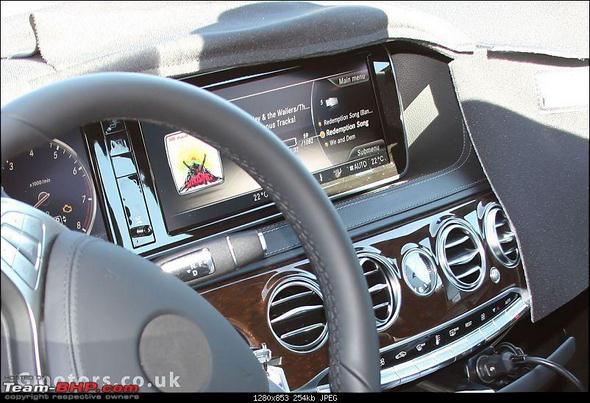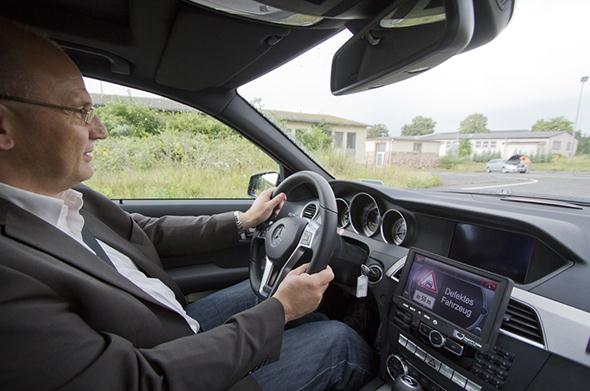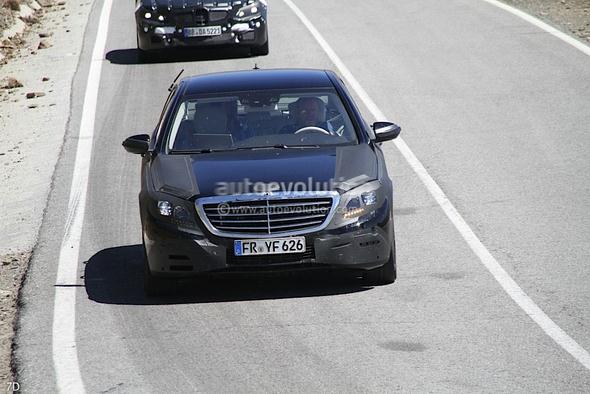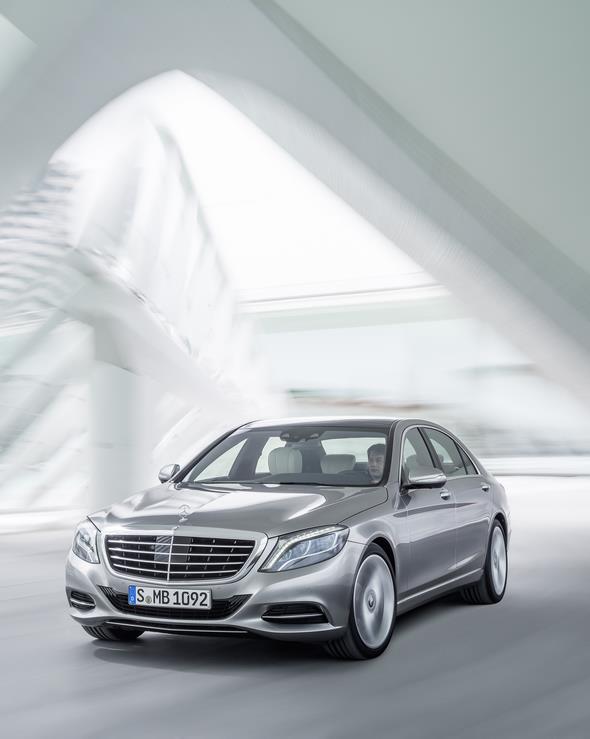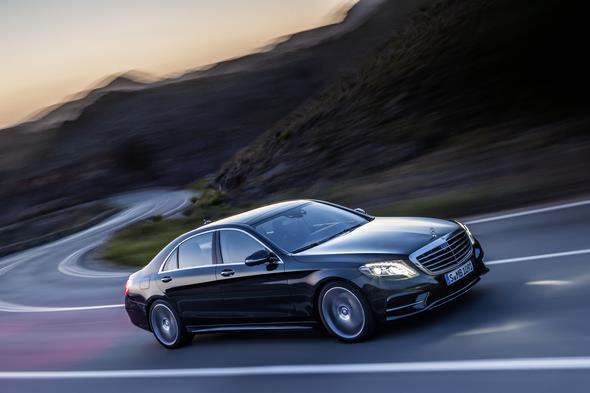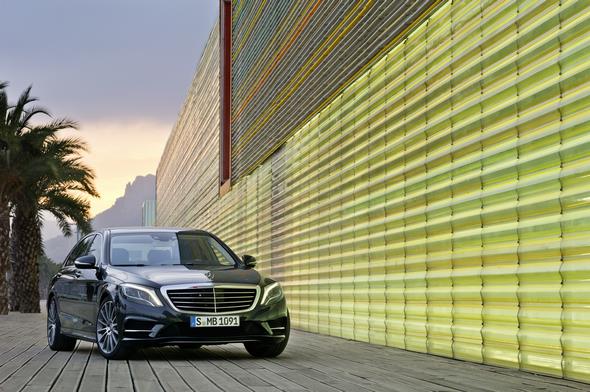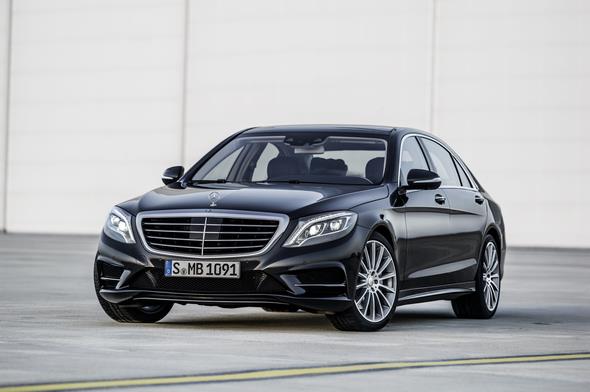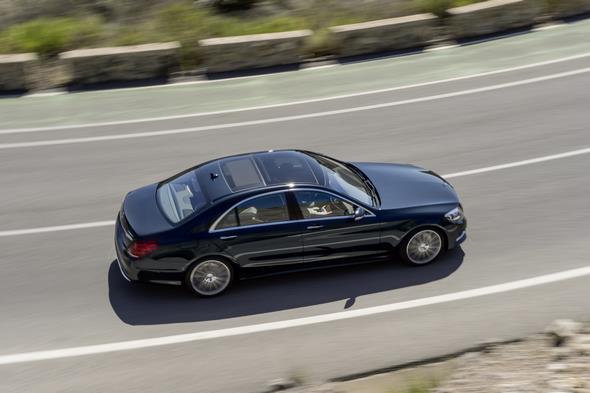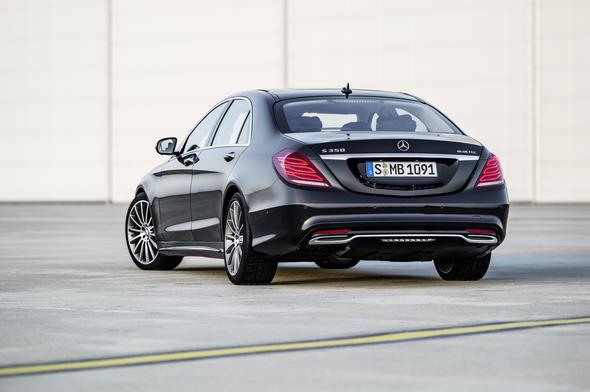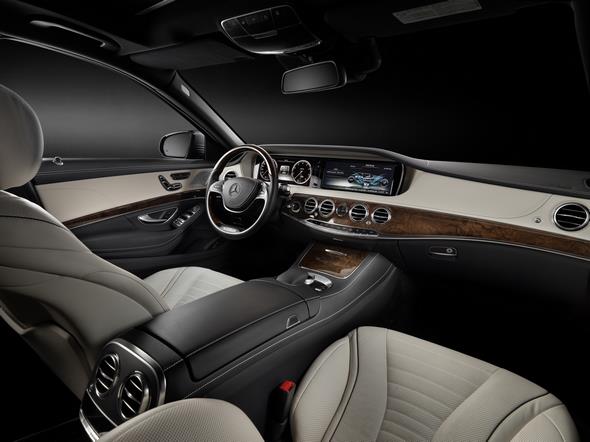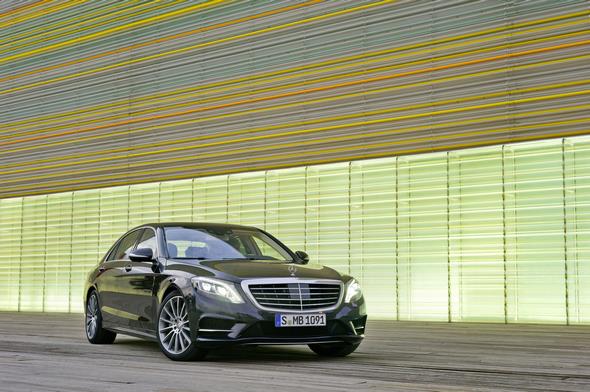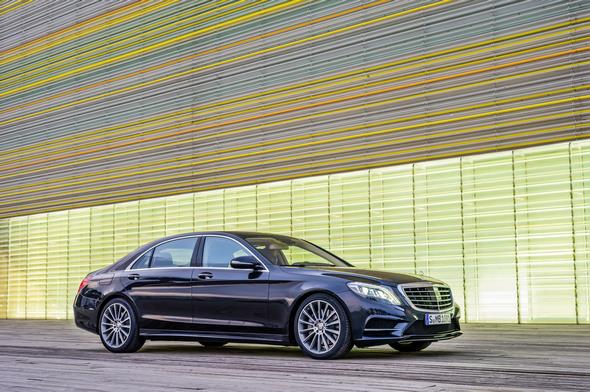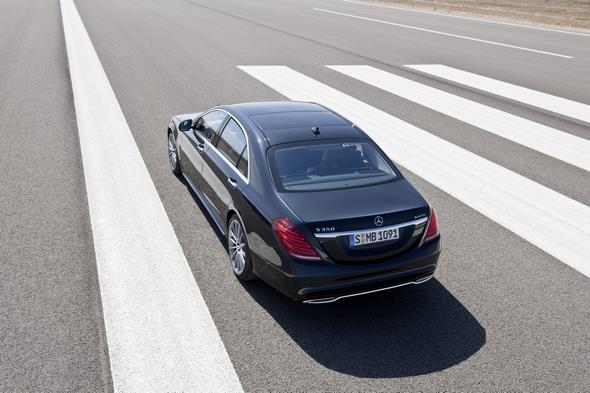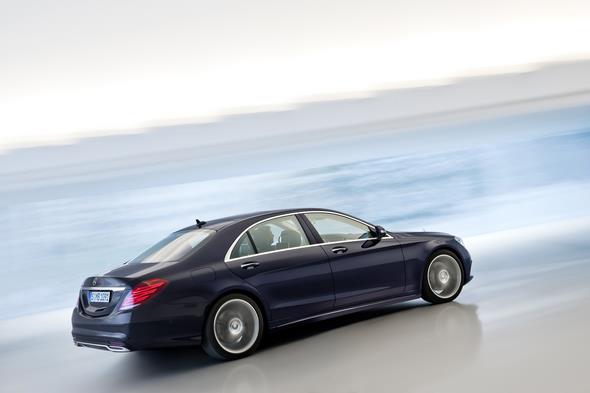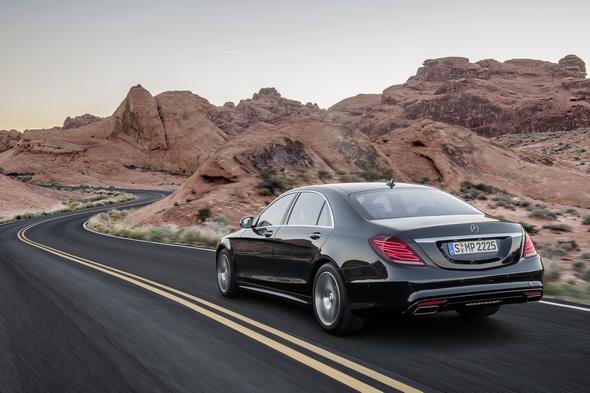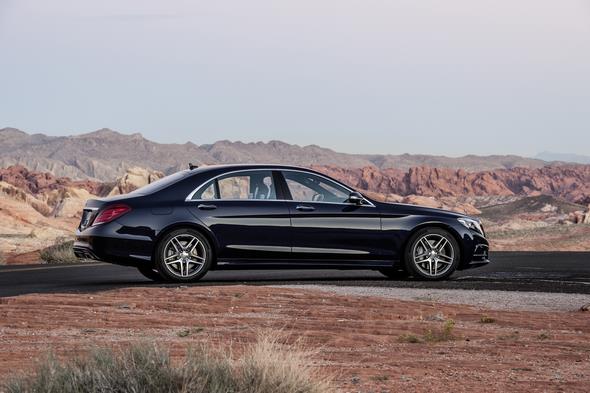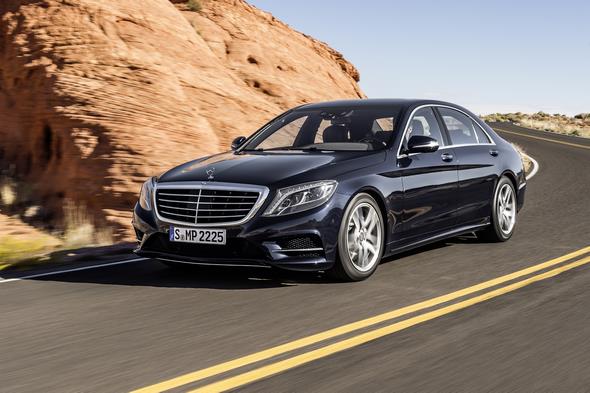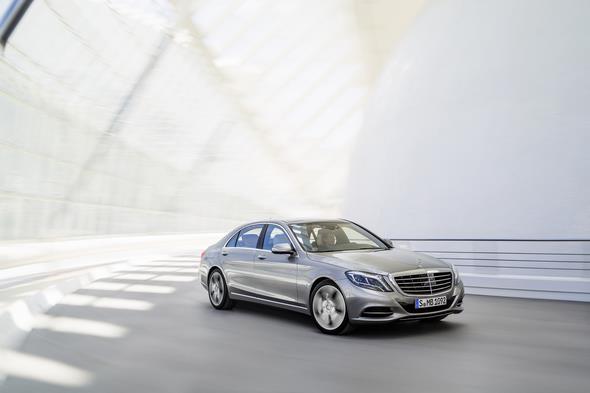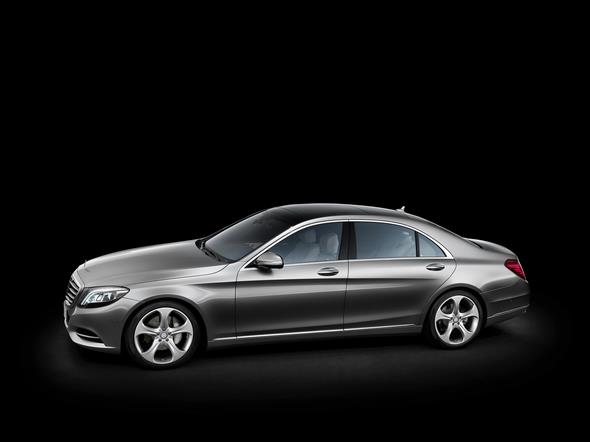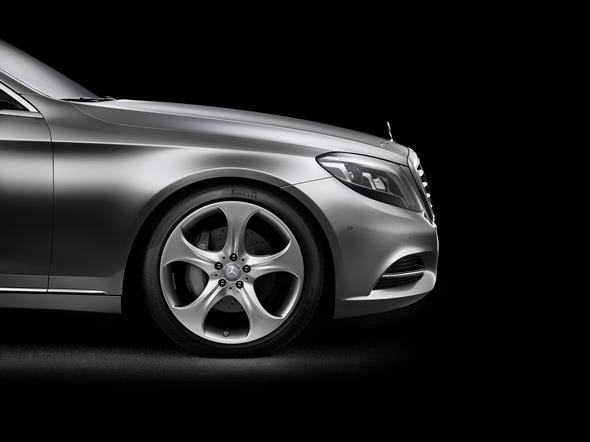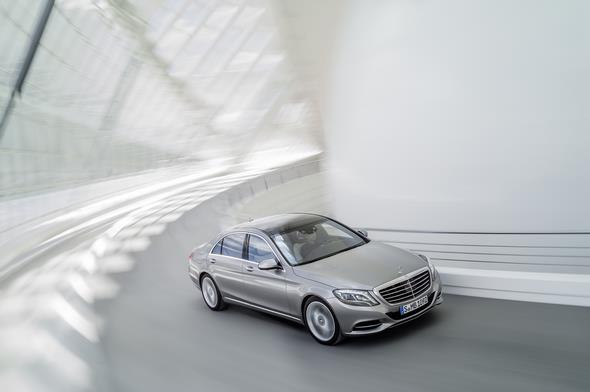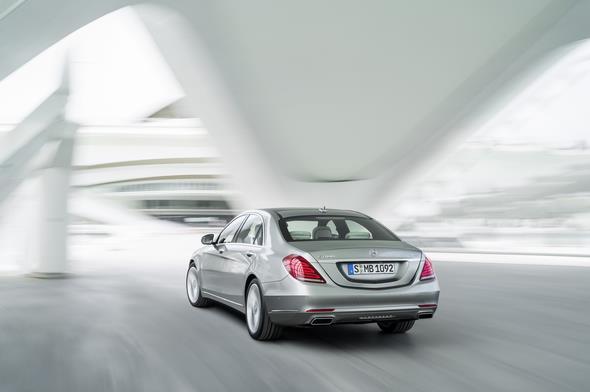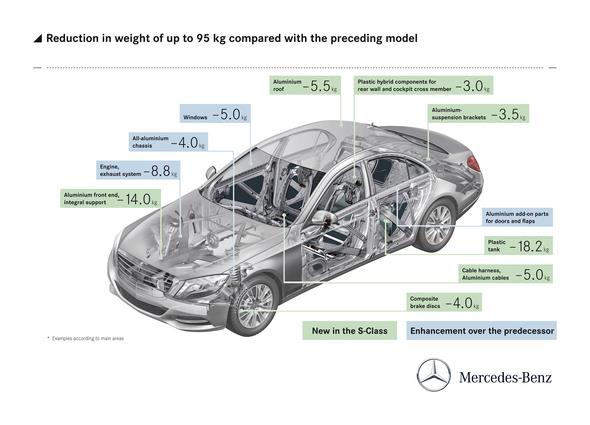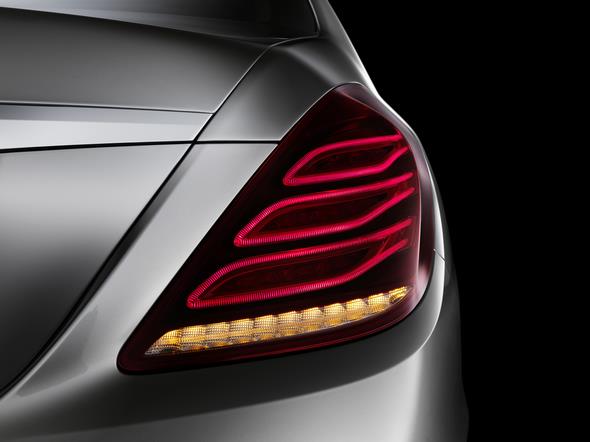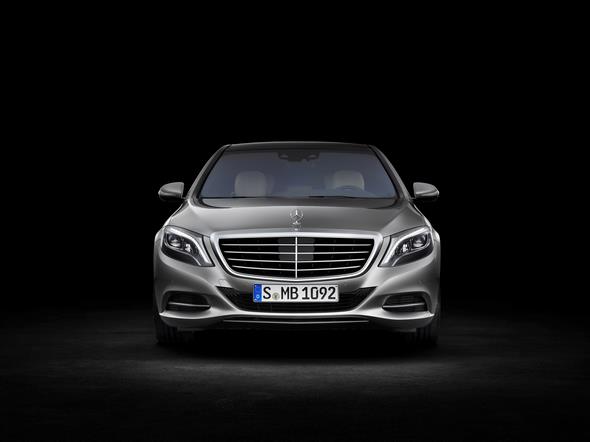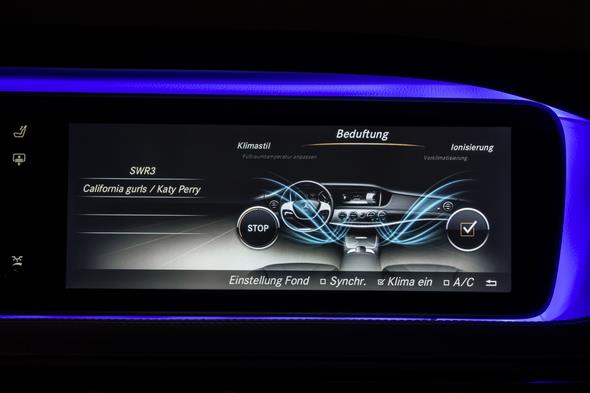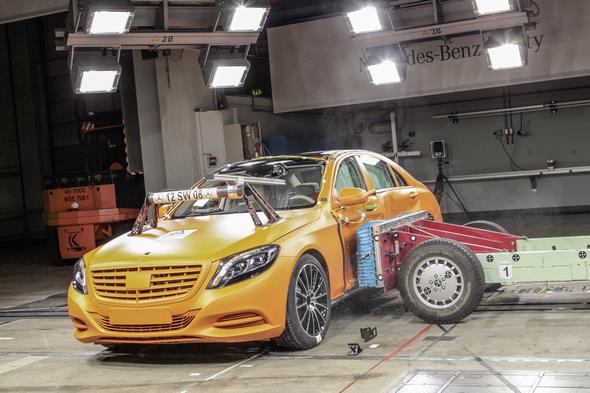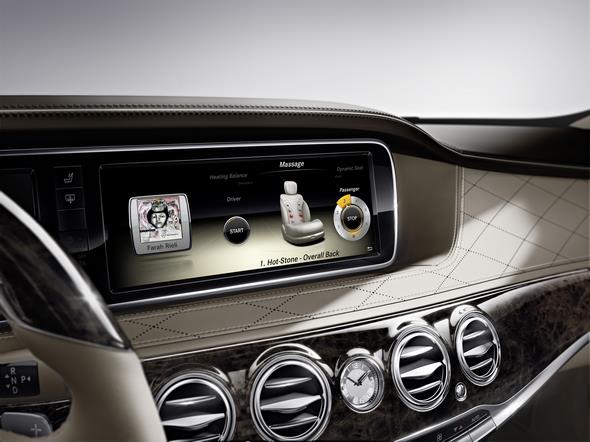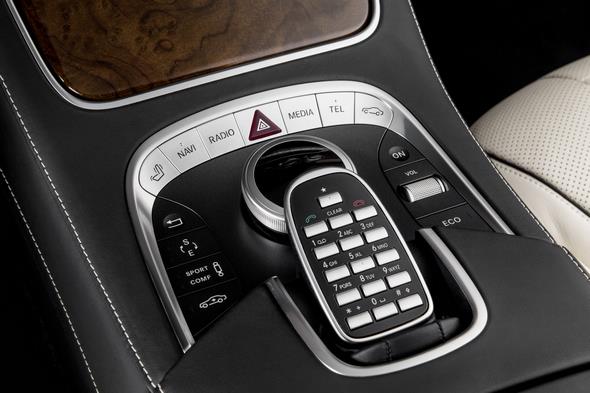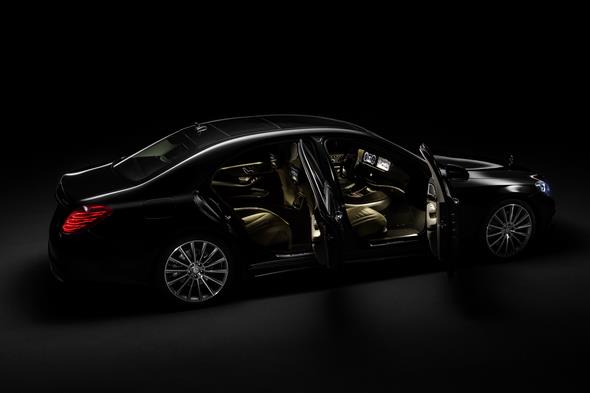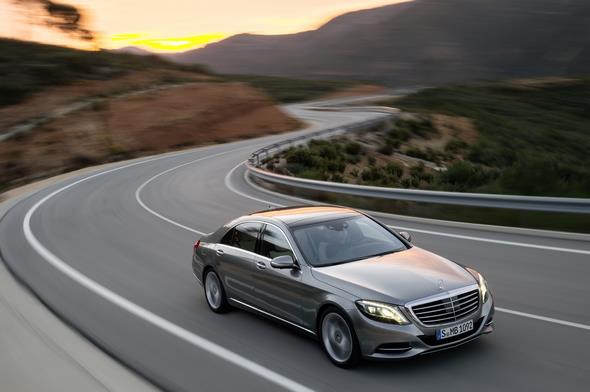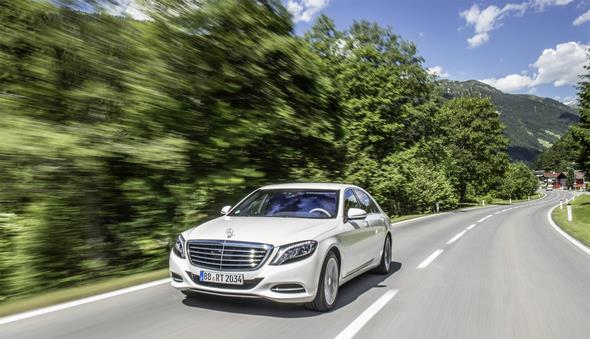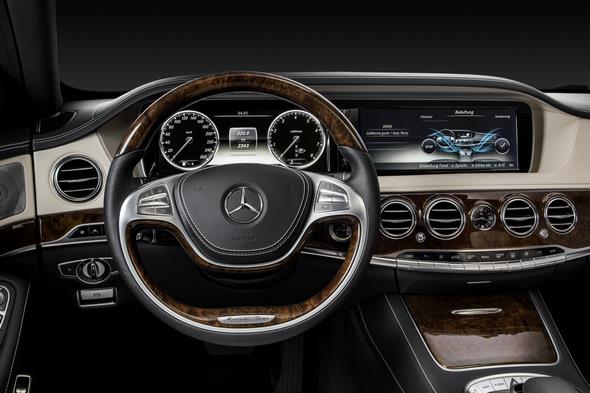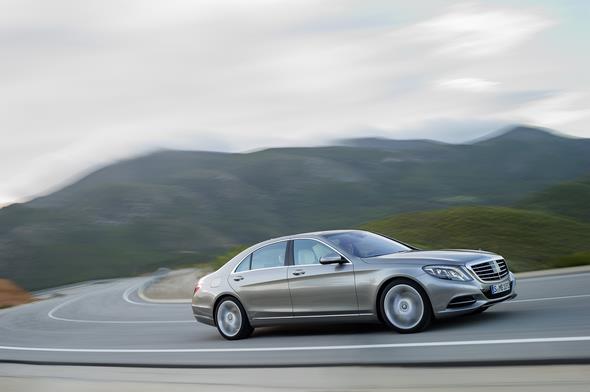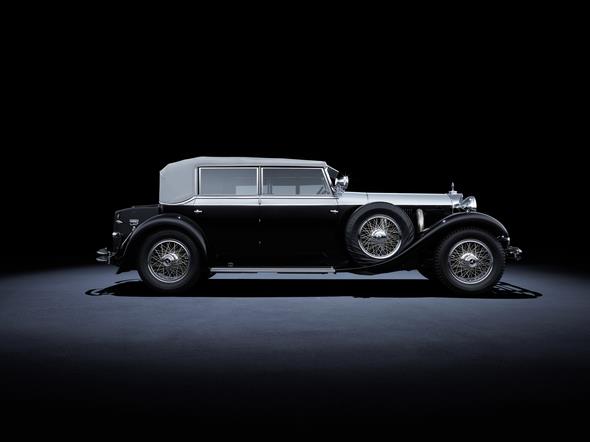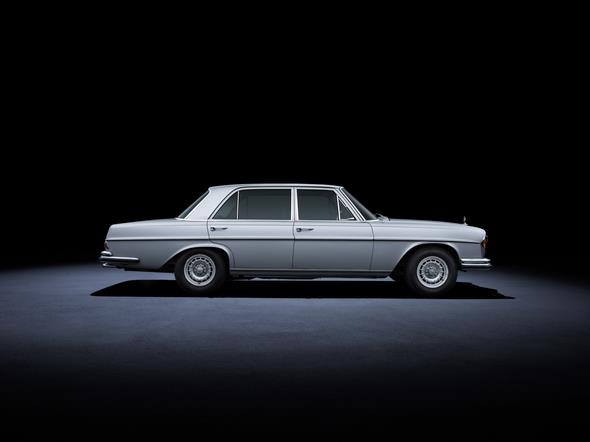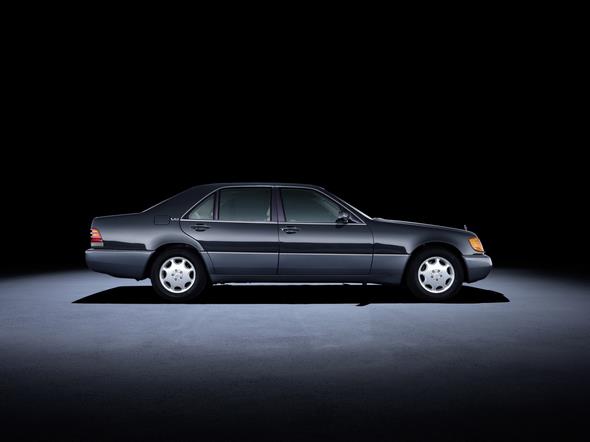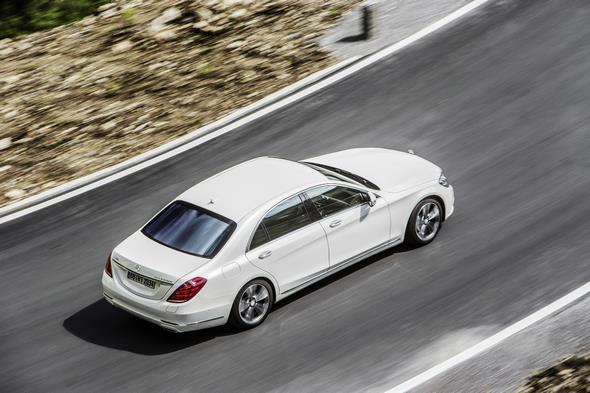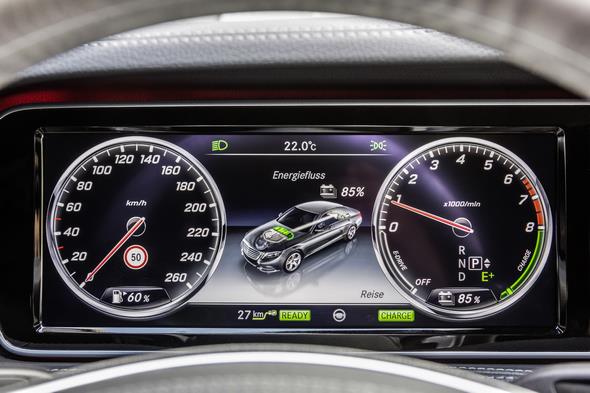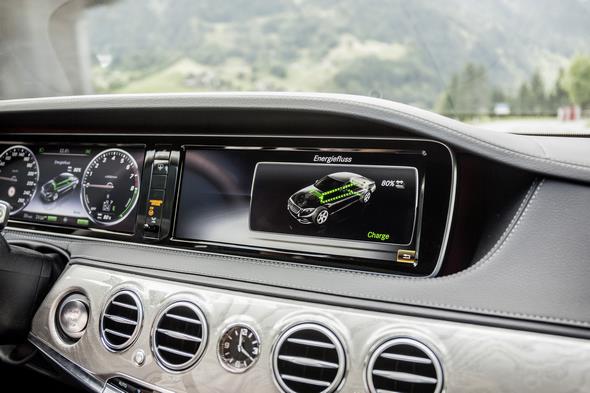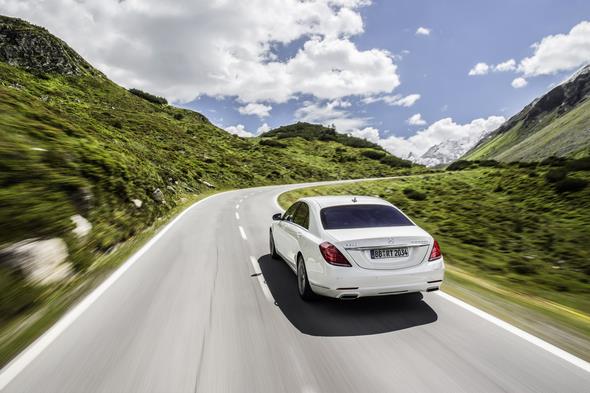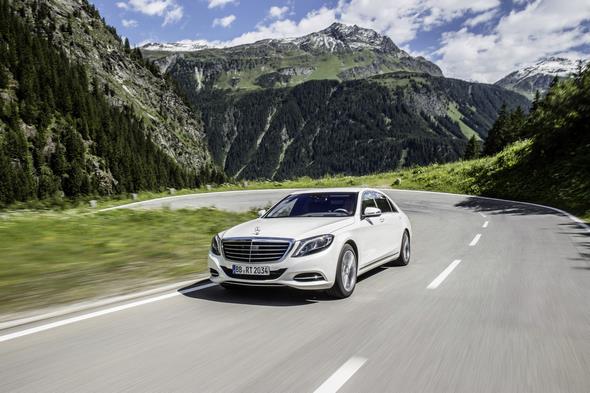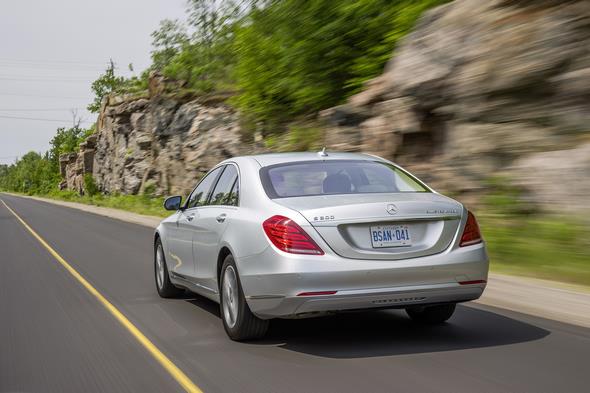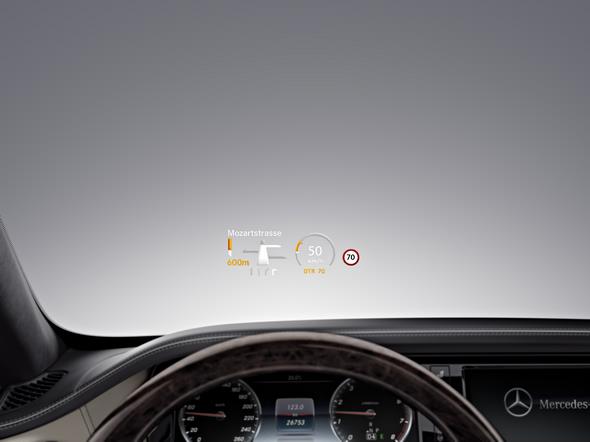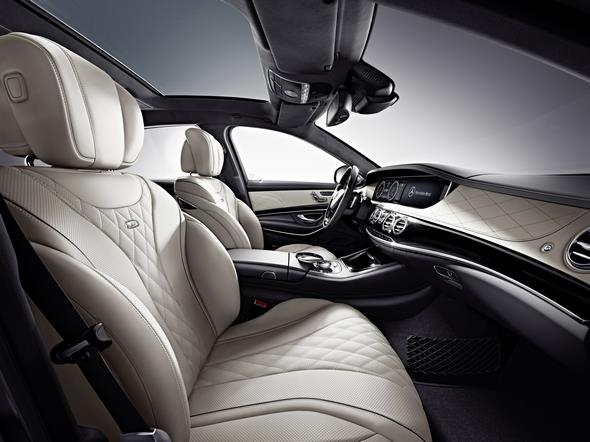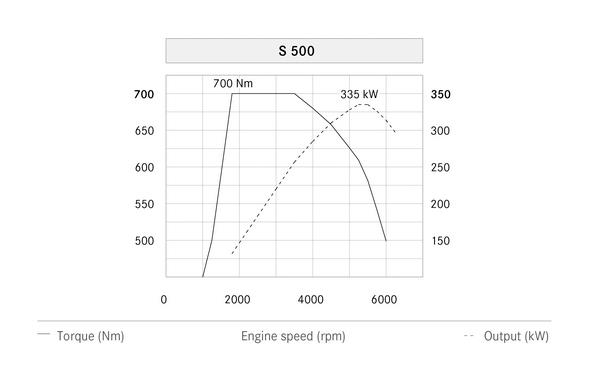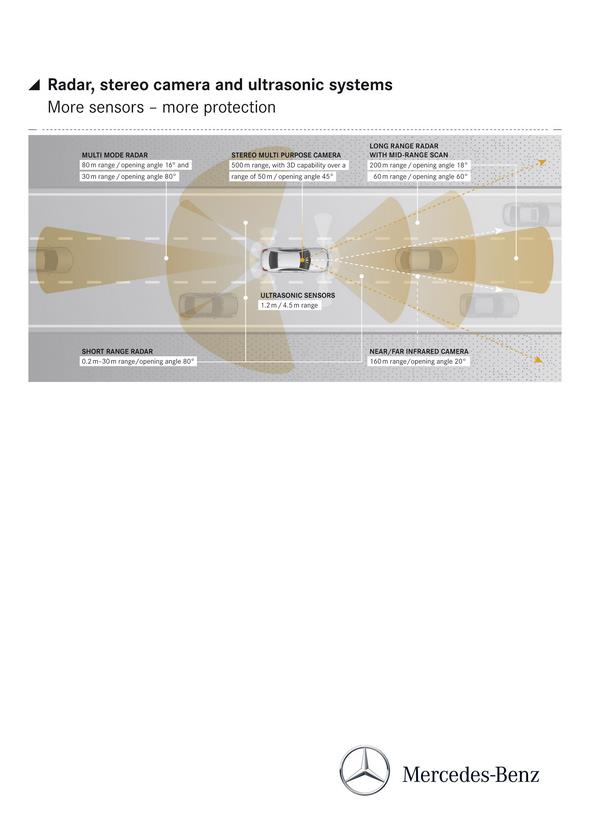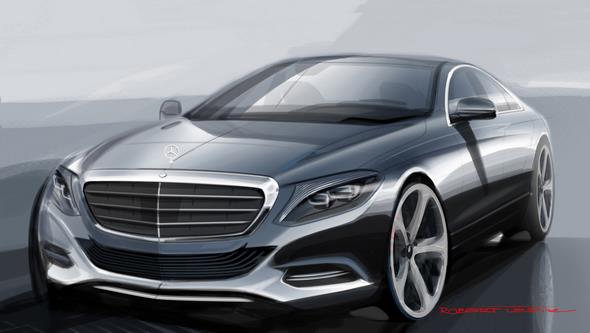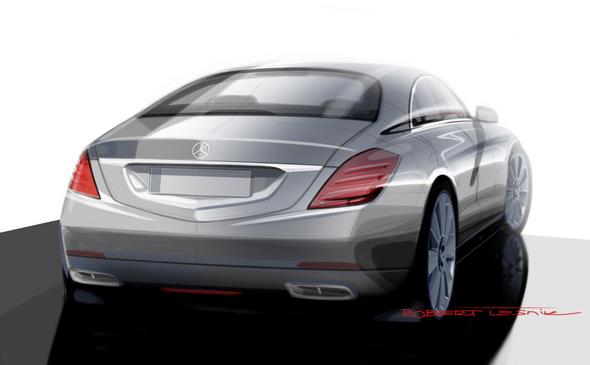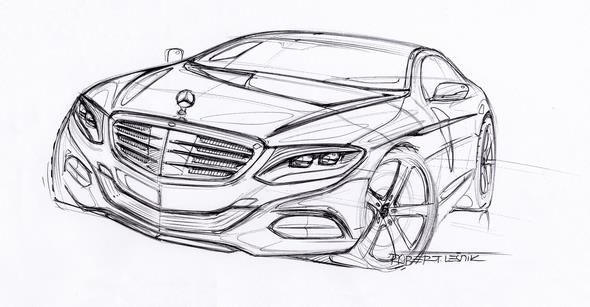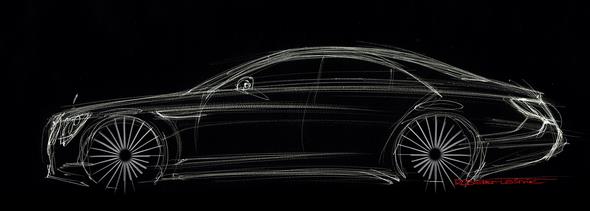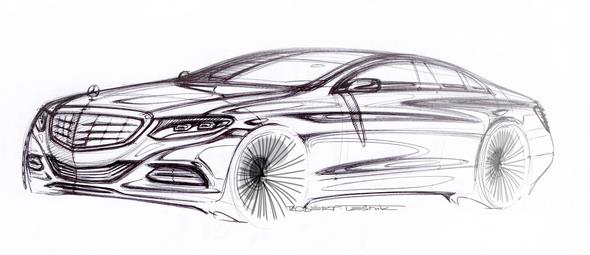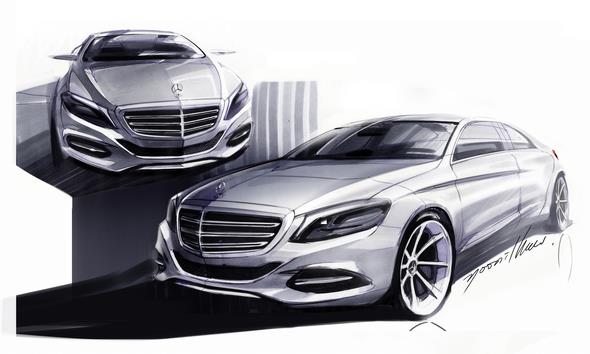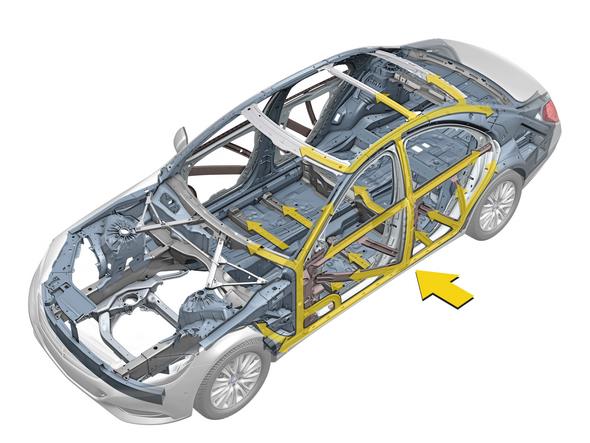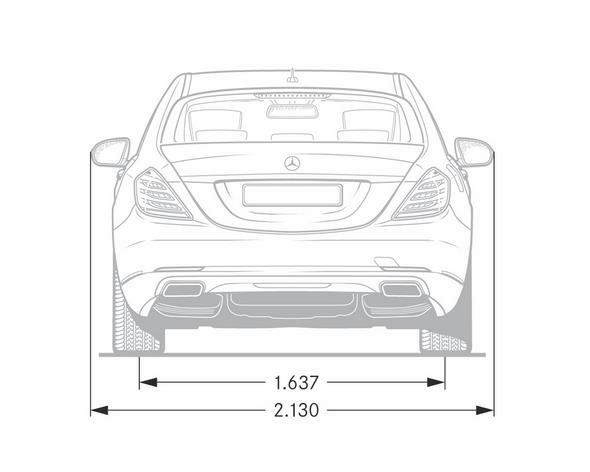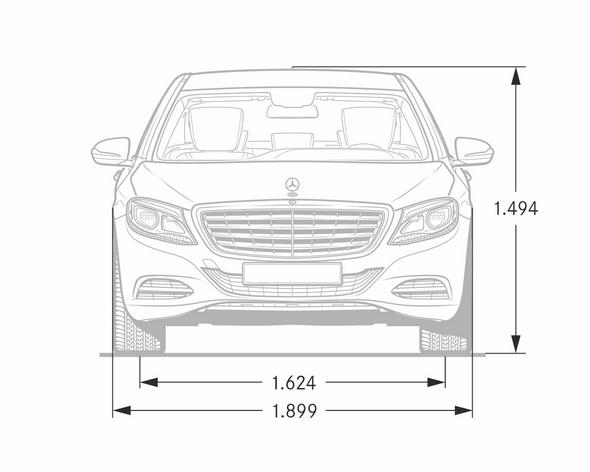Mercedes W222 S-Class 2014 –

The new Mercedes-Benz S-Class

The aspiration: the best automobile in the world
With the three engineering priorities “Intelligent Drive”, “Efficient Technology” and “Essence of Luxury”, the new S‑Class extends the boundaries of technology on many levels.
The S‑Class isnot just a technological spearhead for Mercedes-Benz but for automotive development as a whole.

As with every generation before it, the customers expect the new S-Class toset standards across the board to retain its accolade as “the best automobilein the world”.
Dr Dieter Zetsche, Chairman of the Board of Management of Daimler AG and Head of Mercedes-Benz Cars:
“Rather than being about safety or aesthetics, power or efficiency, comfort or dynamism, our aspirations were ‘the best or nothing’ in every respect. No other car stands for the Mercedes-Benz brand promise more than the S-Class.”
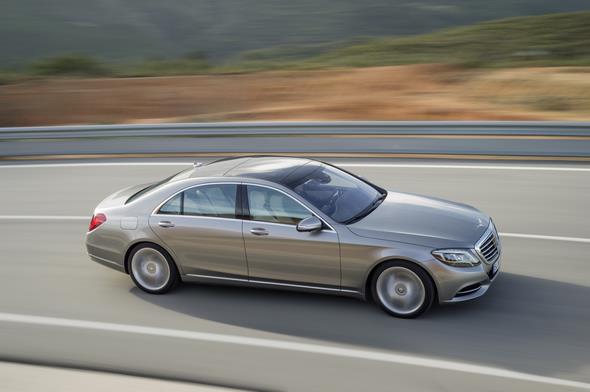
Perfection to the last detail results in “The Essence of Luxury”. This pursuit of the best is particularly noticeable in the interior: whether it is the seats or the air conditioning, the controls or the design, the infotainment or the comfort
and safety in the rear – new ideas, their painstaking realisation, and highest perceived quality underpin the high standards that the engineers have setfor the Mercedes-Benz flagship model – and for themselves.
The same applies to safety. What started with PRE-SAFE® ten years ago and continued with DISTRONIC PLUS has now resulted in a new dimension of motoring: comfort and safety are merged into one.
Mercedes-Benz refers to this as “Intelligent Drive”. A whole host of new systems makes the new S-Class even more comfortable and even safer.

The S-Class is so efficient that it almost sounds utopian: within ten years Mercedes-Benz, by realising “Efficient Technology”, has almost halved fuel consumption in the 150 kW output category to 4.4 litres per 100 kilometres, for example, while the drag coefficient of the new S-Class (cd=0.24) clearly undercuts the previous model’s figure and sets a new benchmark in this segment.
The S 300 BlueTEC HYBRID is set to go even lower still with acd figure of 0.23 thanks to additional aerodynamic optimisation measures.
Furthermore, the new model is the world’s first car to dispense entirely with light bulbs in favour of LEDs, pointing the way ahead once again.
Design: a modern sense of status and sensual shapes
People all over the world can recognise a Mercedes-Benz straight away. The classic Mercedes face runs like a golden thread through the brand’s history.
“The sophisticated design of the S-Class has always been an expression of luxury and automotive grandeur of its era. And our new S-Class continues this tradition.
With its classic architecture and flowing silhouette, it is a modern embodiment of sensual clarity.
The design draws a line from the sophisticated, progressive design idiom to the classic elegance of our 1930s cars – intelligence that speaks to the emotions.
Stylish sportiness and sensual forms in synthesis with timeless clarity and effortless superiority make the S-Class a true design icon,” says design chief Gorden Wagener.
To underline the effortless superiority of the new S-Class, and its ambition to lead, the radiator grille is now larger, upright and distinctly three-dimensional in design.
With its long bonnet, the flowing, domed roof line and the gently slanting rear end, the new S-Class has classic saloon proportions.
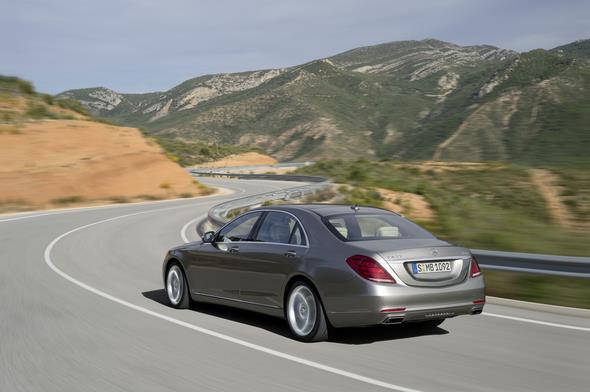
The size and space have been fashioned in such a way that the S-Class appears prestigious, and the powerful roof line is also in keeping with the car’s sporty coupé-style intentions.
A character line descending discreetly from front to rear – the brand’s hallmark “Dropping Line” – elegantly structures the side wall and generates additional dynamism even when the car is at a standstill.
The subtly created convex-concave effect of the entire flank gives rise to an extremely powerful and elongated car body that demonstrates both excitement and calm.
The pronounced shoulder above the rear wheel adds further emphasis to the car’s athletic character.
The positively exaggerated surfaces and lines of the side wall on the newS-Class generate excitement as they flow into the rear end. As well as being elegant, the slightly slanting form has aerodynamic advantages.
Horizontal lines running from the boot lid to the bumper emphasise the car’s width when viewed from the rear.
The hallmark signature of the Mercedes-Benz designers can also be seen in the rear windscreen, which cuts into the C-pillars.
The upper area of the glass is rounded, lending it a coupé-like character.
The real highlights are the new-style tail lights which are completely encased by the car body and, thanks to this solitarily integrated styling and meticulously crafted inner workings, complete the design right down to the last detail.
LED technology: the first ever car without a single light bulb
100 years or so after the introduction of electric lighting in motor vehicles, Mercedes-Benz is now making a complete switch to LED technology – the new S-Class is the first vehicle in the world whose interior and exterior do without a single light bulb, and sees Mercedes-Benz building on its pioneering role in the lighting sector.
The lighting’s multi-level functionality is another world first: out of consideration for any road users behind, the intensity of the brake lights is reduced at night or while waiting at traffic lights, for example.
Almost500 LEDs illuminate the road, the vehicle, the interior and the boot. Depending on equipment, these include:
- Headlamps: each with up to 56 LEDs
- Tail lights: each with up to 35 LEDs (plus 4 for the rear fog lamp)
- Interior (including ambient lighting): approx. 300 LEDs
Visibility is enhanced by two assistance systems that have undergone some key improvements – Adaptive Highbeam Assist Plus and Night View Assist Plus.
Thanks to a new stereo camera and multistage radar sensors, the S-Class has 360-degree all-round vision and detects potential dangers on the road better.

Drive system: class-leading efficiency in every output category
In its first year the new S-Class line-up features two hybrid versions, a petrol model and a diesel variant: S 400 HYBRID, S 500, S 350 BlueTEC and S 300 BlueTEC HYBRID.
All models boast class-leading efficiency and up to 20 percent lower fuel consumption than the outgoing model series. All the engines already meet the requirements of the Euro-6 emissions standard.
In addition to this, the S 400 HYBRID and S 350 BlueTEC meet the strict criteria of efficiency class A, while the S 300 BlueTEC HYBRID even has an A+ rating.
“The new S-Class achieves consumption and emissions figures that only a few years ago seemed utopian, even for executive cars,” says Prof. Thomas Weber, member of the Daimler Board of Management responsible for Group Research and Head of Mercedes-Benz Cars Development.
“And this is just the start of our ‘Green Leadership’ initiative: soon to be followed by the S 500 Plug-In HYBRID – the first S-Class with a fuel consumption lower than four litres per100 kilometres.”
The S-Class line-up therefore includes the full range from petrol and diesel models to petrol, diesel and plug-in hybrids for the first time.
Model data at a glance:
| Model | S 400 HYBRID | S 500 | S 350 BlueTEC | S 300 BlueTEC HYBRID |
| Number of cylinders/arrangement | 6/V | 8/V | 6/V | 4/in-line |
| Displacement (cc) | 3498 | 4663 | 2987 | 2143 |
| Rated output (kW/hp at rpm) | 225/306 at 6500 | 335/455 at 5250 | 190/258 at 3600 | 150/204 at 4200 |
| Rated output of electric motor (kW) | 20 | – | – | 20 |
| Rated torque (Nm at rpm) | 370 at 3500-5250 | 700 at 1800-3500 | 620 at 1600-2400 | 500 at 1600-1800 |
| Rated torque of electric motor (Nm) | 250 | – | – | 250 |
| Combined fuel consumption from (l/100 km) | 6.3 | 8.6 | 5.5/5.61 | 4.4 |
| Combined CO2 emissions from (g/km) | 147 | 199 | 146/1481 | 115 |
| Efficiency class | A | D | A | A+ |
| Acceleration 0-100 km/h (s) | 6.8 | 4.8 | 6.8 | 7.6 |
| Top speed (km/h) | 250 | 250 | 250 | 240 |
1 Figures for short/long wheelbase
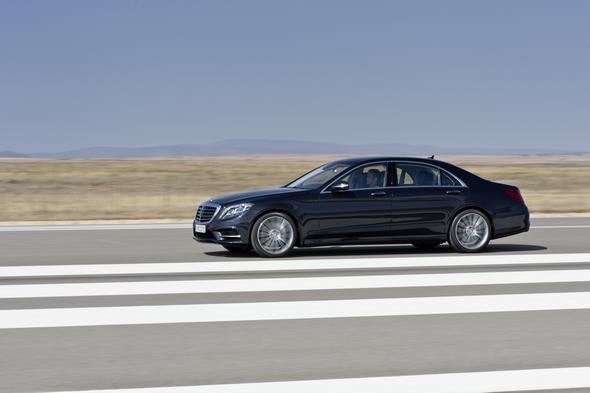
Suspension: the world’s first suspension with “eyes”
The new S-Class is the world’s first car to be able to detect bumps on the road ahead. If ROAD SURFACE SCAN detects such unevenness by means of the stereo camera, MAGIC BODY CONTROL instantaneously sets up the suspension to deal with the new situation.
This innovative suspension system is available as an option for the eight-cylinder models.
Standard equipment for the new S-Class includes the continuously operating Adaptive Damping System ADS PLUS and an enhanced version of the full air suspension system AIRMATIC.
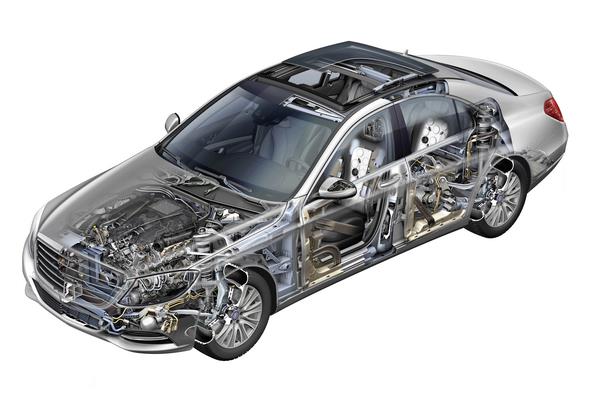
Interior: visual breadth and calm solidity
With its clear architecture, the interior design of the S-Class embodies a classic, superior, cutting-edge saloon.
The interior’s expressive character derives from a uniquely fluid, sensuously elegant style.
Horizontal elements and lines create a setting characterised by visual breadth and calm solidity.
High quality and elegance harmonise with clarity and functionality: the interior design of the S-Class combines ride comfort, spaciousness and user-friendliness to the very highest standard.
The perfectly coordinated use of materials and colours produces an exclusive interior seemingly cast from a single mould.
There is generous use of wood trim, especially in the dashboard and centre console.
Metallised switch surfaces with pearl-effect paint finishes in three colour shades to suit the interior colour particularly highlight the outstanding quality.
Passengers in the rear are also seated in first-class – the design and exclusivity of the seats, door panels and all controls are to the same, high standard as the front.
As an additional individualisation feature, the “First Class Rear” incorporates a Business centre console combining personal comfort with practical convenience (integration of a telephone handset, additional stowage compartments, folding table, etc.).
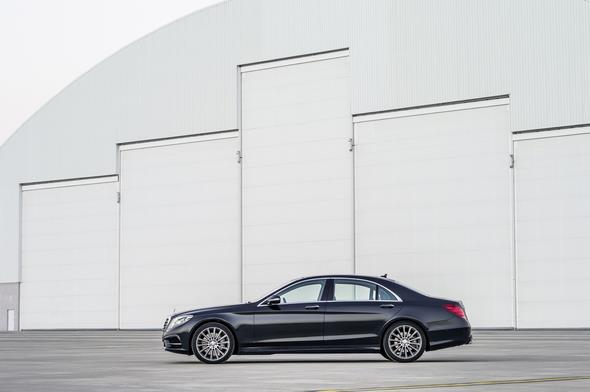
Concept: the best for both worlds
For the first time in the history of the S-Class, the development focus was on the long-wheelbase Saloon. Unlike before, the short-wheelbase version was derived from this.
This is because the S-Class is not only firmly positioned as a prestige saloon in the large overseas markets such as the USA, China or Japan.
Whereas in Europe and North America owners of an S-Class are frequently behind the wheel themselves, the flagship model in the Mercedes-Benz passenger-car portfolio is very definitely a chauffeur-driven vehicle in Asia.
The logical consequence is the number of new features specifically related to comfort and safety in the rear – in the S-Class, there is no doubt that passengers in the rear are also seated in first class.
The occupants of the new S-Class benefit from the moderate increase in vehicle size by an improvement in all the interior dimensions: there are 12 millimetres of extra headroom for the driver, as well as 14 millimetres more shoulder room and 10 millimetres more elbow room in the front.
Thanks to the 14-millimetre increase in rear kneeroom, travel becomes even more comfortable for passengers in the rear. Shoulder room in the rear has been improved by up to nine millimetres.

Control and display concept: elegant new command centre
Two high-resolution TFT colour displays in 8:3 format with a screen diagonal of 30.7 cm (12.3 inches) form the new information centre in the S-Class.
The left-hand display performs the functions of the previous instrument cluster, providing the driver with all relevant information.
The right-hand display allows the convenient control of infotainment and comfort functions.
For the new S-Class, the constantly increasing need to integrate additional functions into the vehicle led to a further development of the entire operating logic.
Here ergonomics, operating convenience and safety along with attractiveness and aesthetics were the main considerations.
The aim in designing the control and display features was to group controls and display functions together in a coherent manner in terms of both design and functionality.
Apart from the new displays, the metallised switch surfaces and solid aluminium controls are visual highlights of particularly high quality.
Thanks to the fine structuring on the metal surfaces, each individual control has the sound, feel and attention to detail that makes a Mercedes-Benz so special.
The new control features include a touch-sensitive telephone keypad and an extended favourites function with twelve freely selectable memory places.
The principal control element is the rotary pushbutton, with the usual direct access keys in the centre console for the most important functions and a toolbar for the driving assistance systems.
Voice entry using LINGUATRONIC via the Speech Dialog System allows complete addresses to be spoken in one go, for example (one-shot input).
The telephone and audio systems can also be voice-controlled. The option of having text messages (SMS) or emails read out is a new feature.
Climate control: a wealth of new features for a pleasant atmosphere
During the systematic further development of the entire climate control system, a particular focus was placed on the development goals of performance, air quality, precise regulation, noise level and efficiency.
As a new feature, the AIR-BALANCE package comprises perfume atomisation, ionisation and even more efficient filtration compared with the standard model.
The THERMOTRONIC automatic climate control in the rear has two additional zones to improve thermal comfort. Electric heating of the armrests is a completely new feature.
As a world first, the new S-Class Saloon has an “active perfuming system” as part of the AIR-BALANCE package.
‘Active’ means that the perfuming system is switched on and off manually, with manual adjustment of the intensity.
The perfume atomisation system individualises the smell of the vehicle interior.
It neither changes the interior smell permanently, nor are perfume molecules deposited on fabric surfaces or clothing. The fragrance is discreet and mild, and dissipates rapidly.
Seats: mobile office and centre of wellbeing
With numerous world firsts such as the ENERGIZING massage function based on the hot-stone principle or active seat ventilation with reversing fans, Mercedes-Benz has raised seating and climatic comfort in the S-Class to a new level.
The seat developers have paid particular attention to the rear seats. There is a choice of five different rear seat variants including an Executive seat with a backrest angle adjustable by up to 43.5 degrees, allowing occupants in the rear to concentrate on work or relax in comfort.
The ENERGIZING massage function on the hot-stone principle is a world first.
The seat specialists at Mercedes-Benz have developed a unique massage function with 14 separately actuated air cushions in the backrest, as well as an integrated warming function.
There is a choice of six massage programmes, two of them using the warming function. The function is also available for the rear seats.
For the first time, so-called reversing fans are used in the active seat ventilation system.
When the ventilation function starts, cooler surrounding air is first drawn onto the seat surface.
This enables the surface temperature of a heated-up seat to be reduced much faster than with the previous active cooling systems.
After four minutes the fans are automatically switched to blower mode to reduce draughts.
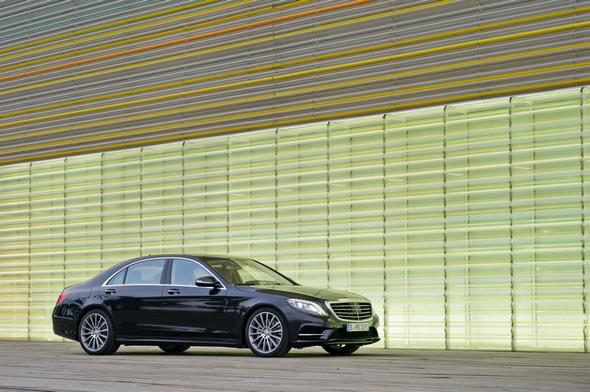
Two rear seat variants (static bench seat or individual seats with 37-degree adjustment) are available for the standard-wheelbase S-Class, and no less than five for the long-wheelbase version.
The adjustment kinematics have been changed in the luxury and reclining seat variants.
Unlike the conventional trailing backrest design, the backrest is adjusted separately so that the legroom and seat reference point remain unchanged.
The cushion can be separately adjusted for angle and horizontal position.
The maximum backrest angle of the Executive seat (reclining seat) behind the front passenger seat is increased from 37 to 43.5 degrees, giving it the largest backrest inclination in the luxury segment.
The reclining seat features a calf support which is freely adjustable for length and angle.
In combination with the heel rest on the folding chauffeur seat at the front and an additional comfort cushion, this allows a reclined position that sets new standards in the automotive sector with respect to sleeping and resting comfort.
If the “First Class Rear” is specified (with rear centre console), the front console on the transmission tunnel is visually continued to the rear.
It is equipped with innovative thermo-cup holders which use Peltier technology to cool or warm drinks over a longer period of time.
Like an aircraft seat, the centre console is available with two tables which can be easily folded in or out using one hand.
Multimedia features: mobile concert hall
A completely new multimedia generation with intuitive operation and particularly tangible functions thanks to visualisation and animations celebrates its debut in the S-Class.
Other innovations include the multi-user system, which allows independent access to the media sources of the entertainment system from any seat.
The innovative Frontbass system developed by Mercedes-Benz‑and used for the first time in a saloon car is a feature common to all the audio systems: the woofers are housed in the firewall, and use the almost 40-litre space in the cross-member and side member as a resonance chamber.
Conventional woofers in the doors are therefore unnecessary. The mid-range speakers in the doors are relocated upwards.
This improves the soundscape and allows additional stowage space in the doors.
As alternatives to the standard sound system with ten loudspeakers, two very high-quality audio systems are available which were developed together with the high-end audio specialist Burmester: the Burmester® Surround Sound system and the Burmester® High-End 3D‑Surround Sound system.
The interactive presentation of content is a prominent new feature of the navigation function.
The new navitainment functions include an animated compass, the “Driveshow” for passenger information as in an aircraft, and the display of Google Maps on the head unit and in the rear.
Information on the traffic situation is shown with hatched lines (rather than with vehicle silhouettes as before).
With the new Live Traffic Information service, traffic data is transmitted in real time.
As a result, the navigation system is better informed about the situation on the roads.

Body: maximum stability and high-quality lightweight design
A high level of crash safety, outstanding rigidity for excellent handling with extremely low levels of noise and vibration. These were the aims when developing the bodyshell for the new S-Class – a third-generation aluminium hybrid bodyshell.
The lightweight index – the torsional stiffness in relation to weight and vehicle size – has been improved by 50 percent compared to the predecessor model.
Since the 220 model series was developed in the 1990s, with an optimally coordinated materials mix the hybrid lightweight construction has been further developed into an aluminium hybrid bodyshell.
During this period the share of aluminium has increased to more than 50 percent.
It has therefore been possible to maintain practically the same body weight for 20 years and even slightly reduce it, despite far more stringent comfort and safety requirements and additional functions.
In addition to this, structural foams are used at specific points in node areas in the new model series.
The entire outer skin of the S-Class, including the roof and the front section of the body, consists of aluminium.
The high percentage of aluminium is possible thanks to the use of a complete range of semi-finished products (casting, extrusion, sheet metal).
The safety passenger cell is made using an extremely high percentage of high-strength steel.
This lightweight design by material and geometrical optimisation coupled with highly complex joining technology allows the new S-Class to further raise the bar in the demanding luxury saloon segment – without adding weight.
With a torsional stiffness of 40.5 kN/degree (predecessor: 27.5 kN/degree), the S-Class achieves a new record in its segment.
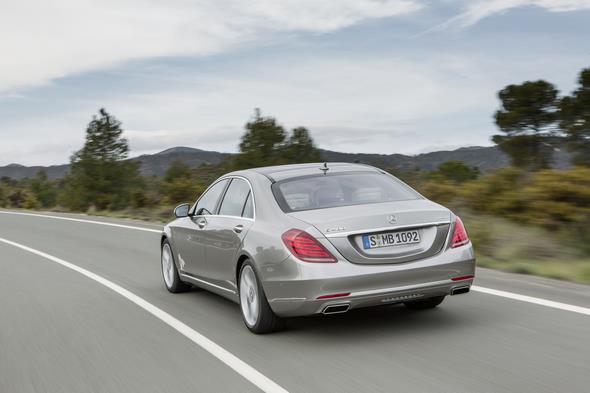
Extended PRE-SAFE® protection: prevention is better than cure
Ten years ago, Mercedes-Benz unveiled a groundbreaking safety concept in the S-Class in the form of the PRE-SAFE® anticipatory occupant protection system, which has been undergoing continuous refinement ever since.
Now, the safety pioneer is increasing protection levels once again.
The new PRE-SAFE® functions can help to prevent collisions with pedestrians and vehicles in front in city traffic, defuse dangerous situations caused by traffic behind and enhance the protection offered by the seat belts.
- The PRE-SAFE® Brake can also detect pedestrians and initiate autonomous braking to avoid a collision at speeds up to 50 km/h.
- PRE-SAFE® PLUS can recognise an imminent rear-end collision and warn the following traffic by activating the rear hazard warning lights at a high frequency. If the danger of a collision persists, the system can also firmly apply the stationary vehicle’s brakes and thus minimise the risk of whiplash injuries by reducing the forward jolt caused by the impact. This additionally can reduce the risk of secondary accidents. Immediately before impact, the PRE-SAFE® anticipatory occupant protection measures, especially the reversible belt tensioners, are deployed.
- With PRE-SAFE® Impulse, the driver and front passenger are pulled away from the direction of impact by their seat belts at an early phase of the crash before the resulting occupant deceleration sets in. This can substantially reduce the risk and severity of injuries in a frontal collision.
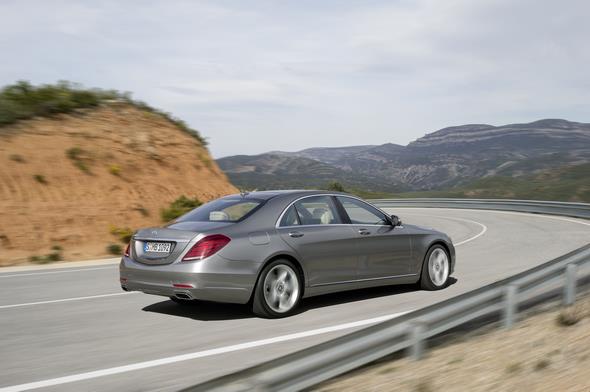
Setting the standard for safety in the rear: new features in the S-Class
Mercedes-Benz has extended the safety system for rear seat passengers further with the seat belt buckle extender, the beltbag and the cushionbag.
The first two of these developments are included in the “PRE-SAFE® rear package”.
With the illuminated seat belt buckle extender, an electric motor extends and retracts the belt buckle automatically.
In this way, any belt slack in the area of the pelvis and thorax can be reduced so that passengers are secured more firmly in both the sideways and the lengthways direction.

The beltbag is an inflatable seat-belt strap that is able to reduce the risk of injury to passengers in the rear in a head-on collision by lessening the strain placed on the ribcage.
The reclining seat is equipped with a cushionbag under the seat cushion upholstery as standard.
When the seat is reclined, it prevents the occupant from sliding beneath the seat belt (so-called submarining) in an accident.
This has enabled Mercedes-Benz to design a comfortable reclining seat which provides a higher level of accident safety than a seat with a trailing backrest.

Intelligent Drive: networked with all senses
Avoid accidents and mitigate their consequences – this is the integrated approach adopted by Mercedes-Benz Accident Research under the heading “Real Life Safety”.
Mercedes-Benz is systematically pursuing this strategy in the S-Class with numerous new assistance systems and greatly enhanced functions.
Comfort and safety are enhanced at the same time. Mercedes-Benz calls this “Intelligent Drive”.
The new functions all rely on the same sensor system, comprising a new stereo camera together with multistage radar sensors.
“Intelligent assistance systems analyse complex situations and better recognise potential dangers out on the road with the aid of improved environment sensor systems,” explains Prof. Thomas Weber, Member of the Daimler Board of Management responsible for Group Research and Head of Mercedes-Benz Cars Development.
“Figuratively speaking, the new S-Class doesn’t just have eyes at the front, it has 360-degree all-round vision.”
A key factor is the networking of all systems, which safety experts call “sensor fusion”.
The aim is to ensure comprehensive protection, not just for the occupants of a Mercedes-Benz, but for all other road users, too.
The support functions range from relieving the burden on the driver and therefore increasing comfort, to issuing visual, acoustic and/or tactile warning signals, to boosting the driver’s reactions.
Some systems are even able to take corrective action in an emergency, such as autonomous application of the brakes to prevent an accident or lessen its severity.

Here is a summary of the new assistance systems and those with notably enhanced functionality:
- DISTRONIC PLUS with Steering Assist and Stop&Go Pilot takes the burden off the driver when it comes to lane guidance and is also able to follow vehicles in traffic jams automatically.
- For the first time, thanks to the stereo camera the Brake Assist system BAS PLUS with Cross-Traffic Assist is able to detect crossing traffic and pedestrians too, and to boost the braking power applied by the driver accordingly.
- If the lane markings are broken lines, Active Lane Keeping Assist can detect when the adjacent lane is occupied, especially by oncoming traffic, and reduce the risk of the vehicle leaving its lane unintentionally by applying the brakes on one side.
- Adaptive Highbeam Assist Plus allows the high-beam headlamps to be kept on permanently without dazzling traffic by masking out other vehicles in the beams’ cone of light.
- Night View Assist Plus was further improved and supplemented by a thermal imaging camera. Night View Assist Plus can alert the driver to the potential danger posed by pedestrians or animals in unlit areas in front of the vehicle by automatically switching from the speedometer
to a crystal-sharp night view image and highlighting the sources of danger. A spotlight function is furthermore able to flash any pedestrians detected ahead. This attracts the driver’s attention to the source of the danger at the same time as warning the person on the side of the road. - ATTENTION ASSIST can warn of inattentiveness and drowsiness in an extended speed range and notify the driver of their current state of fatigue and the driving time since the last break, offers an adjustable sensitivity setting and, if a warning is emitted, indicates nearby service areas in the COMAND navigation system.
The prices in Germany (incl. 19% VAT) for the new S-Class start at 79,789.50 euros for the short-wheelbase S 350 BlueTEC.
The prices at a glance:
| Diesel | Euros | |
| S 350 BlueTEC | Short wheelbase | 79,789.50 |
| S 350 BlueTEC | Long wheelbase | 85,323.00 |
| Petrol | ||
| S 400 HYBRID | Short wheelbase | 85,204.00 |
| S 400 HYBRID | Long wheelbase | 91,094.50 |
| S 500 | Short wheelbase | 104,601.00 |
| S 500 | Long wheelbase | 107,635.50 |
Length/width/height short-wheelbase version: 5116/1899/1483, wheelbase 3035 mm
Length/width/height long-wheelbase version: 5246/1899/1483, wheelbase 3165 mm
The Mercedes-Benz management team on the S-Class
The best or nothing, in every respect
“Rather than being about safety or aesthetics, power or efficiency, comfort or dynamism, our aspirations were ‘the best or nothing’ in every respect. No other car stands for the Mercedes-Benz brand promise more than the S-Class.”
Dr Dieter Zetsche, Chairman of the Board of Management of Daimler AG
and Head of Mercedes-Benz Cars
“A few years ago, the progress made in efficiency would have sounded like a utopian dream: within ten years, Mercedes-Benz has almost halved fuel consumption in the 150 kW output category. Intelligent Drive is likewise leading the way by networking the sensors to enhance comfort and safety.”
Prof Thomas Weber, Member of the Board of Management responsible for Group Research and Head of Mercedes-Benz Cars Development
“The S-Class is not just the spearhead for Mercedes-Benz but for automotive development as a whole. And it has been for decades. That’s why the S-Class is also the world’s best-selling luxury car.”
Dr Joachim Schmidt, Executive Vice President of Mercedes-Benz Cars,
Sales and Marketing
“The features of the style-defining front design are both simple and complex, especially on the S-Class: it is strong in character and unmistakable and, instead of following fads, it exudes confidence and status. Dynamic yet not aggressive, sophisticated yet not fancy.”
Gorden Wagener, Vice President Design, Daimler AG
Exterior design
Modern sense of status, sensual shapes and stylish sportiness
People all over the world can recognise a Mercedes-Benz straight away. The classic Mercedes face runs like a golden thread through the brand’s history.
The features of the style-defining front design are both simple and complex, especially on the S-Class: it is strong in character and unmistakable and, instead of following fads, it exudes confidence and status.
An alpha leader, dynamic yet not aggressive, sophisticated yet not fancy.
To underline the effortless superiority of the new S-Class, and its ambition to lead, the radiator grille is now larger, upright and distinctly three-dimensional in design.
The four louvres taper outwards and do not touch the chrome frame. Instead of diamond-shaped perforations, the lower air intake now features tiny louvres in high-gloss black, which follow the shape of the grille.
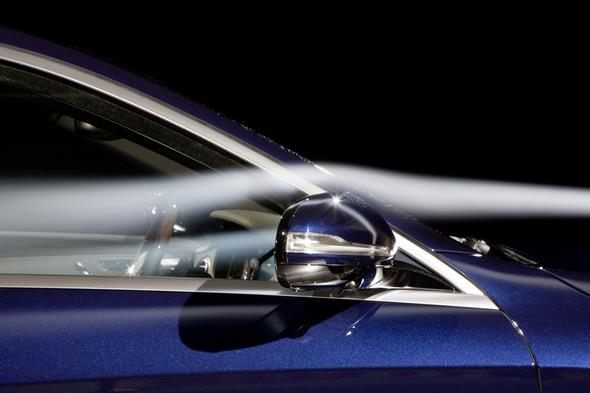
The front-end design is completed by a chrome strip on the lower part of the bumper.
The headlamps have clearly defined contours. In the case of the dynamic LED High Performance headlamps with Intelligent Light System (optional), the indicators, side lights and daytime running lamps are arranged behind the lens so that the brand’s hallmark “torch” is immediately recognisable both day and night.
The Mercedes-Benz lettering in the headlamp is illuminated.
The greater need for passive and active pedestrian protection has likewise been taken into account in the front design.
The additionally required crash gaps have been ideally configured to lend the front end greater presence and a more dominant feel.
The side: powerful, elongated body
With its long bonnet, the flowing, domed roof line and the gently slanting rear end, the new S-Class has classic saloon proportions.
The size and space have been fashioned in such a way that the new S-Class appears prestigious, and the powerful roof line is also in keeping with the car’s sporty coupé-style intentions.
A character line descending discreetly from front to rear – the brand’s hallmark “Dropping Line” – elegantly structures the side wall and generates additional dynamism even when the car is at a standstill.
The subtly created convex-concave effect of the entire flank gives rise to an extremely powerful and elongated car body that demonstrates both excitement and calm.
The pronounced shoulder above the rear wheel adds further emphasis to the car’s athletic character.
Every detail and each of the detachable body parts have been stylistically optimised.
The exterior mirrors, for instance, have a new, more dynamic form, while the precisely shaped exterior handles emphasise the body’s distinctive lines.
The overall composition is accentuated by elegantly designed chrome trim strips, notably the trim strip on the rear door frame, which widens rearwards in one piece.
The likewise three-dimensional trim strip at the bottom sits deeper and establishes a visual link with the doors’ functional gap.
Consequently the sheet metal remains untouched, and an eye-catching design feature is created. The chrome strip has a plastic support element at the bottom to protect against stone chipping.
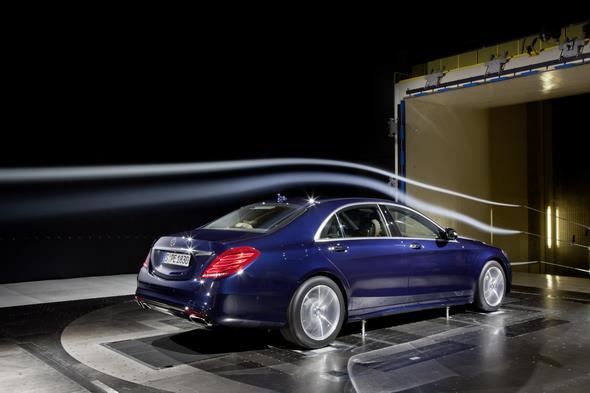
Rear end: horizontal lines and eye-catching light design
The extravagantly sculpted surfaces and lines of the side wall on the new S-Class generate excitement as they flow into the rear end.
As well as being elegant, the slightly slanting form has aerodynamic advantages.
Horizontal lines running from the boot lid to the bumper emphasise the car’s width when viewed from the rear.
The hallmark signature of the Mercedes‑Benz designers can also be seen in the rear windscreen, which cuts into the C-pillars.
The upper area of the glass is rounded to give it a coupé-like character. The three-dimensional chrome insert on the boot lid adds a new dimension in high-quality design.
The real highlights are the new-style tail lights which are completely encased by the car body and, thanks to this solitarily integrated styling, complete the design right down to the last detail.
Their meticulously crafted inner workings reflect the current state of the art. Featuring three horizontally arranged fibre-optic cables, the design echoes the hallmark Mercedes meander and so ties in seamlessly with the long line of predecessor models.
The combination of attention to detail with exacting technical requirements is apparent in both the night and the day design.
The rear fog lamp is housed in the centre of the bumper, while the reflectors are elegantly integrated on the left and right sides.
Interior design
Visual breadth and calm solidity
With its clear architecture, the interior design of the S-Class embodies a classic, superior, cutting-edge saloon.
The interior’s expressive character derives from a uniquely fluid, sensuously elegant style.
Horizontal elements and lines create a setting characterised by visual breadth and calm solidity.
High quality and elegance harmonise with clarity and functionality: the interior design of the S-Class combines ride comfort, spaciousness and user-friendliness to the very highest standard.
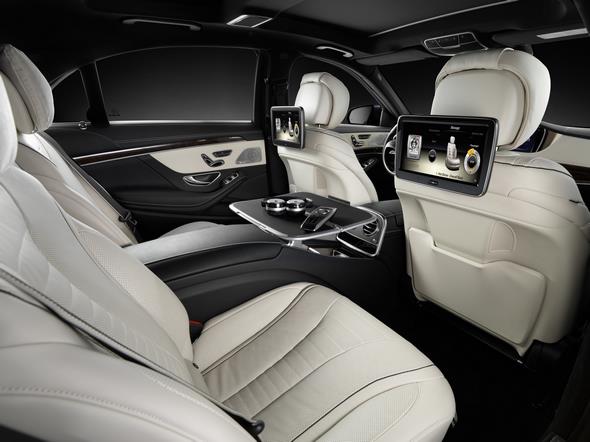
The radically redesigned display extends behind the two-spoke steering wheel – reminiscent of the S-Class heritage – as a key element of the horizontal alignment.
It replaces the traditional instrument cluster and combines numerous other functions in a visually and ergonomically highly sophisticated manner (see “New display concept” section).
The entire display unit appears to be free-floating, an impression reinforced by ambience backlighting.
The high-quality unit formed by the centre air vents and the analogue clock is precisely set into three-dimensional wood trim.
For the first time this classic wood trim feature is positioned very low.
This creates a second level of decorative trim whose luxurious stitched leather lies in the primary field of vision.
Both levels extend elegantly across the entire width of the dashboard and doors.
With this layout the designers have created an association with the wingbeat of a bird.
The result is an extraordinary impression of width combined with a pleasant, calm ambience.
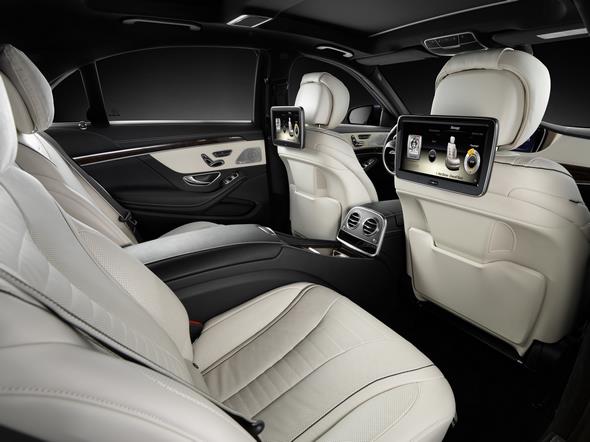
The visually prominent dashboard is characterised by the striking double-S curve. This already made the preceding model unmistakable, and imparts a feeling of spaciousness, safety and security.
The perfectly coordinated use of materials and colours produces an elegant interior seemingly cast from a single mould.
There is generous use of wood trim, especially in the dashboard and centre console.
Metallised switch surfaces with pearl-effect paint finishes in three colour shades to suit the interior colour particularly highlight the outstanding quality.
Innovative lighting systems in the form of a continuous light band under the wood trim strips and the central display – a completely new dimension in ambience lighting – and elegant lighting units with stylish details in the headlining enhance the comfortable atmosphere.
The number and size of the stowage facilities in the interior have been greatly increased compared to the preceding model.
Passengers in the rear are also seated in first-class – the design and exclusivity of the seats, door panels and all controls are to the same, high standard as the front.
If a luxury or reclining seat (Executive seat) is specified for the rear, the backrest inclines backwards into the parcel shelf, which means that legroom is not restricted even in the resting position.
As an additional individualisation feature, the “First Class Rear” incorporates a Business centre console combining personal comfort with practical convenience (integration of a telephone handset, additional stowage compartments, folding table, etc.).
The side finishers of the front seats are formally integrated and feature useful stowage compartments (see “Seats” section for details).
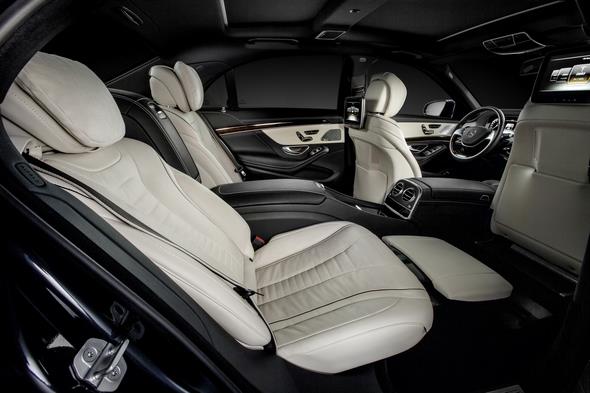
In combination with the first-class quality of materials and outstandingly high perceived value, the decidedly varied range of available appointments emphatically confirms the premium positioning of Mercedes-Benz.
The innovative architecture of the interior design, which is based on both additive and integrating features, allows a choice of different and very individual styling in terms of colours and materials.
The standard appointments already meet high expectations. They include leather seat upholstery (V 222), elegantly finished wood trim and surfaces with decorative topstitching.
Various leather versions are available as optional extras, differing in their surface finish (e.g. patterned perforations and a hand-quilted look and feel), and also in terms of the relative leather and trim surfaces.
The customer also has a choice of five interior colour arrangements combined with five different types of exotic wood trim.
The interior design of the new S-Class was also influenced by the Mercedes-Benz Advanced Interior Design Studio in Como, whose primary task was also to explore how the highest possible perceived quality can be created.
Using the so-called “appreciation model”, the designers were able to give free rein to their imagination and look for ways of translating these ideals into series production features.
This led to a harmonious and luxurious interior whose design, character and perceived value are unrivalled.
Aerodynamics
Sleek, silent type
For almost three decades, the aerodynamic specialists at Mercedes-Benz have been breaking one record after another.
At present the brand’s models occupy the top position for aerodynamics in practically every vehicle segment. The new S-Class is likewise at the top of its segment in terms of aerodynamics and aeroacoustics.
The drag coefficient of the new S-Class (cd=0.24) undercuts the previous model’s figure by two hundredths and sets a new benchmark in this segment.
The S 300 BlueTEC HYBRID is set to go even lower still with a cd figure of 0.23 thanks to additional aerodynamic optimisation measures.
A number of features and details have been aerodynamically optimised to achieve this result:
- Aerodynamically optimised front and rear apron with perfectly matched rear spoiler
- All-new aerodynamically and aeroacoustically optimised exterior mirrors
- Complete sealing of the front end with sealing of the headlamp section, improved sealing of the radiator section and airflow guidance to make efficient use of the available cooling air
- Use of a cooling air metering system (adjustable louvre)
- Water drain channels with optimum flow
- Lowering of the vehicle by up to 20 mm when the speed exceeds 120 km/h
- Spoiler lip on the tail lights
- Aerodynamically optimised underbody with extensive engine compartment and underbody panelling up to a point below
the tank to also further minimise the penetration of road noise - Aerodynamically shaped multi-purpose recess cover
- Special wheel spoilers ahead of the front wheels
- Aerodynamically optimised wheels and tyres
- Large area of cladding on the rear axle
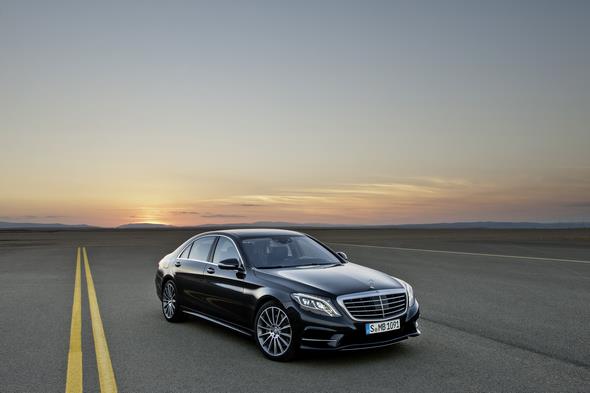
Barely perceivable noise level in the interior
The aeroacoustic specialists took specific measures to counter wind noises during their aerodynamic development work.
To reduce high-frequency wind noise, the sealing systems around the windows and door handles were above all improved considerably.
The newly designed exterior mirror and the correspondingly shaped A-pillar with a minimised shoulder height ensure the efficient drainage of water and spray hitting the windscreen, prevent the airflow from breaking off at this point and therefore avoid noises that might enter the interior via the windscreen and side windows.
The roof structure and the automatic tilting/sliding roof module were subjected to further aeroacoustic development to improve noise comfort in this area as well.
In the case of the panoramic sliding sunroof, numerous air deflection measures, covers and seals with the appropriate geometry ensure the same high level of noise comfort as in the preceding model, despite the larger opening aperture.
The combined effect of these measures allows the new S-Class to achieve the desired aim of being the quietest vehicle in its segment.
A subdued, scarcely perceptible level of noise in the interior of the S-Class was the objective when configuring and coordinating the sound insulation measures.
Particular attention was paid to transmitted engine noise and road roar. During the acoustic optimisation work, the focus was both on lowering the sound pressure level and on achieving the well-balanced and comfortable overall sound perception that is a hallmark of the S-Class.
To ensure that engine noise is perceived as refined and unobtrusive in the interior, the firewall insulation was extended into the side areas of the A-pillars.
Additional sealing levels were also added in the form of high-quality injection-moulded components.
A major contribution to the reduction in transmitted engine noise was made by improved insulation in the transmission tunnel area, as well as a modular engine partition made of plastic.
The different noise characteristics of the engines are taken into account by the use of different weights per unit area.
The electrically adjustable rear seats available as an optional extra are free-standing.
High-frequency tyre noise was reduced by a large area of insulation extending from the seat surface to the rear panel and parcel shelf.
Breakthroughs are kept to a minimum. An intelligent air ducting system inside the parcel shelf allows the necessary ventilation while reducing noise transmission via the parcel shelf.
The textile underbody and wheel arch cladding has an insulating and absorptive effect which reduces high-frequency tyre noise in the interior.
The model range
The assignment: perfection
The best automobile in the world – every new generation of the Mercedes-Benz S-Class has earned this accolade anew for itself.
The logical goal in the book of specifications for the coming model was therefore: perfection to the last detail.
New ideas and their painstaking realisation underpin the high standards that the engineers have set for the Mercedes‑Benz flagship model – and for themselves.
For the first time in the history of the S-Class, the development focus was on the long-wheelbase Saloon.
Unlike before, the standard-wheelbase version was derived from this.
This is because the S-Class is not only firmly positioned as a prestige saloon in the large overseas markets such as the USA, China or Japan.
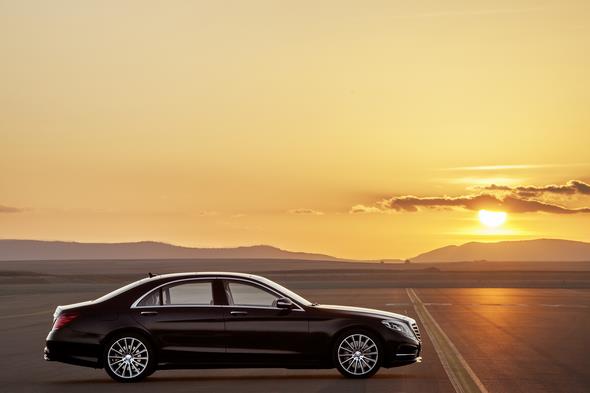
Whereas in Europe and North America S-Class owners are frequently behind the wheel themselves, the flagship model in the Mercedes-Benz passenger car portfolio is very much a chauffeur-driven vehicle in Asia.
There are two body lengths to choose from: 5248 and 5116 millimetres – 42 and 40 millimetres longer than the predecessor model respectively.
Whereas the wheelbase has stayed the same at 3165 and 3035 millimetres, the track width has increased by 24 and 31 millimetres to 1624 (front) and 1637 millimetres (rear) respectively.
The occupants of the new S-Class benefit from the moderate increase in vehicle size by an improvement in all the interior dimensions: there are 12 millimetres more maximum headroom for the driver, as well as 14 millimetres more shoulder room and 10 millimetres more elbow room in the front.
Thanks to the 14-millimetre increase in rear kneeroom, travel becomes even more comfortable for passengers in the rear. Shoulder room in the rear has been improved by up to nine millimetres.

Over 3.5 million customers and numerous awards
The Mercedes-Benz flagship model, which has now been known as the S-Class for over 40 years, has not only proven immensely popular with customers for many years.
It also has a string of awards to its name, underlining its class.
In 2011, for example, the S-Class received the award for best car in the luxury segment from the German magazine “auto motor und sport” and the accolade “Prestige Car of the Year” from “Motoring Television” in North America.
In addition to this, the S-Class won the J. D. Power APEAL Award for the best vehicle in the segment in terms of efficiency, technology and design for the fourth time in succession in 2010.
Furthermore, the S-Class underlined its pioneering role in the field of green technology in the premium segment by winning the “World Green Car of the Year 2012” award.
Even in the year leading up to the model change, the S-Class continued to be very popular with customers.
A total of 65,128 S-Class Saloon models were handed over to their new owners.
The Mercedes-Benz brand’s flagship model thus remained the world’s best-selling luxury saloon.
Over 500,000 models from the last S-Class model series have been delivered to customers around the world since its launch in September 2005, meaning that this S-Class sold even better than the previous generation.
Since the launch of the 220 model that laid the foundations for the S-Class model series, Mercedes-Benz has delivered more than 3.5 million of these vehicles to customers all around the world.
Lights
The first ever car without a single light bulb
100 years or so after the introduction of electric lighting in motor vehicles, Mercedes-Benz is now making a complete switch to LED technology – the new S-Class is the first vehicle in the world to do without a single light bulb as standard.
The lighting’s multi-level functionality is another world first: out of consideration for any road users behind, the intensity of the brake lights is reduced at night or while waiting at traffic lights.
Meanwhile, visibility is enhanced by two assistance systems that have undergone some key improvements – Adaptive Highbeam Assist Plus and Night View Assist Plus.

Mercedes-Benz is further underlining its pioneering role in the field of lighting technology: the new S-Class does not have a single light bulb on board.
Almost 500 LEDs assume the task of illuminating the road, vehicle, interior and luggage compartment. Depending on equipment, these are:
- Headlamps: each with up to 56 LEDs
- Tail lights: each with up to 35 LEDs (plus 4 for the rear fog lamp)
- Interior (including ambient lighting): approx. 300 LEDs
“With its long life and a colour temperature resembling daylight, LED technology already had a great deal in its favour,” remarks Prof. Thomas Weber, Member of the Daimler Board of Management responsible for Group Research and Head of Development, Mercedes-Benz Cars.
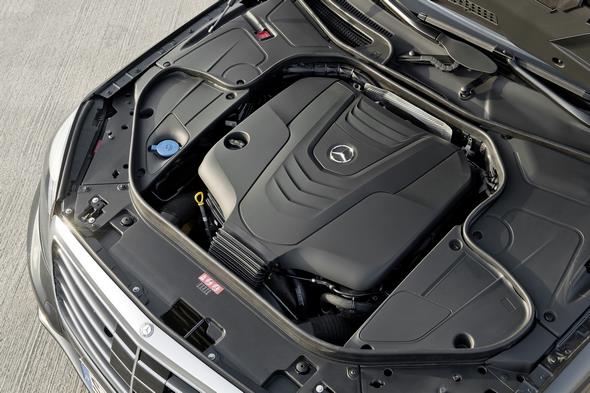
“Now, though, our engineers have made great advances where energy efficiency is concerned too, reducing power consumption to a quarter of that of conventional headlamps.”
The new energy-saving LED low-beam headlamps, for instance, require 34 watts to produce the same light output, making them notably more efficient than halogen (120 watts) and xenon light sources (84 watts, all figures per vehicle).
This translates into a saving of 0.05 litres of fuel per 100 kilometres or 2.1 grams of CO2 per kilometre compared to a vehicle fitted with halogen low-beam headlamps.
Efficiency is given a further crucial boost by new, high-performance single-chip LED diodes and a newly developed projector module in the headlamp unit, in which deflected beams of light are reflected back again.
Even the entry-level model in the new luxury saloon range will come with all-LED lighting.
The supplementary functions of the Intelligent Light System as well as Adaptive Highbeam Assist Plus can be added as options.

Permanent high beam with no dazzling: Adaptive Highbeam Assist Plus
For the first time, Adaptive Highbeam Assist Plus allows the high-beam headlamps to be kept on permanently while driving by masking out any other road user detected in the beams’ cone of light.
If the camera-based system registers either oncoming traffic or vehicles ahead, it will adapt the light distribution according to the specific situation when the high beam is switched on.
Consequently, the driver can simply leave the high-beam headlamps on at all times and use their full range without irritating or even endangering other road users.
There is no need to switch them on and off manually, resulting in a significant increase in the overall driving time with high beam.
The Adaptive Highbeam Assist Plus likewise makes use of the new stereo camera also employed by other assistance systems.
If its image recognition algorithm picks up a vehicle that is oncoming or driving ahead, it actuates a mechanism in the headlamp module.
This then masks the portion of the LED headlamp’s main-beam cone of light where there are other vehicles to prevent their drivers being dazzled.
If road users are detected outside the area that can be masked – for instance when cornering with multiple vehicles in the headlamps’ beams – the system will switch to the familiar system of headlamp range control using the low-beam headlamps.
Possible backglare caused by increased use of the high beam and highly reflective signs at the side of the road is also detected and eliminated by dimming the headlamps accordingly.
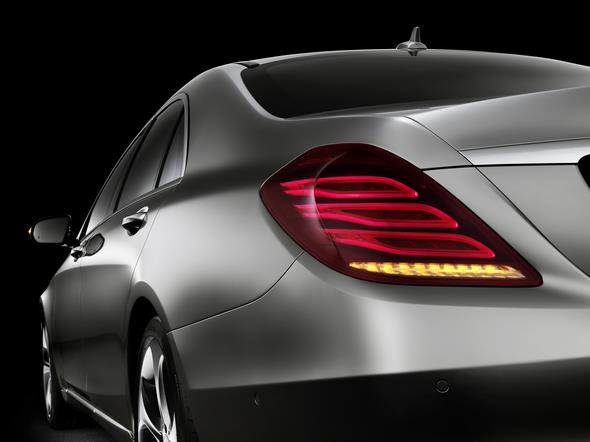
Considerate to others: tail lights with automatic intensity control
The new S-Class shows itself to be highly considerate of its fellow road users in another way, too: Mercedes-Benz has achieved yet another world first by developing tail lights with multi-level functionality, meaning that the brake lights and indicators are operated at varying intensities depending on the current driving state and the brightness of the environment (day/night).
If the Mercedes driver presses the brake pedal while stopped at traffic lights at night, for instance, the brightness of the brake lights will be automatically dimmed to avoid dazzling anyone behind.
The light distribution is broadened to ensure the lights do not become too dark and continue to fulfil all legal requirements.

Detects pedestrians and animals: the advanced Night View Assist Plus
For the first time, the new Night View Assist Plus is capable of detecting not just pedestrians in potentially hazardous positions in front of the vehicle, but animals too.
This third-generation night vision system automatically switches the instrument cluster display from the speedometer to a crystal-sharp night view image to alert the driver in particularly relevant situations (darkness, unlit roads at speeds over 60 km/h).
Any pedestrians or animals detected ahead are highlighted in colour in this image.
In such situations the spotlight function is additionally used to repeatedly flash pedestrians in the warning zone by means of a special module in the front headlamps.
This attracts the driver’s attention to the source of the danger at the same time as warning the person on the side of the road.
Animals are purposely not flashed since their reaction to light is unpredictable.
Manual cut-in of the grey-scale image is possible at any time; pedestrian and animal detection and the corresponding highlighting now also are available in urban areas during darkness (illuminated roads, speed less than 60 km/h) if the greyscale image is activated permanently.
An additional (long-range) infrared sensor in the radiator grille supplements the proven Mercedes-Benz night vision technology.
It is able to detect pedestrians at a distance of up to 160 metres, and animals such as deer, horses and cattle at up to 100 metres.
Two separate light sources in the headlamp assemblies light up the area in front of the vehicle with invisible infrared light.
This enables the (short-range) infrared camera positioned behind the windscreen next to the rear-view mirror to produce a sharp greyscale image in the instrument cluster display.
This image can also be shown in the display permanently if desired at the press of a single button.
Good vision also is ensured by MAGIC VISION CONTROL. The system cleans the windscreen without the splash of water that usually briefly disrupts the driver’s field of view in the case of conventional windscreen washing systems.
With MAGIC VISION CONTROL, the fluid is supplied to the windscreen by means of water guides integrated on both sides along the wiper blade and minute spraying holes.
This Mercedes-Benz innovation had its world premiere last year in the Mercedes-Benz SL and has been augmented by speed-sensitive control for the S-Class.
Control and display concept
Elegant new control centre
Two high-resolution TFT colour displays in 8:3 format with a screen diagonal of 30.7 cm (12.3 inches) form the new information centre in the S‑Class.
The left-hand display performs the functions of the previous instrument cluster, providing the driver with all relevant information.
The right-hand display allows the convenient control of infotainment and comfort functions.
Ergonomics, operating convenience and safety along with attractiveness and aesthetics were the main considerations for the newly designed control and display concept.
For the S-Class, the constantly increasing need to integrate additional functions into the vehicle led to a further development of the entire operating logic.
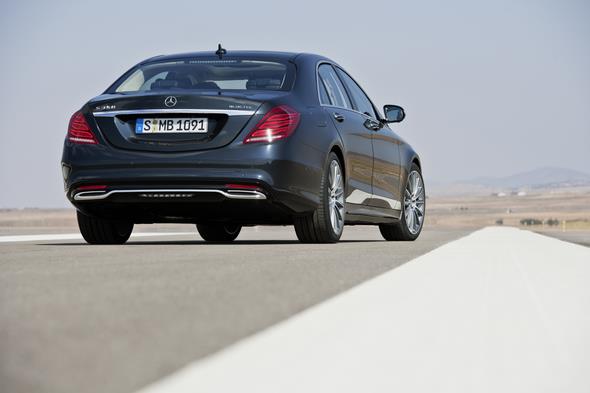
The aim in designing the control and display features was to group controls and display functions together in a coherent manner in terms of both design and functionality.
Apart from the new displays, the metallised switch surfaces and solid aluminium controls are visual highlights of particularly high quality.
Thanks to the fine structuring on the metal surfaces, each individual control has the sound, feel and attention to detail that make Mercedes-Benz something very special.
The well-proven Mercedes-Benz operating philosophy with a multifunction steering wheel, DIRECT SELECT transmission selector lever and COMAND Controller in the centre console has been retained.
The engineers have, however, taken a new approach with the large high-resolution display depicting the instrument cluster, a display area showing the driving assistance systems next to the rotary light switch and a new position for the cruise control stalk, on the left below the combination switch for the wipers and indicators.
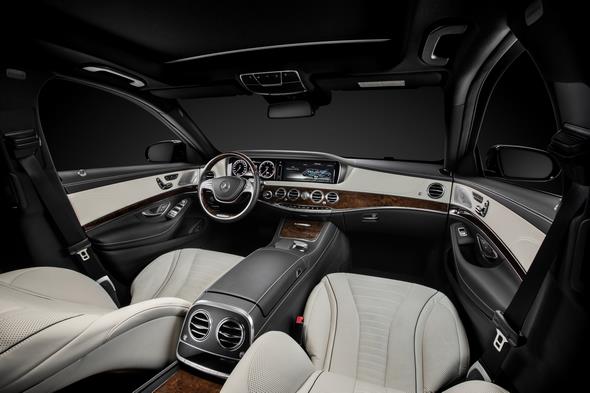
With Mercedes-Benz COMAND Online the customer is now able to adapt the contents of the central display to personal requirements.
With the exception of the navigation map (which always fills the complete display area), the central display is divided into a main area (2/3 on the right of the screen) and an additional area (1/3 on the left side of the screen).
In standard configuration the additional area shows supplementary information about the selected main application, e.g. if the radio function is active, the artist and song title are shown, or the current channel in the case of TV.
If required, it is also possible to permanently display a preferred content item in the additional area, for example a small navigation map, fuel consumption display, data connection display or entertainment information.
High-quality visualisation and animations make for easy control: changes to the settings for the climate control or seats, for instance, are immediately visible and therefore easy to follow.
The two screen displays have a “Corona” for effect, making the display appear to be floating in space. This lighting can be individualised in seven colours as an option.
Like the switch and controls illumination, the brightness can be adjusted using a rotary control between the instrument cluster and central display.
Optionally, individual brightness levels can be set for the different lighting zones in the vehicle interior using the vehicle functions of the COMAND Online system.
The new instrument cluster: important information at a glance
The architecture of the instrument cluster in the S-Class signals a new departure for Mercedes-Benz.
For the first time a large TFT colour display with a screen diagonal of 30.7 cm (12.3 inches) in 8:3 format is used to display driver information.
The large screen provides much more scope with respect to the presentation of contents, animation of displays and vehicle-related information, especially where the onboard assistance functions are concerned.
The design of the two large dial instruments showing the vehicle speed (left) and rpm (right) follows the classic style.
The menu for “Journey”, “Navigation” and “Media” and the relevant sub-menus accessible between the two dial instruments are also familiar in principle, and are operated using the steering wheel function keys as before.
The central area between the dial instruments shows the driving assistance systems.
When they intervene, the actions of systems such as DISTRONIC PLUS, Stop&Go Pilot, Active Blind Spot Assist and Active Lane Keeping Assist are notified to the driver by visualisation.

The image from Night View Assist Plus is now also shown between the two instruments, where it is easily visible.
In the process the circular scales of the two displays are reduced to three-quarter circles with revised scaling to provide the largest possible area for the camera image.
In the central area of the display the driver also receives visual support when searching for a parking space.
Active Parking Assist with PARKTRONIC shows recognised parking spaces (left/right, parallel or end-on parking) and guides the driver through the parking procedure.
The graphics in this display resemble actual perspective views rather than two-dimensional images from above.
Recognised speed limits and any supplementary signs are now shown in the speedometer for easy visibility.
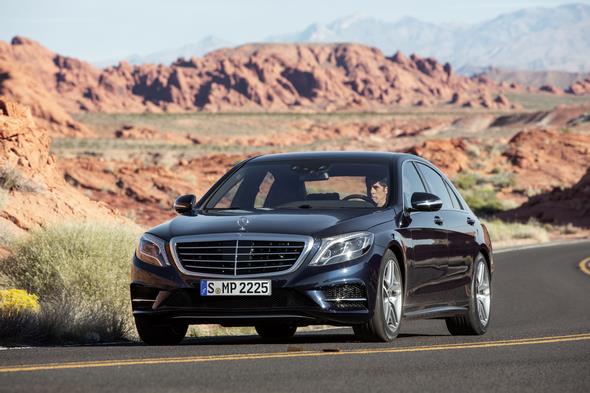
Mercedes customers will find the classic displays and warning lamps easy to recognise.
The distance information for the front PARKTRONIC sensors (left/right) is shown at the top, between the two dial instruments.
Above this are the control lamps for the indicators/hazard warning system, lighting functions (parking lights, high beam, fog lamps, low beam) and the distance warning.
The outside temperature is shown in the centre at the top.
The fuel gauge showing the volume in percent is located in the speedometer (6 o’clock position), and the speedometer also accommodates the control lamps for the ESP® functions, ABS, the warning lamps for the airbags (SRS – Supplemental Restraint System), the seat belts and the tyre pressure monitoring system.
The coolant temperature appears in the 6 o’clock position in the rev counter, which also shows the current transmission mode, automatic transmission gear and the function displays for the electric parking brake, brake lining wear indicator and engine diagnosis.

Support for the driver: the ECO display
If required, three bar charts in the instrument cluster give the driver feedback about the economy of their driving style.
The ECO display responds positively if the driver accelerates moderately, drives smoothly in an anticipatory manner and avoids unnecessary braking.
The three bar readings stand at 100% if driving is particularly economical according to these criteria.
When starting off all the values are at 50 percent, and a particularly unfavourable driving style causes them to decline.
The aim is to arouse a competitive desire in the driver to achieve 100 percent if possible.
Central display: the control centre for infotainment and comfort
An all-new COMAND Online generation has its world premiere in the new S-Class.
It excels with intuitive operation and the immediacy of its functions, thanks to animated menus and images on a large display (12.3 inches) in 8:3 format with a resolution of 1440 x 540 pixels.
For video and TV reproduction a part of the screen corresponding to the 16:9 format is used.
The large display is used for animations and 3D effects. An additional area on the display simplifies operation with a context-related representation of the current application or permanent display of the navigation map, for example, or – in the case of models with hybrid drive – a display of the hybrid functions showing the energy flow.
The animated high-resolution display concept is particularly impressive where the Digital Owner’s Manual for COMAND Online is concerned.
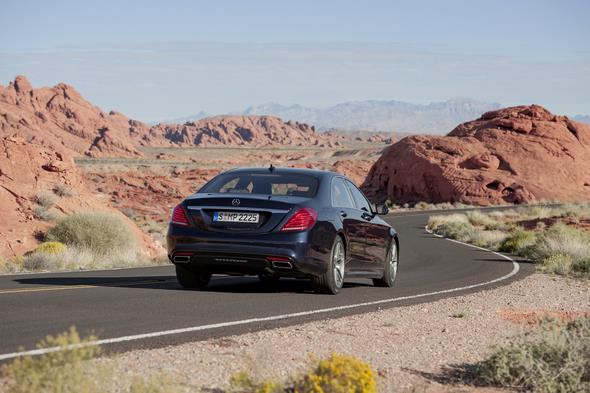
Depending on the level of appointments, there is a context-sensitive display of the contents for the individual vehicle, and even retrofits are taken into account.
Operation: touch-sensitive telephone keypad, extended voice control, two different remote controls
The new control features include a touch-sensitive telephone keypad and an extended favourites function with twelve freely selectable memory places.
The principal control element is the rotary pushbutton, with the usual direct access keys in the centre console for the most important functions.
Voice entry using LINGUATRONIC via the Speech Dialog System allows complete addresses to be spoken in one go, for example (one-shot input).
The telephone and audio systems can also be voice-controlled. The option of having text messages (SMS) or emails read out is a new feature.
Polish and Finnish are newly available languages, and Arabic is now fully supported.
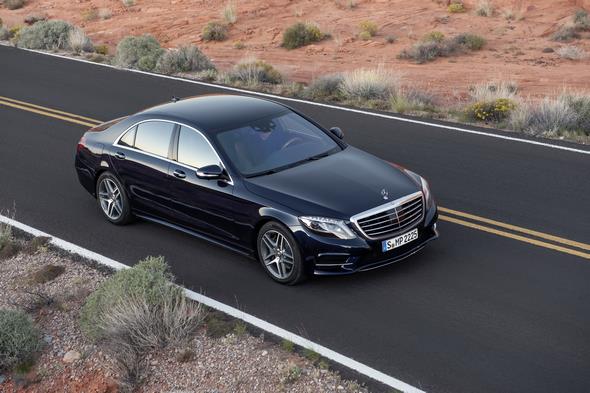
The new COMAND Online also comes with two remote control variants:
- basic remote control (high-quality unit with chrome)
- iPhone®/Android app with remote control function via WLAN
Apart from showing and operating the COMAND Online functions (internet browsing, reading and writing SMS and email, internet radio, Mercedes-Benz services), the telephony functions, navigation, radio and TV plus the sound systems (see “Multimedia features” section), the central display shows and operates the many comfort functions, some of which are new. They include:
- Multifunction seats (contour and ENERGIZING massage function with programmes), settings
- Seat heating Plus
- Air conditioning, perfume atomisation, ionisation, panel heating
- Vehicle functions (ambient lighting in seven colours, locator lighting)
Seats
Mobile office and centre of wellbeing
With numerous world firsts such as the ENERGIZING massage function based on the hot-stone principle or active seat ventilation with reversing fans, Mercedes-Benz has raised seating and climatic comfort in the S-Class to a new level.
The seat developers have paid particular attention to the rear seats. There is a choice of five different rear seat variants including an Executive seat with a backrest angle adjustable by up to 43.5 degrees, allowing occupants in the rear to concentrate on work or relax in comfort.
Intelligent lightweight construction was the watchword during development of the seats.
At less than 20 kilograms, the structure of a front seat weighs around 20 percent less than conventional designs.

This is in large measure due to the sandwich construction of the side sections on the seat frame, which consist of a two-piece, high-strength steel shell with integrated plastic inserts.
This enables the forces from the backrest attachments to be symmetrically introduced into the seat base.
There is a further advantage for the seat belt system: unlike with other seat structures, the belt buckle and anchor fitting not only move with any fore-aft adjustment, but also with seat height adjustment.
Whatever the size of the seat occupant, this always ensures the best possible belt fit and maximum safety.
The front seats of the new S-Class are electrically adjustable for length, height, inclination and seat cushion depth.
The 4-way Power lumbar support and head restraint height can be equally conveniently adjusted at the touch of a button.
If the Memory package is specified for the driver and front passenger, the front passenger seat can also be adjusted by the driver if required.

Thanks to wide-ranging adjustments, occupants of very different sizes are seated very comfortably in the new S-Class. The figures:
- Fore-and-aft adjustment: 290 millimetres
- Seat height: 65 millimetres
- Seat cushion depth: 65 millimetres
- Head restraint height: 60 millimetres
- Cushion angle: +/- 2.5 degrees
- Backrest angle: 27 degrees forward
The sophisticated upholstery structure of the front seat backrests includes Pullmaflex springing and a natural fibre/rubberised hair insert lined with cut foam.
In the seat cushion, the flat spring core of the cushion base has a contoured foam insert lined with cut foam. In each case the seat cover has a fleece lining.
The front head restraints are adjustable both vertically and horizontally.
Optionally available electric horizontal adjustment (EASY ADJUST luxury head restraint) is new in the S-Class, and optimises the distance between the occupant’s head and the head restraint to lower the risk of whiplash injuries in an accident.
Numerous innovative features enhance both seating and climatic comfort – an overview of the most important new developments:
The “Seat Comfort package for driver and front passenger” includes a world first in the form of the ENERGIZING massage function on the hot-stone principle.
In collaboration with physiotherapists and psychologists, the seating experts at Mercedes-Benz have developed a unique massage system with 14 separately actuated air chambers in the backrest and an integrated warming function.
There is a choice of six massage programmes, two of which are heat-assisted. In addition the package includes active multicontour seats with further improved dynamic functions, which have been awarded a seal of approval by AGR, an organisation promoting spinal health.
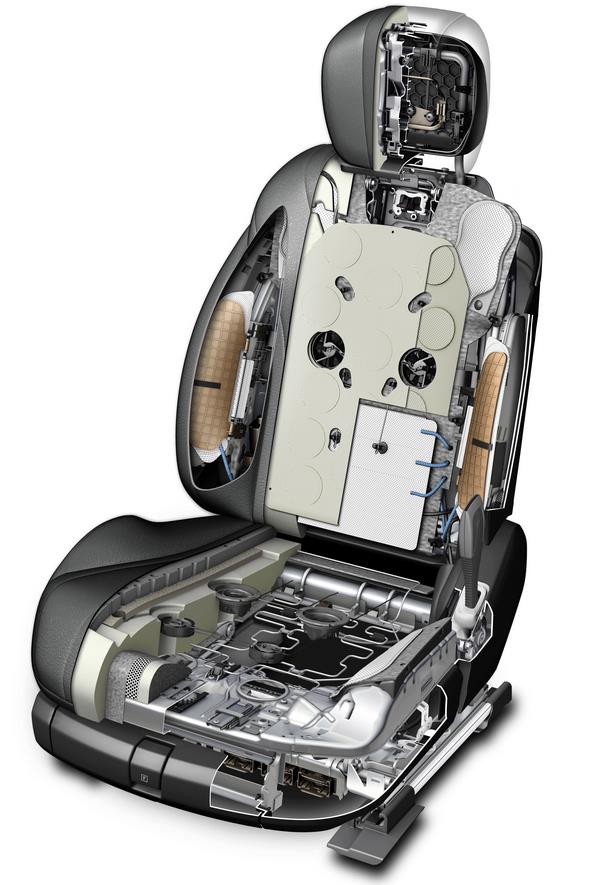
The climatised seats mark yet another debut: for the first time, so-called reversing fans are used in the active seat ventilation system.
Here the rotational direction of the fan, and therefore the airflow within the seat structure, can be reversed.
When the ventilation function first begins, cooler surrounding air is drawn onto the seat surface.
This enables the surface temperature of a heated-up seat to be reduced much faster than with the previous active cooling systems.
After four minutes the fans are automatically switched to blower mode to reduce draughts and therefore ensure sustained comfort.

Together with the perforated leather, four fans in the seat cushion and two fans in the backrest ensure a uniform relative air humidity where the occupant’s body meets the seat. The intensity can be adjusted in three stages according to individual requirements.
In combination with seat heating, each occupant is able to find the ideal climatic seating comfort. Using the head unit, the customer is able to set an optimal heating output for seat cushion and backrest and activate the quick-response seat heating. In the main seat area this provides a heating output of up to 2000 watts per square metre.
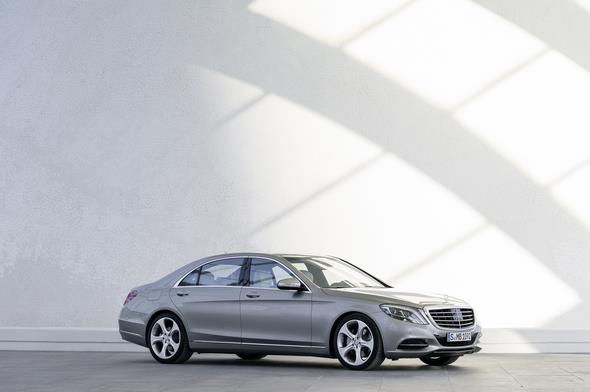
The “EASY ADJUST luxury head restraint” adjusts itself automatically when the backrest position of the driver or front passenger seat is changed.
This keeps the distance between the head and the restraint constant. On the front passenger side the head restraint can be folded down or removed, allowing the rear passenger an unobstructed view to the front.
If the S-Class is ordered with the “Chauffeur package”, the rear seat occupant on the front passenger side has 77 millimetres more maximum kneeroom.
This is because the front passenger seat can be moved 40 millimetres further forward, and a further 37 millimetres of space can be obtained thanks to a 4-link system.
In addition to this “chauffeur position” the front passenger seat can be folded forwards or placed in an extended-recline position (for details see next section “The rear seats”).
The EASY ADJUST luxury head restraint is standard equipment with the “Chauffeur package”, as is a heel support for the rear passenger which extends from under the front passenger seat if the long-wheelbase version is ordered.
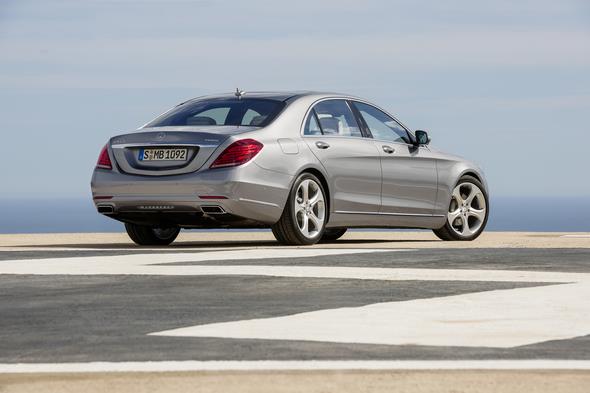
Luxury and reclining seat on request: the rear seats
Whereas in Europe and North America S-Class owners are frequently behind the wheel themselves, the flagship model in the Mercedes-Benz passenger car portfolio is very definitely a chauffeur-driven vehicle in Asia.
The logical consequence is the particular attention devoted to the rear by the seat developers.
The rear seats are therefore right in the forefront when it comes to seating/climatic comfort and passive safety.
Two rear seat variants (static bench seat or individual seats with 37-degree adjustment) are available for the short-wheelbase S-Class, and no less than five for the long-wheelbase version – see table on the next page.
The adjustment kinematics have been changed in the luxury and reclining seat variants.
Unlike the conventional trailing backrest design, the backrest is adjusted separately so that the legroom and seat reference point remain unchanged.
The cushion can be separately adjusted for angle and horizontal position.

The maximum backrest angle of the Executive seat (reclining seat) on the front passenger side is increased from 37 to 43.5 degrees, giving it the largest backrest inclination in the luxury segment.
The reclining seat behind the front passenger seat features a calf support which is freely adjustable for length and angle.
In combination with the heel rest on the folding chauffeur seat (see section “Front seats”) and an additional comfort cushion, this allows a reclined position that sets new standards in the automobile sector with respect to sleeping and resting comfort.
The individual seat functions in the rear, and those of the chauffeur seat, are operated via the typical Mercedes control panels in the rear doors.
The “resting position” key is pressed to bring the front passenger seat and rear seat into the reclining position.
The most upright backrest position of 19 degrees in the luxury and reclining seat variants allows relaxed working in the rear.
The rear seat variants at a glance:
| Rear seat variants | Basic version | Long version | |
| Bench seat with 27° backrest angle | Three-seater bench seat with folding centre armrest | Standard | Standard |
| Luxury seat with 19 to 37° backrest angle* | Three-seater with individual outer seats and folding centre armrest | Optional | Optional |
| Two-seater with Business centre console in the rear (First-Class rear suite) | – | Optional | |
| Executive seat (reclining seat) with 19 to (on the front passenger side) 43.5° backrest angle* | Three-seater with individual outer seats and folding centre armrest, additional cushion for luxury head restraint | – | Optional |
| Two-seater with Business centre console in the rear (First-Class rear suite), additional cushion for luxury head restraint | – | Optional | |
*Variably electrically adjustable

The “First-Class rear suite” (centre console in the rear) is a visual continuation of the front console on the transmission tunnel.
It is equipped with innovative thermo-cupholders which use Peltier technology to cool or warm drinks over a longer period of time.
Like an aircraft seat, the centre console is available with two tables which can be easily folded in or out using one hand.

Two articulated joints on the stem and underside of the table enable it to be adjusted to almost any position.
The table supports and surface are of light alloy, combining great stability with a high-quality look. The table surfaces have leather inserts to provide a comfortable writing surface.

The optional “Rear Seat Comfort package” also makes the innovative ENERGIZING massage function on the hot-stone principle available for the rear seats.
The package also includes active multicontour seats in the rear (without dynamic control function).
Setting the standard for safety in the rear: new features in the S-Class
Mercedes-Benz has extended the safety system for rear seat passengers further with the seat belt buckle extender, the beltbag and the cushionbag.
The first two of these developments are included in the “PRE-SAFE® rear package”.
With the seat belt buckle extender, an electric motor extends and retracts the belt buckle automatically.
In this way, any belt slack in the area of the pelvis and thorax can be reduced so that passengers are secured more firmly in both the sideways and the lengthways direction.
The seat belt buckle emerges from the upholstery when the rear doors are opened and is provided with an illuminated insertion slot.
Making the belt-fastening procedure easier may lead to increased use of rear seat belts.
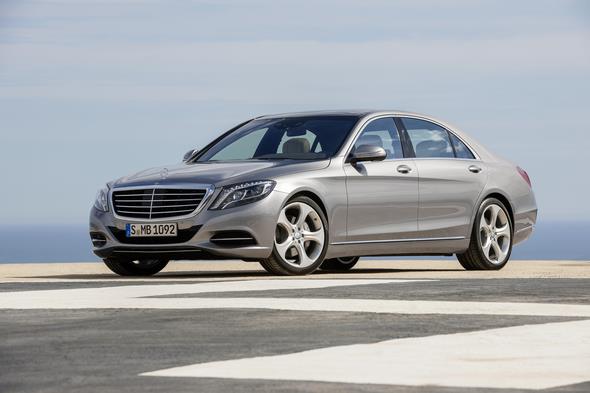
The beltbag is an inflatable seat belt strap which can lower the risk of injury to rear passengers during a frontal impact by reducing the loads acting on the ribcage.
Should the crash sensors detect a severe frontal impact, the airbag control unit will trigger deployment and inflation of the beltbag.
A gas generator then inflates the multi-layered belt strap with Velcro seams to nearly three times its normal width.
The resulting larger surface area is able to better distribute the force acting on the seat occupant, thereby reducing the risk of injury.
The reclining seat is equipped with a cushionbag as standard. This has enabled Mercedes-Benz to design a comfortable reclining seat which provides a higher level of accident safety than a seat with a trailing backrest.
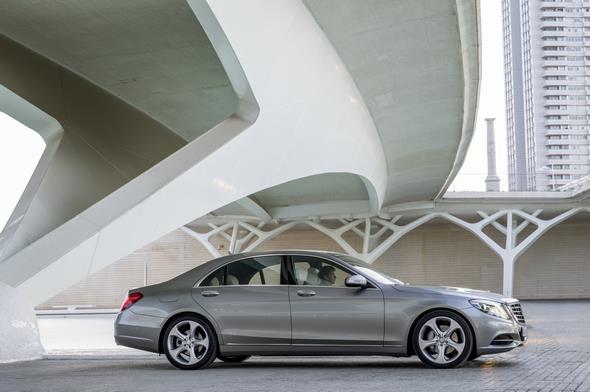
The airbag is located under the seat cushion upholstery, but on top of the plastic seat shell, which is moved by the seat mechanisms.
This means that the airbag is always in the same position on the seat shell, and therefore relative to the pelvis position of the occupant.
In an accident, with the occupant in a reclined position on a flat seat cushion, there would otherwise be a danger of the pelvic area sliding beneath the seat belt (so-called submarining).
This can be prevented by the cushionbag, as it raises the front section of the seat cushion upholstery. The airbag is only activated if the seat is in the reclined position during a crash.
It is not activated in the upright position, as there is then no danger of submarining because of the seat cushion angle.
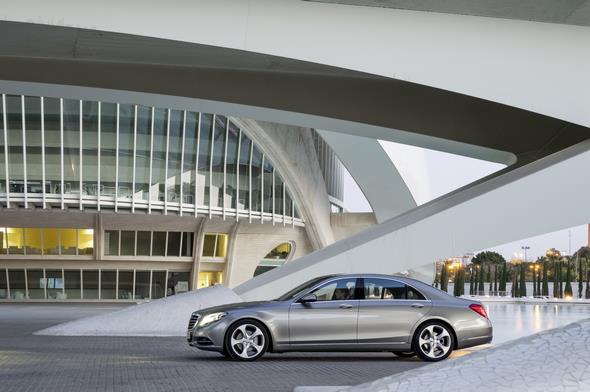
Climate control
A wealth of new features for a pleasant atmosphere
During the systematic further development of the entire climate control system, a particular focus was placed on the development goals of performance, air quality, precise regulation, noise level and efficiency.
As a new feature, the AIR-BALANCE package comprises perfume atomisation, ionisation and even more efficient filtration compared with the standard model.
The THERMOTRONIC automatic climate control in the rear has two additional zones to improve thermal comfort.
Electric heating of the armrests is a completely new feature.
The newly developed climate control unit of the THERMOTRONIC automatic climate control included as standard has a mass flow regulating concept, whose automatic operating principle meets individual comfort requirements for every occupant.
New features include completely autonomous adjustment options for the driver and front passenger sides with respect to temperature level, air distribution and air volume, for the front footwell temperature with a warmer or cooler tendency and also for the individual automatic modes with their climatic settings of “FOCUS”, “MEDIUM” and “DIFFUSE”.
The profiles, which differ in air volume and air distribution, can be conveniently set via the COMAND Online system.

The AIR-BALANCE package: perfuming, ionisation and improved filtration
As a world first, the new S-Class Saloon has an “active perfuming system” as part of the AIR-BALANCE package.
‘Active’ means that the perfuming system is switched on and off manually, with manual adjustment of the intensity. The perfuming system has various operating modes:
- On/Off
- Intensity control “low – medium – high”
- Perfume selection by exchanging the flask in the fragrance generator
A high-quality fragrance introduced into an already luxurious interior like a perfume enhances the sensual impression of the Mercedes-Benz interior by appealing to the sense of smell.
In all advanced cultures, high-quality fragrances are part of the repertoire of sensual pleasure and individuality.
Perfuming individualises the smell of the interior. The interior smell is not changed permanently, nor are the perfume molecules deposited on fabric surfaces or clothing.
The fragrance is discreet and mild, and dissipates rapidly. Four interior fragrances (FREESIDE MOOD, NIGHTLIFE MOOD, DOWNTOWN MOOD, SPORTS MOOD) are available in attractive perfume flasks. The fragrances were developed in collaboration with the perfume specialist Marc vom Ende.
The perfuming system consists of two parts: a glass flask with an atomiser head and the fragrance generator in the glove compartment.
The system uses the effect whereby there is a constant exchange of matter on the surface of a solution. In the process, molecules enter the gaseous phase (volatilisation) while other molecules are returned to the liquid.
If a partial airflow is passed over the surface of the liquid, the air can be enriched with the molecules of the chosen fragrance.
The perfumed air is then passed directly into the vehicle interior via a separate aperture.
A bypass system allows the flow rate per unit of time to be variably adjusted.
This active perfuming system is a further development of the fragrance ball familiar from the MAYBACH ZEPPELIN.
Air filtering: fresh air for a fresh interior
Another component of the AIR-BALANCE package is filtering of the outside air fed into the vehicle interior by the climate control system, and of the air recirculating in the interior in air recirculation mode.
The filter system is now even more efficient, and is able to reduce the peak levels of certain gaseous emissions while lowering their concentration below the perception threshold.
The filter system consists of two combined fine dust/activated charcoal filters between the intake and air distribution system of the air conditioner.
Activated charcoal is used as the filter material for the interior by virtue of its good ability to absorb gaseous pollutants and odours.
It is produced from coconut shells. The sophisticated pollen filter technology in the fine dust filter component is particularly useful for allergy sufferers. At Mercedes-Benz these filters are examined for effectiveness in both new and used condition, to ensure that their filtering efficiency is maintained at least until the next vehicle service.
Ionisation is another component of the AIR-BALANCE package, the air from the climate control unit being conducted into the interior via an ioniser.
In a combined operating mode this eliminates certain viruses, bacteria and spores (cleaning effect).
At the same time the air can be freshened by an increased concentration of negatively charged oxygen ions (relaxing effect).
Warmth Comfort package: heated armrests and seats
The new S-Class Saloon is available with the optional Warmth Comfort package for all engine variants. This includes
- heated front armrests (door and centre armrests)
- fast seat heating for the driver and front passenger
- heated steering wheel
- heated rear armrests (door and centre armrests)
- heated rear seats
The innovation in this package is the armrests, whose surfaces can be heated by heating elements on the same principle as seat heating.
Originally conceived for the energy-efficient heating of electric cars, this panel heating in the S-Class makes for a particularly cosy environment.
The armrest heating is switched on and off using the seat heating switch in the door panel, and can be deactivated via COMAND Online.
The heating output of the seat heating system can reach up to 2000 watts per square metre, and can already be felt in the sensitive lumbar area after ten seconds.
Climate control: multiple adjustments, high efficiency
The new climate control system in the new S-Class combines energy efficiency with comfortable temperatures on every seat, and sets new standards in terms of the adaptability of automatic operation to the individual wishes of the occupants.
The new automatic climate control is operated via:
- the newly developed control panel below the centre vent
- the climate menu in COMAND Online
- the rear control panel in the rear centre console (if the optional rear climate control is specified).
To improve climatic comfort in the rear even further, a newly developed, water-flow controlled two-zone THERMOTRONIC rear automatic climate control system installed in the centre console is available as an optional extra.
The air is taken into the interior of the centre console. The cooled air flows through a water-flow controlled heat exchanger, and is distributed to the separate left/right centre vents, the rear footwells and the vents in the B-pillars.
Air distribution to both sides is automatically controlled by four step motors.
The basic functions of the air conditioning, i.e. automatic operation, temperature adjustment, air volume, residual mode, recirculation, defrost and heated rear window can be directly controlled by buttons in the front control panel.
Further climate control functions such as auxiliary heater, perfuming, ionisation and footwell temperature can be accessed via the climate status display in the head unit, where basic functions such as air distribution and ventilation modes are also accessible.
The air volume and distribution control have been developed further and improved in comparison to the climate control system in the preceding series.
This means:
- Automatic modes “MEDIUM” (comparable to the same mode in the previous model), “DIFFUSE” (for the lowest possible airflow, and not aimed directly at the occupants; most of the air flows into the interior from the defrosting and footwell vents) and “FOCUS” (a higher volume of air mainly from the ventilation vents)
- Separately adjustable fans for the driver and front passenger
- Front footwell temperature can be individually and separately made warmer or cooler in five stages for the driver and front passenger.
The heat exchanger in the heating circuit has an output of 9.7 kW at an air volume of 8 kg/min.
Diesel models are equipped with a heat exchanger featuring three integrated PTC heating element rows with a selectable six-stage heating output of 1.5 kW.
An electronically commutated auxiliary water pump allows residual heat operation when the ignition is switched off.
The flat-tube evaporator in the refrigerant circuit has an output of 8.8 kW.
In non-hybrid models the refrigerant compressor is variably externally controlled, and incorporated into the belt drive system via a magnetic coupling.
A large number of sensors are used to regulate the automatic climate control, e.g. venting and evaporation sensors, potentiometers in the vent selector wheels, multifunction sensor with moisture measuring cell and a ventilated interior sensor for the interior temperature in the area of the overhead control panel.
Solar radiation is registered with the help of two separate solar sensors on the left/right of the interior, a sensor in the cockpit and a sensor on the parcel shelf.
GPS navigation data are used to determine the direction of the sun and the altitude above sea level (elevation).
In case GPS navigation data are not available, a fallback calculation of the sun’s direction is made on the basis of the vehicle-encoded country of delivery, the time of day and the date.
The air conditioning control system is therefore able to react to the increase in heat caused by direct sunlight even if the solar sensors register no change in the interior, for example if they are fully or partly obscured by the A/B/C-pillars or by the roof.

Energy-efficient climate control: economical heating and cooling
Various measures have been incorporated to make the climate control system as energy-efficient as possible:
- Energy-efficient control with variable evaporation temperature and misting sensor system
- PWM (pulse width modulated) blower control unit
- Internal heat exchanger with efficient cooling circuit
- Externally controlled refrigerant compressor with magnetic coupling (non-hybrid models) and internal oil separator
- Electronically controlled refrigerant compressor which can be operated within the most efficient range, whatever the engine speed
- Maximum heating combustion as efficient auxiliary heating for diesel models
- Green-tinted thermal insulation glass all-round as standard
- Optional extra: thermally and noise-insulated, infrared-reflecting laminated safety glass all-round
- Optional extra: efficient surface heating as part of the Warmth Comfort package
- Thermal insulation of the interior in combination with NVH‑measures.
As an optional extra, an auxiliary heater with radio remote control is available as part of the climate control system.
In this way the interior of the parked vehicle can be heated or ventilated with fresh air, with activation as follows:
- Control panel in the vehicle
- Preset function using COMAND ONLINE and the central control panel. The activation time is calculated automatically as a function of the vehicle’s external and internal temperature
Radio remote control with acknowledgement of successful transmission, also display of the remaining heating or ventilating time.
The driving assistance systems
Helpers in the background
Avoid accidents and mitigate their consequences – this is the integrated approach adopted by Mercedes-Benz Accident Research under the heading “Real Life Safety”.
Mercedes-Benz is systematically pursuing this strategy with numerous new assistance systems and greatly enhanced functions.
Comfort and safety are enhanced at the same time, and new possibilities are opened up for motorists and car developers.
Mercedes-Benz calls this “Intelligent Drive”. The new functions all rely on the same sensor system, comprising a new stereo camera together with multistage radar sensors.
The support functions range from relieving the burden on the driver and therefore increasing comfort, to issuing visual, acoustic and/or tactile warning signals, to boosting the driver’s reactions.
Some systems are even able to take corrective action in an emergency, such as autonomous applications of the brakes to prevent an accident or lessen its severity.
Here is a summary of the new assistance systems and those with notably enhanced functionality:
- DISTRONIC PLUS with Steering Assist and Stop&Go Pilot takes the burden off the driver when it comes to lane guidance and is also able to follow vehicles in traffic jams automatically.
- For the first time, thanks to the stereo camera the Brake Assist system BAS PLUS with Cross-Traffic Assist is able to detect crossing traffic and pedestrians too, and to boost the braking power applied by the driver accordingly.
- If the lane markings are broken lines, Active Lane Keeping Assist can detect when the adjacent lane is occupied, especially by oncoming traffic, and reduce the risk of the vehicle leaving its lane unintentionally by applying the brakes on one side.
- Adaptive Highbeam Assist Plus allows the high-beam headlamps to be kept on permanently without dazzling traffic by masking out other vehicles in the beams’ cone of light.
- Night View Assist Plus was further developed and supplemented by a thermal imaging camera. Night View Assist Plus can alert the driver to the potential danger posed by pedestrians or animals in unlit areas in front of the vehicle by automatically switching from the speedometer to a crystal-sharp night view image and highlighting the sources of danger. A spotlight function is furthermore able to flash any pedestrians detected ahead.
- ATTENTION ASSIST can warn of inattentiveness and drowsiness in an extended speed range and notify the driver of their current state of fatigue and the driving time since the last break, offers an adjustable sensitivity setting and, if a warning is emitted, indicates nearby service areas in the COMAND navigation system.
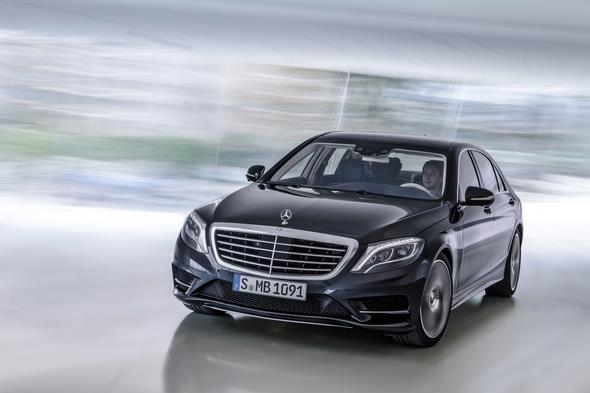
Sensors: intelligent networking of eyes and ears
Mercedes-Benz is making a major leap forward with the introduction of the Stereo Multi-Purpose Camera (SMPC), or stereo camera for short.
Just like the Multi-Purpose Camera (MPC) fitted previously, it is positioned behind the windscreen in the vicinity of the rear-view mirror.
It has an aperture angle of 45° and is capable of detecting the position and movement of objects, especially vehicles and pedestrians, in three dimensions in each case.
The “6D-Vision” technology nominated last year for the German Research Prize is used for this purpose for the first time.
The camera’s two “eyes” provide it with a three-dimensional view of the area up to around 50 metres in front of the vehicle, and it is able to monitor the overall situation ahead for a range of up to 500 metres.
In this way, the new camera is able to provide data for processing by various systems.
Intelligent algorithms evaluate this information in order to detect and carry out spatial classification of vehicles that are driving ahead, oncoming or crossing, as well as pedestrians and a variety of traffic signs and road markings within a large field of vision.
Whereas the stereo camera’s lenses act as the car’s eyes, the radar sensors are its ears, so to speak, and provide additional data about the distance from objects.
The system of radar sensors comprises two short-range radar sensors in the front bumper and in the side of the rear bumper with a range of 30 m and a beam angle of 80°, which are complemented by a long-range radar (200 m, 18°) including medium-range detection (60 m, 60°).
In addition, the multi-mode radar (80 m, 16° and 30 m, 80°) fitted at the front of the standard vehicle with COLLISION PREVENTION ASSIST is installed in the middle of the rear bumper.
The data from the camera and radars is amalgamated in a control unit in order to provide the system-specific data for the various functions.

Comfort-enhancing assistance with lateral lane guidance: DISTRONIC PLUS with Steering Assist and Stop&Go Pilot
The DISTRONIC PLUS adaptive cruise control is a driver aid designed to keep the vehicle at the desired distance from another vehicle in front that is travelling slower than the selected cruising speed.
This basic radar-based function has now been enhanced by the addition of a Steering Assist with Stop&Go Pilot, which helps drivers to stay centred in their lane by generating the appropriate steering torque when travelling on a straight road and even in gentle bends.
The stereo camera recognises lane markings as well as vehicles driving ahead together with their spatial positioning, and relays this information to the electric steering assistance system.
By generating the appropriate steering torque, the system can enhance ride comfort in the speed range up to 200 km/h and greatly assist the driver in many traffic situations.
At speeds up to 60 km/h, the Stop&Go Pilot ‘intelligently’ decides whether to use the vehicle in front or the road markings as a means or orientation, enabling semi-autonomous following of traffic jams even when there are no clear lane markings visible.
The system fuses the data gleaned from the stereo camera and the radar sensors, calculates any reactions required, and then regulates the vehicle’s linear speed as requirements dictate by controlling engine power, transmission and brakes, as well as actuating the electric steering for lateral vehicle guidance.
DISTRONIC PLUS with Steering Assist can be activated as before with a selector lever on the steering wheel in a speed range from 0-200 km/h, now also with the vehicle standing still and no vehicle moving ahead of it.
Any speed between 30 km/h and 200 km/h can be selected as the desired cruising speed.
The driver starts off in this case by pulling the DISTRONIC PLUS lever or tapping the accelerator.
A green steering wheel symbol appears in the instrument cluster to indicate when the Stop&Go Pilot is operating while DISTRONIC PLUS is activated.
Meanwhile, linear controlling actions (cruise control function) continue to be visualised in the speed display by means of circular segments and the speedometer needle.
The system’s design is so refined that the sensors can detect whether the driver’s hands are actually on the steering wheel.
If the system recognises that the driver has taken their hands off the steering wheel while the car is moving, depending on the situation, the detected surroundings and the speed, a visual warning is issued in the instrument cluster first; then a warning signal sounds and the Steering Assist is deactivated.
This is additionally indicated by changing the steering wheel symbol from green to white. The linear control action remains unaffected by this and continues to be available.
That means the system has an intelligent hands-off detection feature that brings the driver’s hands back to the wheel when necessary.
The use of DISTRONIC PLUS requires no change in driver behaviour – those who previously drove hands-free in a tailback can continue to do so (much more safely).
Thus, Mercedes-Benz offers relaxed driving mainly over long distances and on motorways, especially during otherwise tiring and annoying (slow) tailback tracking.
The performance capabilities of the basic DISTRONIC PLUS function have been increased once again.
Now, the system is able to brake at a rate of up to 5 m/s² without any intervention from the driver.
If the “S” drive mode button is pressed, the rate of acceleration increases, too. Vehicle acceleration is also far more dynamic if the driver signals a wish to overtake by switching on the indicators, assuming the adjacent lane is clear.
By combining the radar and camera data, DISTRONIC PLUS is now also able to detect both vehicles cutting in and vehicles ahead, and vehicles ahead of them, in one’s own lane and in adjacent lanes, and take any necessary action promptly.
This can prevent, for example, illegal overtaking on the inside lane on motorways and similar multi-lane highways by adapting the speed to that of vehicles in the outside lanes (at speeds above 85 km/h), especially when a tailback begins to dissolve and in streams of traffic.
At lower speeds, permissible overtaking on the inside lane with a maximum speed differential of 20 km/h is possible.
It goes without saying that the driver always can override DISTRONIC PLUS with Steering Assist.
For instance if they signal with their indicators that they wish to change lanes, the lateral assistance remains passive as long as it takes to change lanes.
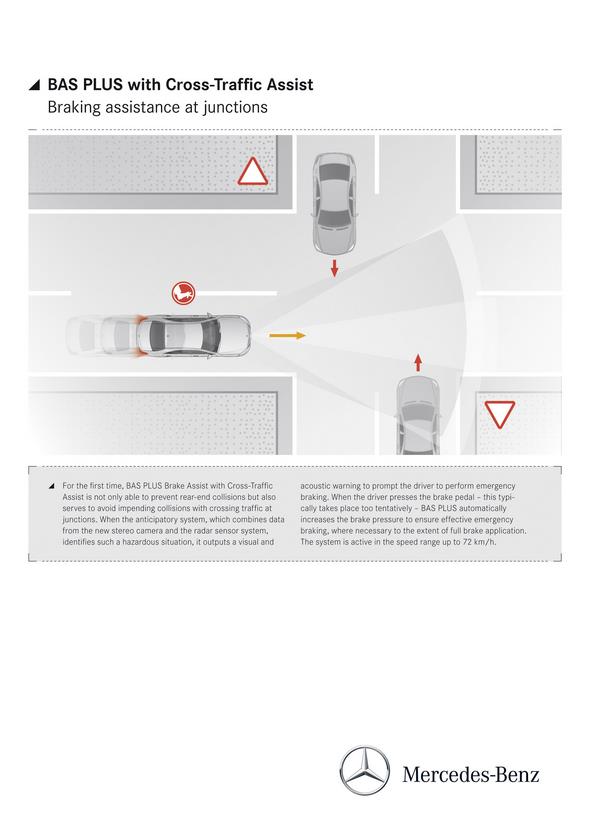
Braking assistance for cross traffic too: BAS PLUS with Cross-Traffic Assist
City centre junctions are a major accident blackspot. The collisions here can mostly be put down to driver distraction or misjudgement.
Whereas humans often react too slowly, assistance systems are immune to that brief moment of shock.
Apart from material damage, accidents at junctions often result in serious personal injuries, too.
The new Brake Assist BAS PLUS from Mercedes-Benz is therefore capable of more than just helping the driver to avoid collisions with vehicles ahead or lessen their consequences in a purely linear direction: the new Cross-Traffic Assist function can also come to the driver’s aid in critical situations with cross traffic at junctions.
If this anticipatory system detects a hazardous situation of this type, it prompts the driver to start emergency braking by activating visual and acoustic warnings.
If the driver presses the brake pedal too tentatively, BAS PLUS will step in by automatically boosting brake pressure for effective emergency braking, even applying the brakes at full power if necessary.
Applying just the right amount of braking power for the situation at hand maximises the available braking distance for traffic behind.
The Cross-Traffic Assist function is operative at speeds up to approx. 72 km/h, while BAS PLUS is able to aid the driver in linear situations at any speed.
Brake Assist BAS PLUS with Cross-Traffic Assist is potentially able to either prevent or lessen the severity of around 27 percent of all accidents at road junctions resulting in injury.
This equates to some 20,000 accidents a year in Germany alone (source: investigations carried out by the GIDAS – German In‑Depth Accident Study – and Mercedes-Benz Accident Research).

Detects broken lines too: Active Lane Keeping Assist
The new improved version of Active Lane Keeping Assist is now also able to intervene should the driver inadvertently cross a broken line when the neighbouring lane is not clear, meaning that a lane change could result in the risk of a collision.
The system can determine if this is the case using the information from the stereo camera and the radar system.
The latter has been supplemented by a sensor at the rear, which works in unison with the other sensors in the front and rear bumpers.
Active Lane Keeping Assist is not only capable of recognising critical situations such as overtaking vehicles, vehicles to be overtaken and parallel traffic, it can also respond effectively to oncoming traffic.
If the system detects the vehicle crossing the lane markings when the adjacent lane is not clear, not only does it cause the steering wheel to vibrate in pulses as a tactile warning for the driver, it guides the vehicle back into lane by applying a corrective braking force on one side via the ESP®, now also when the vehicles crosses broken lines.
It thereby complements the Active Blind Spot Assist, and for the first time also enables the often fatal collisions with oncoming traffic to be avoided.
Active Lane Keeping Assist is active at speeds between 60 and 200 km/h.
If driver activity in the form of active steering, braking or acceleration is detected, for example, or when the indicators are switched on, both the warning and the corrective brake actuation are suppressed.
Using the instrument cluster the system can be set for two levels – Standard or Adaptive.

Now recognises no-overtaking zones and access restrictions, too:
Traffic Sign Assist with wrong-way driver warning function
A new Traffic Sign Assist which builds on the capabilities of the previous Speed Limit Assist represents yet another contribution to accident prevention from Mercedes-Benz.
The system is now also able to recognise no-overtaking zones and alert drivers to no-entry restrictions.
The camera on the inside of the windscreen continues to pick up speed limit signs, including those on overhead gantries and in roadworks, for example.
The camera’s data is cross-referenced against the information in the navigation system and can be displayed in both the instrument cluster and the map view.
If the camera fails to spot any road signs showing a speed limit or a speed limit is lifted, the legal speed limits based on the navigation data are shown instead, such as a maximum speed of 100 km/h on country roads in Germany or 50 km/h in built-up areas. Supplemental signs are also recognised and displayed according to situation (e.g. “in the wet”).
No-overtaking zones and the signs signalling their end are also registered and displayed, while in the case of signs imposing access restrictions, through the wrong-way driver warning function an acoustic warning is emitted together with a visual warning in the instrument cluster – making an effective contribution towards helping to prevent serious accidents caused by
wrong-way drivers.

Visualising drowsiness: ATTENTION ASSIST
A quarter of all motorway accidents in Germany are put down to drowsiness, making it one of the most frequent causes of accidents, most of which are of a serious nature.
In 2009, Mercedes-Benz presented ATTENTION ASSIST, which is able to detect telltale signs of inattentiveness and increasing drowsiness based on changes in steering behaviour and a host of other factors.
The system has been subject to ongoing development, and the latest version has the ability to detect drowsiness and inattentiveness across a far greater speed range from 60 – 200 km/h.
Furthermore, the system’s sensitivity can be adjusted, e.g. for drivers who already feel tired when they get behind the wheel.
A new menu in the instrument cluster display also makes the system more tangible and transparent for the driver by visualising the current ATTENTION ASSIST level and the driving time since the last break.
What’s more, it is also possible to see whether the system is active in the current driving situation.
If the usual ATTENTION ASSIST warning recommending the driver to take a break is emitted, nearby service areas can be indicated in the navigation system.
The system can be deactivated by making the appropriate selection in the instrument cluster menu.
However, it will always be automatically reactivated with the sensitivity setting last selected the next time the vehicle is started.

Automatic manoeuvring into and out of parallel and end-on parking spaces: Active Parking Assist with PARKTRONIC
Active Parking Assist with PARKTRONIC enables automated parking with active steering and brake control in both parallel and end-on spaces.
It is an advanced version of the PARKTRONIC system with Parking Guidance offered previously.
What’s more, the system is now also able to manoeuvre out of parallel parking spaces again all by itself with automatic steering and brake control, assuming the vehicle was parked there automatically previously.
When travelling at speeds below 30 km/h, ultrasonic sensors with an extended range in the bumpers’ side sections survey the nearside of the road for suitable parallel and end-on parking spaces.
The same procedure is carried out for the far side of the road if the driver indicates accordingly.
A symbol in the instrument cluster shows that the system is in the process of measuring. If a suitable parking spot is identified, an arrow appears alongside the symbol indicating that the system is ready for automatic parking.
All the driver now has to do to activate the system is engage reverse gear and confirm by pressing the OK button on the steering wheel.
Active Parking Assist with PARKTRONIC steers and brakes the vehicle automatically as well as indicating the required driver actions in the display each time, such as the gear to be selected.
The driver moves the vehicle by lightly pressing the accelerator or releasing the brake.
Extended PRE-SAFE® protection
Prevention is better than cure
Ten years ago, Mercedes-Benz unveiled a groundbreaking safety concept in the form of the PRE-SAFE® anticipatory occupant protection system, which has been undergoing continuous refinement ever since.
Now, the safety pioneer is increasing protection levels once again.
The new PRE-SAFE® functions can help to prevent collisions with pedestrians and vehicles in front in city traffic, defuse dangerous situations caused by traffic behind and enhance the protection offered by the seat belts.
- The PRE-SAFE® Brake now also can detect pedestrians and initiate autonomous braking to avoid a collision at speeds up to 50 km/h.
- PRE-SAFE® PLUS can recognise an imminent rear-end collision and warn the following traffic by activating the rear hazard warning lights at a high frequency. If the danger of a collision persists, the system can also firmly apply the stationary vehicle’s brakes and thus minimise the risk of whiplash injuries by reducing the forward jolt caused by the impact. This additionally can reduce the risk of secondary accidents. Immediately before impact, the PRE-SAFE® anticipatory occupant protection measures, especially the reversible belt tensioners, are deployed.
- With PRE-SAFE® Impulse, the driver and front passenger are pulled away from the direction of impact by their seat belts at an early phase of the crash before the resulting occupant deceleration sets in. This can substantially reduce the risk and severity of injuries in a frontal collision.
Including pedestrian detection and City Brake function:
BAS PLUS with Cross-Traffic Assist and PRE-SAFE® Brake
Pedestrian detection has been added to the BAS PLUS with Cross-Traffic Assist and PRE-SAFE® Brake functions, while autonomous braking for vehicles in front has undergone a major enhancement too.
Thanks to the combination of stereo camera and radar sensors, it is now possible to detect pedestrians in front of the vehicle.
Visual and acoustic warnings are triggered when a hazard is spotted. If the driver then reacts by braking, the braking power will be boosted by BAS PLUS with Cross-Traffic Assist as the situation requires, right up to a full brake application. Should the driver fail
to react, the PRE-SAFE® Brake triggers autonomous vehicle braking.
The PRE‑SAFE® Brake with pedestrian detection is active up to approx. 72 km/h, and is able to prevent collisions with pedestrians autonomously up to an initial speed of 50 km/h.
Evaluations of GIDAS accident data by Mercedes-Benz indicate that this new technology could avoid six percent of pedestrian accidents and reduce the severity of a further 41 percent.
The operating range of the autonomous braking function for stationary vehicles has been optimised so that rear-end collisions can likewise be avoided at speeds of up to 50 km/h.
BAS PLUS with Cross-Traffic Assist and the PRE-SAFE® Brake with pedestrian detection rely on the same sensors employed for the adaptive cruise control DISTRONIC PLUS with Steering Assist: the new stereo camera plus the multistage radar sensor system.
Safety measures in response to an imminent rear impact: PRE-SAFE® PLUS
PRE-SAFE® PLUS offers an extension of the familiar occupant protection measures in situations where traffic behind poses a danger.
A radar sensor in the rear bumper monitors the traffic behind the vehicle. If the risk of an impact from the rear is detected, the rear hazard warning lights are activated with a high frequency (5 Hz) to alert the driver of the vehicle behind (not on vehicles with USA/Canada coding).
If the vehicle is stationary and the driver wishes it to remain so (e.g. by applying the brakes, activating the HOLD function or engaging “P” using the selector lever), if the danger of a collision persists PRE-SAFE® PLUS comes to the driver’s aid by increasing the brake pressure in order to keep the vehicle firmly braked.
In addition, immediately before impact the PRE-SAFE® anticipatory occupant protection measures, especially the reversible belt tensioners, are deployed.
Keeping the vehicle firmly braked when another vehicle hits it from behind greatly reduces the strain placed on the occupants, such as the risk of whiplash injuries.
At the same time, it serves to protect other road users too by restricting uncontrolled vehicle movements after the initial impact that could lead to secondary collisions, such as running into a vehicle in front or colliding with pedestrians or other road users at junctions.
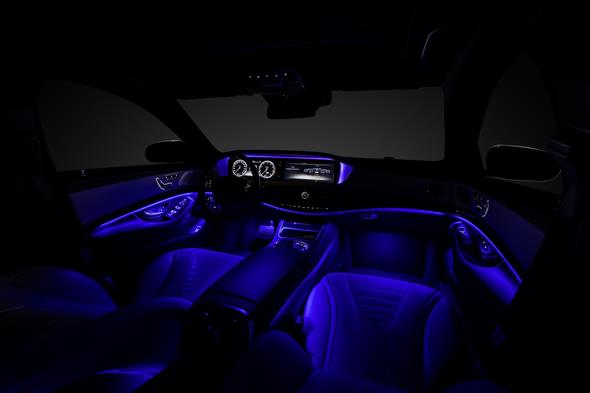
Intelligent countermovement: PRE-SAFE® Impulse
Mercedes-Benz is extending the front seat belt’s protective function with the introduction of PRE-SAFE® Impulse: at an early phase of the crash, before the resulting deceleration sets in, the front occupants are pulled away from the direction of impact and deeper into their seats by their seat belts.
By the time the accident enters the phase when loads peak, the extra distance they are retracted by can be used while dissipating energy in a controlled fashion thanks to additional force limiting in the belt buckle.
Pre-acceleration and force limitation allow the occupants to be temporarily isolated from the effects of the crash, significantly reducing the risk and severity of injuries in a frontal collision.
With PRE-SAFE® Impulse, the seat belt strap can be retracted by pyrotechnic means at all three belt anchorage points, both in the pelvis and chest area, and released again with controlled force at the buckle and in the shoulder area.
The fundamental difference compared to conventional belt tensioners is that the force for retracting the belt strap is maintained more consistently for a much longer time.
The deployment logic fires the seat belt system’s belt tensioners progressively depending on the seriousness of the accident.
In this way, the tensioning force can be adapted as required. The PRE-SAFE® Impulse system is integrated in the seat’s structure and supplements the pyrotechnic reel tensioner with a pyrotechnic buckle and anchor fitting tensioner including central gas generator.
Extended protection in the rear
Top safety level in the rear
Mercedes-Benz is further reinforcing the safety system for passengers in the rear with the seat belt buckle extender, the beltbag and the cushionbag.
In contrast to many other manufacturers, the seat belts in the rear already include belt tensioners and belt force limiters today.
Both systems were furthermore developed with a particular view toward new markets in Asia.
There, the occupancy rate in the rear is as much as 30 percent, making it much higher than in Europe.
Reducing the belt slack: the seat belt buckle extender
With the seat belt buckle extender, an electric motor extends and retracts the belt buckle automatically.
In this way, buckling up can be made more convenient, and any belt slack in the area of the pelvis and thorax can be reduced even when belting up so that passengers are secured more firmly in both the sideways and the lengthways direction.
The seat belt buckle extender fits in with Mercedes-Benz’s integral safety concept.
In keeping with an all-embracing approach to safety, this concept covers all phases of automotive safety: from safety while driving through safety in hazardous situations and protection in the event of an accident to minimisation of the consequences of accidents.
The innovation is classic Mercedes-Benz, improving safety and comfort in one.
This is because fastening seat belts in the rear is also made much simpler: the seat belt buckle emerges from the upholstery when the rear doors are opened and is provided with an illuminated insertion slot.
Simplifying use of the seat belt in this manner may increase the percentage of rear passengers who buckle up.
It also makes it easier to assist children or people who require help in fastening their seat belts.
The seat belt buckle extender is furthermore integrated in the PRE-SAFE® anticipatory safety system.
This means that whenever PRE-SAFE® becomes active in critical driving situations or when the system detects the vehicle approaching other objects at a critical speed, reversible belt tensioning is also performed in the rear via the seat belt buckle extender function.
The restraint system and the passengers are thus better prepared for a possible accident situation.
In this way, the seat belt buckle extender complements the pyrotechnic belt tensioning which has featured as standard on all outer rear seats in Mercedes-Benz vehicles for many years now, and is triggered in the event of an impact exceeding a certain severity.
The seat belt buckle extender is a motorised belt buckle which can be extended upwards by up to 50 millimetres and retracted by up to 40 millimetres.
The belt buckle is attached via a cable to a nut which runs on a spindle, translating the electric motor’s rotary movement into a linear movement.
The following functions are carried out by means of this movement:
- Seat belt reminder/fastening aid: the seat belt buckle extender is provided with an illuminated insertion slot, attracting the occupants’ attention to the buckle. Particularly in the dark, this makes it easier to find the belt buckle and connect it with the seat belt tongue. In addition, the belt buckle is extended by up to 50 millimetres when occupants enter the rear of the vehicle, to facilitate fastening of the seat belt. When extended, the belt buckle is more readily accessible and it is easier to insert the belt tongue. Both functions are activated when the doors are opened by passengers entering the rear of the vehicle.
- Minimised belt slack: after the belt tongue has been inserted, the belt buckle returns to its original position. This reduces any belt slack in the area of the pelvis and thorax, and ensures that the belt fits correctly in the pelvis area.
- PRE-SAFE® function for rear occupants: the seat belt buckle extender is fully integrated in the vehicle’s PRE-SAFE® Whenever PRE‑SAFE® becomes active in critical driving situations or when the system detects the vehicle approaching other objects at a critical speed, reversible belt tensioning is now also performed in the rear via the seat belt buckle extender function. The restraint system and the passengers are thus better prepared for a possible accident system. In contrast to its extended position to facilitate fastening of the seat belt, the belt buckle is retracted by approx. 40 millimetres instead. This reversible function tightens the belt on the occupant by up to 80 millimetres. In addition, the belt buckle branches off at a lower point at the occupant’s hip. This reduces the risk of the pelvis submarining under the belt. Securing the occupants more effectively in this way can reduce the strain to which they are exposed in the event of an accident. The seat belt buckle extender complements the pyrotechnic belt tensioning which has featured as standard in Mercedes-Benz vehicles for many years now
and is triggered in the event of an actual impact. - POST-SAFE functionality: to facilitate the rescue of occupants and to assist rescue personnel or the occupants themselves in unbuckling the seat belts, the belt buckle is extended once again as soon as the doors are opened by rescue personnel or the occupants themselves after the system has detected a crash and the vehicle has come to a standstill, provided that the on-board electrical system is intact. The raised belt buckle position allows better access from inside the vehicle, while illumination of the buckle draws attention to the opening mechanism.
An airbag for seat belts: the beltbag
The beltbag is an inflatable seat-belt strap that reduces the load on the ribcage in a head-on collision and is thus able to reduce the risk of injury to passengers in the rear.
Because dummy measurement technology is not capable of quantifying the benefits resulting from a wider belt strap, such as the lower force exerted on occupants in the rib area in particular, the safety experts at Mercedes have been working intensely with virtual human models too, as such computer-generated models make it possible to obtain detailed findings on the biomechanical strain during a collision.
Should the crash sensors detect a severe frontal impact, the airbag control unit will trigger deployment and inflation of the beltbag.
A gas generator then inflates the multi-layered belt strap with Velcro seams to nearly three times its normal width.
The resulting larger surface area is able to better distribute the force acting on the seat occupant, thereby reducing the risk of injury.
The beltbag is used in exactly the same way as a conventional seat belt.
The belt strap’s design is different from that of the standard belt though, and received top marks in practical trials for being extremely comfortable to wear and for its extra-soft belt strap edge.
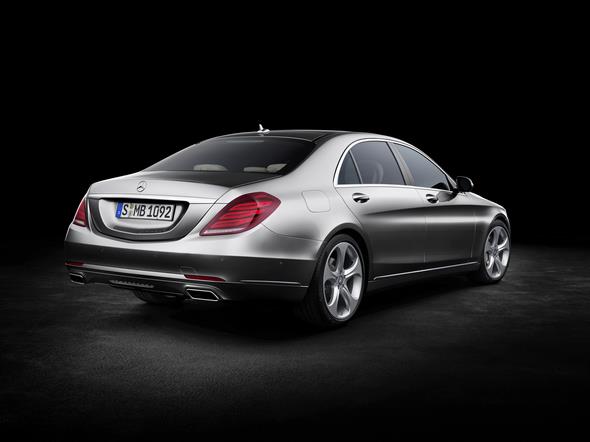
An airbag for the seat: cushionbag
If the S-Class is equipped with the Executive seat (reclining seat), the seat includes the innovative cushionbag as standard.
The airbag is located under the seat cushion upholstery, but on top of the plastic seat shell, which is moved by the seat mechanisms.
This means that the airbag is always in the right position relative to the occupant.
In an accident, with the occupant in a reclined position on a flat seat cushion, without additional measurers there would be a danger of the pelvic area sliding beneath the seat belt (submarining).
This can be prevented by the cushionbag, as it raises the front section of the seat cushion upholstery.
The airbag is only activated if the seat is in the reclined position during a crash. It is not activated in the upright position, as there is then no danger of submarining.
Bodyshell and passive safety
Maximum stability and high-quality lightweight design
A high level of crash safety, lightweight design, outstanding rigidity
for excellent handling with extremely low levels of noise and vibration.
These were the aims when developing the bodyshell for the new S-Class.
Application of the 3D Body Engineering approach has given it a third-generation aluminium hybrid bodyshell.
The lightweight index – the torsional stiffness in relation to weight and vehicle size – has been improved by 50 percent compared to the predecessor model.
The bodyshell is the vehicle’s functional backbone. All statutory, rating-relevant and internal crash load requirements are met, and even future requirements are already taken into account.
To further improve suspension comfort, the shear forces acting at the force application points in the bodyshell had to be increased.
These requirements were also met thanks to appropriate component design and special joining technology in the bodyshell.
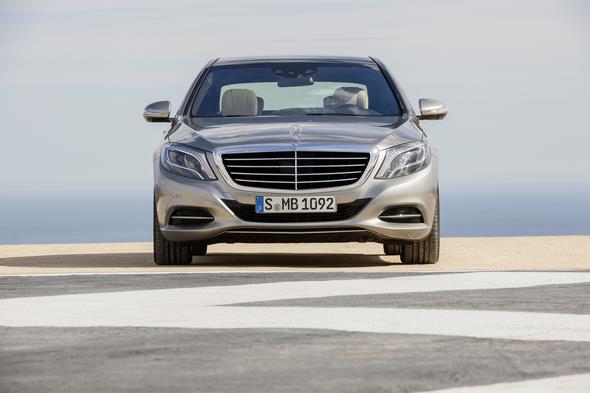
The lightweight index has been improved by 50 percent compared to the predecessor model.
This index defines the torsional stiffness in relation to the vehicle’s size (footprint) and weight.
To this end, all the relevant node areas were optimised and systematically reinforced with respect to the force distribution.
The aim of the NVH measures for the bodyshell was to better the already very good preceding model with respect to vibration and noise comfort, but without dispensing with intelligent lightweight construction methods.
The bodyshell structure of the new S-Class reaches new heights in dynamic rigidity thanks to new structural concepts and specific NVH measures in the bodyshell.
These include:
- Integral NVH front section concept consisting of extruded aluminium side members, cast aluminium elements at the transition between the front section and passenger cell, also at the damper domes, and integral carrier as vibration-damping structural component
- Increased use of bracing struts for specific increases in rigidity
- Rear panel and cockpit cross-member of hybrid metal/plastic construction
- Use of foam sections in the A/B/C-pillars to increase bodyshell rigidity
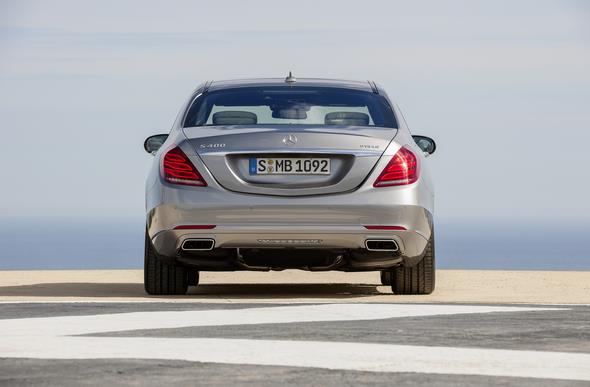
No weight increase in 20 years – despite stricter requirements
Since the 220 model series was developed in the 1990s, with an optimally coordinated materials mix the hybrid lightweight construction has been further developed into an aluminium hybrid bodyshell.
During this period the share of aluminium has increased to more than 50 percent.
It has therefore been possible to maintain practically the same body weight for 20 years and even slightly reduce it, despite far more stringent comfort and safety requirements and additional functions.
In addition to this, structural foams are used at specific points in node areas in the new model series.
The entire outer skin of the S-Class, including the roof and the front section of the body, consists of aluminium.
The high percentage of aluminium is possible thanks to the use of the complete range of semi-finished products (cast, extruded and sheet aluminium).
The safety passenger cell makes intensive use of high-strength steels.
This lightweight design by material and geometrical optimisation coupled with highly complex joining technology allows the new S-Class to further raise the bar in the demanding luxury saloon segment – without adding weight.
With a torsional stiffness of 40.5 kN/degree (predecessor: 27.5 kN/degree), the S-Class achieves a new record in its segment.
Focus on driving dynamics: lightweight-construction measures
The front section is one of the preferred lightweight-construction zones for achieving balanced weight distribution of the entire vehicle.
The decision to use aluminium as a lightweight material in this area was therefore made at an early stage.
As well as being lighter than its steel counterpart, the aluminium front section also greatly enhances crash and NVH performance.
Cast aluminium and extruded aluminium sections are used in addition to sheet aluminium.
Die-cast aluminium was chosen for the shock absorber strut bracket because of its good integration properties.
In this way it was possible to connect the front module without additional holders, for example.
As well as reducing the number of components, die casting also enables the component to be designed to withstand specific loads and stresses.
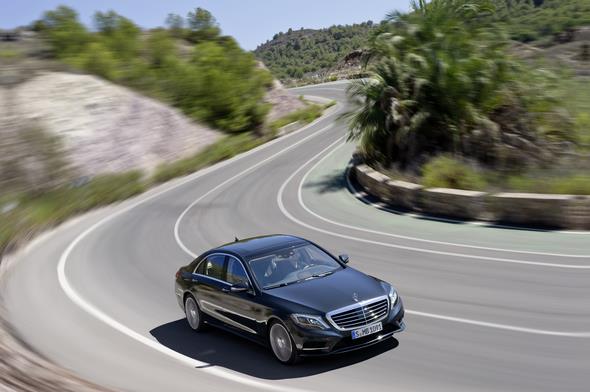
Morphological analyses were conducted to configure the wall thicknesses and geometry of the component so as to meet the strict functional requirements accurately.
In addition to local optimisation of the introduction rigidity at the shock absorber strut bracket and at the integral carrier, a cross-functional load path was conceived to further improve the system as a whole.
The aluminium struts running in X-direction from the shock absorber strut bracket to the cowl provide support in the event of a crash.
Supplemented by a multipiece framework, these struts also help to suppress the Y-movement of the side members.
This design allowed the new load path to be incorporated into the limited package installation space in the front section.
The forces are applied to the bodyshell structure in the three-piece cowl, which has been configured as a cast aluminium component in the centre section.
In this case too, the casting allows a functionally perfect connection with distinct advantages in terms of weight and installation space.
The side members have been designed as combined aluminium extruded sections/castings to optimise crash performance, rigidity and component integration.
The protrusions of the extruded aluminium sections of the side members required for package reasons have been designed to also have a positive effect on folding behaviour in the event of a crash.
The cavity closed by a foam piece is also used as a resonance volume for the Frontbass system.
The side members are connected to the steel passenger cell by means of cast aluminium components that allow a very rigid connection and integration of the integral carrier connection.
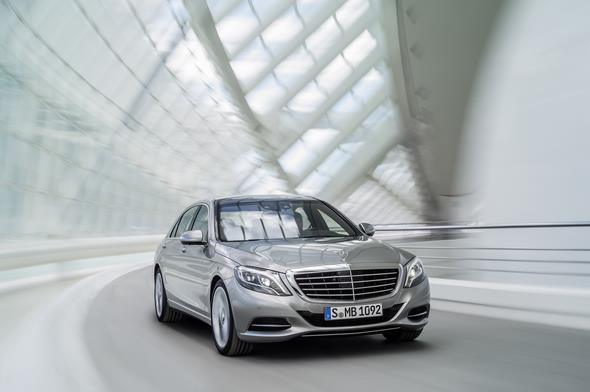
Clever combination: sophisticated steel and aluminium joining technology
The firewall area is a sheet steel construction. As well as meeting the functional requirements perfectly, this design also allowed integration of the complex hybrid joint between the aluminium front section and the steel cell.
Here one of the major challenges was the mechanical joining technology used for the sophisticated high-strength steels.
In addition to the front section, the integral carriers are also made of aluminium and boast the lowest weight in their class.
As well as acting as a component carrier for numerous components, the integral carrier is a central component of the front-end structure when it comes to performing crash and NVH functions.
Compared to the previous model series, the complete cooling module is fastened to the integral carrier in addition to the engine, steering, torsion bar and front axle.
The integral carrier’s side members also form the third crash load path in the front section.
In order to meet these multiple requirements yet still maintain a lightweight design, a complex aluminium mix comprising die castings/permanent mould castings, extruded sections and sheet metal parts was also required here.
The roof is another key area for lightweight design as reducing weight here has a positive effect on the vehicle’s centre of gravity and on NVH characteristics.
The new S-Class features an aluminium roof – a first at Mercedes-Benz. A major challenge here was integrating the roof into a steel structure.
This was achieved by implementing an efficient and simple assembly solution in the bodyshop, which involves the roof being fixed to the bodyshell structure using shackles with defined spacing for the purpose of production in the factory.
The resulting gap between the bodyshell structure and the roof ensures that the components are coated completely during the cathodic dip priming process.
One particular lightweight-construction measure involves the use of structural foam pieces in functionally critical node areas to ensure high NVH performance.
Preliminary investigations have shown that comparable performance could only have been achieved by means of solid reinforcements, some of which would have required one-sided joining processes.
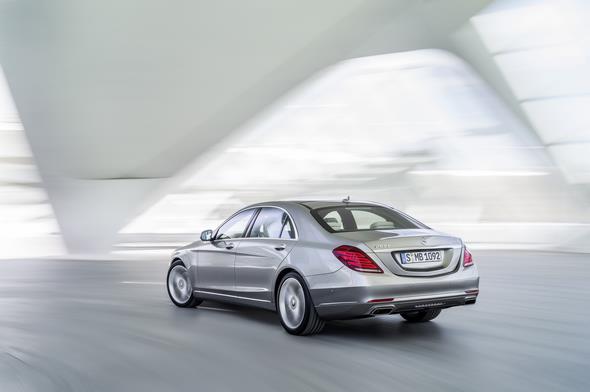
Such reinforcements would have resulted in a double-figure increase in the bodyshell weight.
Due to the way the foam pieces work, it is possible to position them precisely in the functionally critical node areas, since there is no need to take account of production-specific requirements such as joining technology limitations or component joining sequences.
Furthermore, it is even possible to achieve frictional connections between cross-sections with several chambers.
Safety first: passenger cell made using high-strength steels
The safety passenger cell consists primarily of steel. Thanks to the use of higher steel grades, the weight has been kept the same as for the predecessor model although far more stringent crash requirements (angled mast) and stricter NVH requirements are met.
All relevant components have been increased by one class in terms of material quality, one example being in the area of the B-pillar, roof frame and tunnel reinforcement, where thermoformed ultra-high-strength steels that have been weight-optimised as tailored products with different sheet thicknesses are used.
In the lower side member area, an ultra-high-strength steel (CP 1000) is used as a roll-profiled component for the first time.
This steel-based lightweight design by material optimisation is also backed by lightweight design by geometrical optimisation, including the formation of a frictional connection between the C-pillar and the rear centrepiece, which allows efficient support of the rear section’s side members when the vehicle flexes.
In the case of detachable body parts such as the wings, bonnet and boot lid, the use of aluminium adopted for the previous model series was continued.
The aim was to outperform internal and external competitors in terms of weight and to effectively implement the design in production whilst meeting strict requirements in terms of joins and seams.
Proof that sophisticated design, lightweight construction and production-friendly product design can actually go hand in hand.
The aluminium hybrid design results in the use of additional mechanical joining technologies.
The technical limits of the processes for these joining technologies were determined in collaboration with the supplier, the planning department and production.
Consequently it was possible to combine high-strength sheet metal with aluminium for the first time and to reduce the sheet thickness of the components primarily from a functional standpoint.
Only thanks to the interaction of lightweight-construction measures and lightweight-construction processes was it possible to make use of the 50 kg lightweight design potential.
Conversely it was then possible to invest in a massive way in performance – in safety, comfort and customer benefit.
Result: the bodyshell of the new S-Class is not only lighter, but also clearly tops in performance.
Restraint systems: meticulous design of every detail
Alongside the deformation potential of the body and major components, as well as the stability of the passenger cell, it is the quality of the restraint systems that largely determines the risk of injury to the occupants in the event of an accident.
The crash sensors, including appropriate software adaptation to detect the accident type and the collision severity, have been further refined compared to the predecessor model series. New components and features:
- STAR2 electronic control unit
- Pressure sensors for detecting collisions with pedestrians
- Use of sitting position information for adaptive control of the restraint systems
As standard, the driver and front passenger each have a three-point seat belt with triple pyrotechnic retractor tensioning.
Retractor tensioning and belt force limiting as well as an electrically reversible inertia reel tensioner are effective via the shoulder belt.
The upper belt guide point is anchored to the B-pillar and height-adjustable. The PRE-SAFE® Impulse tensioning system is a world first in the new S-Class (see “Extended PRE-SAFE® protection” section).
The rear passengers in the two outer seats have three-point seat belts with inertia-reel tensioner and self-adaptive force limiter, while the centre seat features a standard three-point seat belt system.
As optional extras, the seat belt buckle extender, beltbag and cushionbag elevate rear safety to a new level (see “Extended rear protection” section).

Driver and front passenger airbags: adaptive filling
The driver’s airbag (volume approx. 64 litres) is equipped with a two-stage gas generator.
Two stages can be activated, depending on the detected vehicle deceleration values, with a delay between triggering of the two stages.
In addition to the two-stage gas generator, the front passenger’s airbag (volume approx. 112 litres) has a special feature in the form of a pyrotechnically activated adaptive stage.
The cushioning of the occupant when plunging into the airbag is made harder or softer depending on the sitting position and gas filling, according to requirements.
The thorax/pelvis sidebags for the driver and front passenger with a volume of 17 litres are integrated in the front seat backrests whilst the rear sidebags with a volume of 12 litres are integrated in the rear side panelling where they are firmly attached to the bodyshell.
In the event of a crash, the windowbag cushion (volume approx. 40 litres) is filled by a hybrid gas generator that is located in the roof area behind the B-pillar.
The use of a new weaving technology (X-Tether technology) makes the windowbag cushion more stable, meaning that it is easier to ensure effective inflation over a prolonged period of time.
Triggering of the side protection systems is controlled by the Star2 electronic triggering device, which can detect and assess a side collision with the help of a central acceleration sensor, additional satellite sensors in vehicle lateral direction and pressure sensors in the doors.
Furthermore, the belt tensioners are triggered together with sidebags and windowbags if a side collision is detected and together with the windowbags if roll-over is detected.
Pedestrian protection: active bonnet and more deformation space
To supplement the active safety measures which help to prevent accidents or reduce the severity of accidents, the measures aimed at mitigating the consequences of accidents in the event of collisions with pedestrians have been further developed for the new S-Class.
In order to reduce the loads exerted on a pedestrian if their head hits the bonnet of the vehicle, the deformation space between the bonnet and the components beneath it has been optimised.
This is achieved in part by appropriate positioning of components such as control units or fluid reservoirs in the engine compartment.
The S-Class also features an active bonnet. In the event of a collision with a pedestrian, sophisticated sensors combined with intelligent algorithms trigger pyrotechnic actuators in the area of the bonnet hinges.
These raise the bonnet by around 80 millimetres. The deformation characteristics of the bonnet have been developed specifically to meet these requirements.
Further reductions in the impact loads can be achieved by using aluminium and by homogenously reinforcing the inside face of the bonnet.
Furthermore, the hardness of the foam in the front bumper has been optimised to reduce the load exerted on the pedestrian’s legs in the event of an impact.
Drive system
Class-leading efficiency in every output category
In its first year the new S-Class line-up features two hybrid versions, a petrol model and a diesel variant: S 400 HYBRID, S 500, S 350 BlueTEC and S 300 BlueTEC HYBRID.
All models boast class-leading efficiency and up to 20 percent lower fuel consumption than the predecessor model.
All the engines already meet the requirements of the Euro-6 emissions standard.
In addition to this, the S 400 HYBRID and S 350 BlueTEC meet the strict criteria of efficiency class A, while the S 300 BlueTEC HYBRID even has
an A+ rating.
“The new S-Class achieves consumption and emissions figures that only a few years ago would have seemed utopian even in the intermediate class,” says Prof. Thomas Weber, member of the Daimler Board of Management responsible for Group Research and Head of Mercedes-Benz Cars Development.
“And this is just the start of our ‘Green Leadership’ initiative: soon to be followed by the
S 500 Plug-In HYBRID – the first S-Class with a fuel consumption lower than four litres per 100 kilometres.
” The S-Class line-up therefore includes the full range from petrol and diesel models to petrol, diesel and plug-in hybrids for the first time.
Effective helpers: ECO start/stop function and ECO display
The excellent consumption and emission figures are also due to the ECO start/stop function specified as standard for all S-Class models.
The ECO start/stop function switches the engine off as soon as the vehicle stops – for example at traffic-lights – and the driver keeps the brake pedal depressed after coming to a halt.
The engine restarts immediately when the driver releases the brake pedal.
One of the features that assists the driver is the ECO display in the instrument cluster. If required, three bar charts give the driver feedback about the economy of their driving style.
The ECO display responds positively if the driver accelerates moderately, drives smoothly in an anticipatory manner and avoids unnecessary braking.
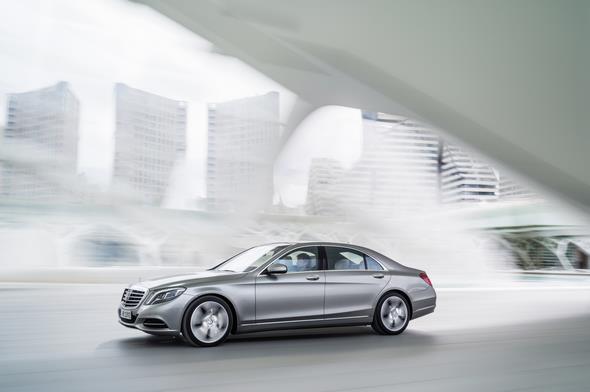
The three bar readings stand at 100 percent if driving is particularly economical according to these criteria.
When starting off all the values are at 50 percent, and a particularly unfavourable driving style causes them to decline.
The aim is to arouse a competitive desire in the driver to achieve 100 percent if possible.
Further efficiency-enhancing measures include outstanding aerodynamics, intelligent lightweight construction, second-generation low-rolling-resistance tyres, an electronically controlled refrigerant compressor, and the new “ECO Thermo Cover” engine compartment encapsulation in the S 300 BlueTEC HYBRID, which reduces cold-starting losses and consists of insulating partitions in the engine compartment and the radiator shutter, which closes when the engine is stopped.

The “energy-transparent vehicle” tool created in-house by Mercedes-Benz was used as part of the S-Class development process.
This method detects the possibilities for optimisation in even the most minute component.
An exact and meticulous examination of the flow of energy throughout the vehicle (tank to wheel) helps the development engineers to optimise every single assembly that has an impact on fuel consumption, right down to individual wheel bearings.

S 300 BlueTEC HYBRID: energy efficiency class A+
Mercedes-Benz has practically halved fuel consumption in the 150 kW output category within ten years: the S 300 BlueTEC HYBRID has a combined fuel consumption of just 4.4 litres per 100 km (CO2: 115 g/km) and meets the criteria of energy efficiency class A+.
In the S 300 BlueTEC HYBRID, Mercedes-Benz has combined the 2.2-litre
four-cylinder diesel engine developing 150 kW (204 hp) with a powerful hybrid module.
Its 20 kW electric motor, positioned between the internal combustion engine and the 7-speed automatic transmission, assists the diesel engine when the car is accelerating (boost effect) and, in alternator mode, is used for the recuperation of braking energy, although it is also suitable for driving under electric power alone.

S 400 HYBRID: 20 percent more economical than the preceding model
Even in the previous model series, the S 400 HYBRID was the world’s most economical petrol-engined luxury saloon for some time.
With the hybrid model, which combines a V6 petrol engine with a compact hybrid module, the Mercedes‑Benz engineers have made further advances in efficiency: the new S 400 HYBRID boasts NEDC (combined) fuel consumption of just 6.3 litres per 100 kilometres – a reduction of 20 percent compared to the preceding model.
The CO2 emissions figure of 147 grams per kilometre is likewise a new record in this vehicle segment.
These exemplary figures are coupled with outstanding performance potential: the petrol engine develops 225 kW (306 hp) – and the electric motor adds another 20 kW. The peak torque is 370 Nm (+250 Nm).

The compact hybrid module is a disc-shaped electric motor that also acts as a starter and generator.
The system offers a double benefit, as it both helps to save fuel and, due to the booster effect of the electric motor, powerfully backs up the internal combustion engine during the high-consumption acceleration phase.
The S 400 HYBRID accelerates from 0 to 100 km/h in 6.8 seconds and reaches an electronically limited top speed of 250 km/h. The S 400 HYBRID can drive all-electric up to half a kilometer.
When the vehicle decelerates, the electric motor acts as a generator and can recuperate the braking energy.
The recuperated energy is stored in a compact yet highly efficient lithium-ion battery in the engine compartment and made available when required.
S 500: the most efficient V8 petrol model in the luxury class
The V8 biturbo unit in the S 500 has a displacement of 4663 cc and an output
of 335 kW (455 hp) – making it more powerful than its 320 kW (435 hp) predecessor.
Its peak torque is 700 Nm, while NEDC fuel consumption is just 8.6 litres per 100 km (premium unleaded) – 0.7 litres per 100 km lower than its predecessor. CO2 emissions are 199 g/km.
The excellent efficiency goes hand in hand with superior performance: the S 500 sprints from zero to 100 km/h in an impressive 4.8 seconds. Its top speed is 250 km/h (electronically limited).
S 350 BlueTEC: V6 with the fuel consumption of a four-cylinder engine
The V6 diesel engine in the S 350 BlueTEC has a displacement of 2987 cc, an output of 190 kW (258 hp) and a torque of 620 Nm.
Its combined fuel consumption of 5.5 or 5.6 litres per 100 kilometres (diesel fuel; figures for short/long wheelbase versions) makes it the world’s most economical V6 diesel and puts it on a par with the previous four-cylinder S 250 CDI model.
The S 350 BlueTEC has CO2 emissions of 146 or 148 grams per kilometre (figures for short/long wheelbase versions), and it is equipped with the second-generation AdBlue® emission-control system.
Model data at a glance:
| Model | S 400 HYBRID | S 500 | S 350 BlueTEC | S 300 BlueTEC HYBRID |
| Number of cylinders/arrangement | 6/V | 8/V | 6/V | 4/in-line |
| Displacement (cc) | 3498 | 4663 | 2987 | 2143 |
| Rated output (kW/hp at rpm) | 225/306 at 6500 | 335/455 at 5250 | 190/258 at 3600 | 150/204 at 4200 |
| Rated output of electric motor (kW) | 20 | – | – | 20 |
| Rated torque (Nm at rpm) | 370 at 3500-5250 | 700 at 1800-3500 | 620 at 1600-2400 | 500 at 1600-1800 |
| Rated torque of electric motor (Nm) | 250 | – | – | 250 |
| Combined fuel consumption from (l/100 km) | 6.3 | 8.6 | 5.5/5.61 | 4.4 |
| Combined CO2 emissions from (g/km) | 147 | 199 | 146/1481 | 115 |
| Efficiency class | A | D | A | A+ |
| Acceleration 0-100 km/h (s) | 6.8 | 4.8 | 6.8 | 7.6 |
| Top speed (km/h) | 250 | 250 | 250 | 240 |
1 Figures for W222/V222 (short/long wheelbase)
7G-TRONIC PLUS: outstandingly smooth gear changes as standard
All new S-Class models feature the 7G-TRONIC PLUS automatic transmission with DIRECT SELECT lever as standard.
The features of the latest version to emerge include a new torque converter with reduced slip, an ECO shift mode with a wider ratio spread and an auxiliary oil pump to maintain the operating pressure during automatic stops.
Low-friction components and low-viscosity oil help to reduce the operating pressure.
Suspension
The world’s first suspension system with “eyes”
The new S-Class is the world’s first car to be able to detect bumps on the road ahead. If the ROAD SURFACE SCAN detects such unevenness by means of the stereo camera, MAGIC BODY CONTROL sets up the suspension in advance to deal with the situation.
This innovative suspension system is available as an option for the eight-cylinder models.
Standard equipment for the new S-Class includes an enhanced version of the full air suspension system AIRMATIC with continuously adaptive damping control.
The front axle features four-link suspension. Its key characteristics include two individual links (torque strut and spring link) in the lower link plane.
The transversely situated forged-aluminium spring link carries the spring strut.
The anti-roll bar is connected directly on the steering knuckle, while the forward-sloping torque strut is made of forged aluminium.
A wishbone located high above the lower link plane performs further wheel location functions.
This link is also made of forged aluminium, as is the steering knuckle which connects the upper and lower link planes.
The fourth link is the track rod which forms part of the rack-and-pinion steering system. The transversely situated steering gear is located in front of the wheel’s centre.
The arrangement and design of the wheel location components offer favourable characteristics for the axle kinematics: the kingpin inclination is close to the wheel centre.

This provides for large longitudinal force leverage, thus minimising sensitivity to tyre imbalances and fluctuations in braking force.
The lower front axle components, the steering gear and the engine mounts are linked with an assembly carrier.
This integral carrier, made from high-strength sheet aluminium, is directly bolted to the body.
Due to the unsurpassed wheel location qualities, the S-Class features multi-link rear suspension attached to a subframe.
Consistent lightweight construction minimises the weight of the unsprung masses. Four of the five wheel-locating links are made of forged aluminium, as is the hub carrier.
The spring link that carries the spring strut is made of single-ply sheet aluminium.
In the standard configuration, the rear axle with air suspension features a torsion-bar stabiliser which is directly connected to the rear axle carrier.
AIRMATIC: enhanced comfort and driving dynamics
The standard-fit full air suspension system AIRMATIC with continuously adaptive damping control allows the spring travel to be maintained whatever the vehicle load by means of continuous level adjustment.
The vehicle level is controlled automatically depending on the vehicle speed. It is lowered by up to 20 millimetres when the speed exceeds 120 km/h.
Consequently, aerodynamic drag is lowered and, thanks to the low vehicle centre of gravity, directional stability is enhanced.
The AIRMATIC system with continuously adaptive damping control that featured on the predecessor model has been modified in many respects: new air suspension bellows with reduced breakaway torque make for even better ride comfort as they do not stiffen as much at low amplitudes and larger frequencies.
The spring travel on the rear axle has been increased, thus improving absorption capacity if excitation is high.
To further reduce tyre noise, the air suspension struts on the rear axle are decoupled from the body.
The lower control panel on the centre console allows the driver to raise the vehicle level by 30 millimetres on poor road surfaces or when confronted by a tricky garage entrance, for example.
Further improvements have likewise been made to the adaptive damping system. This fully automatic, electronically controlled system adjusts the shock absorbers on each wheel as required.
As before, the single-tube shock absorbers are equipped with a valve each for the compression and rebound stage, while there is a new feature in the shape of continuous damping adjustment.
This means that the optimum operating point can be selected every time based on various data such as acceleration, vehicle level or vehicle speed.
A button on the centre console allows the driver to select a sportier setting as an alternative to the comfort-oriented default setting.
The different AIRMATIC levels at a glance:
| Setting | Comfort | Sport | |
| Higher level (manual) | + 30 mm | + 30 mm | |
| Lower level (automatic) | Generally | – 10 mm | |
| From 120 km/h | – 10 mm | – 10 mm (in total: – 20 mm) | |
| From 160 km/h | – 10 mm (in total: – 20 mm) | ||
If certain vehicle speed thresholds are exceeded or not reached, the normal vehicle level is restored automatically.

MAGIC BODY CONTROL: the world’s first suspension system with “eyes”
The new S-Class is the world’s first car to be able to detect bumps on the road ahead.
The MAGIC BODY CONTROL suspension system available as an option for the eight-cylinder models includes ACTIVE BODY CONTROL (ABC) and the new and innovative ROAD SURFACE SCAN function.
The “eyes” for the ROAD SURFACE SCAN function are provided by a stereo camera fitted behind the windscreen, which scans the road up to 15 metres ahead of the vehicle and delivers a precise image of the road contours.
Based on the camera pictures and driving status information, the control unit constantly calculates the best control strategy for overcoming unevenness such as prolonged bumps.
The vehicle can therefore adjust the damping of each individual wheel to a tauter or softer setting in advance and increase or reduce the load on the wheel by means of an active hydraulic system.
The suspension is adapted to a given situation within fractions of a second, and body movement can be reduced considerably.
This results in a hitherto unprecedented level of ride comfort. Because ROAD SURFACE SCAN is camera-based, it can work throughout the day if visibility is good, the road structure is suitable and even at speeds of up to 130 km/h.
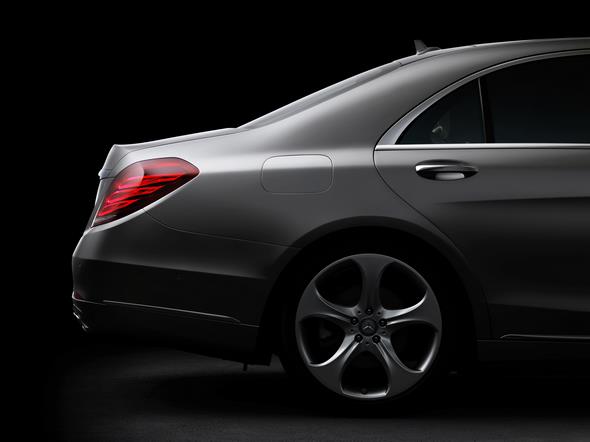
In the Active Body Control system from Mercedes-Benz, the four spring struts are equipped with hydraulic cylinders (plungers) to adjust the force in each spring strut individually.
This means that the system can almost completely compensate for lifting, rolling and pitching of the body.
The control unit receives information on the current driving situation from various acceleration sensors and then compares these data with those from the pressure sensors in the spring struts and the level sensors on the control arms.
The system then computes the control signals for the servo-hydraulic valves at the front and rear axle to ensure precisely metered oil flows.
Once oil flows into the plunger cylinders, this modifies the tracing point of the steel springs integrated into the spring struts, generating the necessary force to counteract the body movements.
Thanks to a constantly available hydraulic pressure of up to 200 bar, ABC is able to stabilise the body within fractions of a second.
The ABC has undergone major modifications for the new S-Class: the wheel damping is now continuously adjustable, the spring strut response has been improved and the pump efficiency has been further enhanced.
A digital interface connects the control unit and the sensors, while the fast FlexRay bus connects the control unit and the vehicle electronics.
Processing power is more than double that of the previous system.
Steering: electro-mechanical Direct-Steer system and steering assistance
The new S-Class comes with an electro-mechanical Direct-Steer system as standard.
As well as a more precise and also more comfortable steering experience, the steering system has a major impact on overall efficiency, since it only requires energy when the vehicle is actually being steered.
In the new steering system, the steering gear and the supporting servo-motor form a single compact unit and are mounted on an extremely rigid and low-weight integral support frame made of aluminium which is positioned in front of the wheel’s centre line.
The steering gear is designed as a Direct-Steer system, which means that the steering ratio becomes noticeably more direct over the steering angle.
This enhances the vehicle’s handling and agility substantially.
The steering assistance function can help to stabilise the vehicle. An assistance steering wheel torque is determined depending on the driving conditions, and this is set accordingly by the electric steering assistance.
The function never overrules the driver but, instead, indicates the direction in which to steer to stabilise the vehicle.
In the event of oversteer, the steering assistance system prompts the driver to countersteer via the steering wheel until the vehicle has stabilised again.
If the vehicle is braked on a road surface with different friction (µ-split) on the left and right, there is a yaw impulse which turns the vehicle in the direction of the high friction.
The steering assistance system prompts the driver to turn the steering wheel in the appropriate direction to compensate for the yaw caused by the different friction.
Brakes: large discs, a wealth of assistance functions
Large brake discs at the front and rear provide the technological basis for safe and reliable deceleration using the ADAPTIVE BRAKE electronic brake control system.
Depending on the engine installed, the disc diameters are up to 370 millimetres at the front and up to 360 millimetres at the rear.
The S-Class features an electric parking brake as standard. A combined floating calliper with electric parking brake function is used on the rear axle.
With the ADAPTIVE BRAKE, the S-Class offers a wealth of assistance functions.
One example of this is the practical HOLD function: after braking to a standstill, briefly pressing the brake pedal a little further is all that is required to activate this function.
The car is then held by the brakes, even if the driver’s foot comes off the brake pedal. The HOLD function is deactivated automatically when the car moves off.
If the driver’s foot moves abruptly from the accelerator to the brake pedal before an emergency stop, the brake system increases the pressure in the brake lines and brings the pads into contact with the brake discs so that maximum braking power is available as soon as the driver hits the brake pedal.
This priming of the brakes allows the system to assist the standard-fit Brake Assist system.
ADAPTIVE BRAKE also has safety benefits in the wet: the system briefly applies the brakes at regular intervals to wipe the film of water from the brake discs and ensure that the brakes are able to perform at their peak.
The finely metered brake pulses are imperceptible to the driver. This automatic brake drying function is always activated when the windscreen wipers have been operating for a certain length of time.
Finally, ADAPTIVE BRAKE assists the driver when starting on an uphill slope.
When the sensors detect that the Saloon has stopped on an uphill slope, Hill Start Assist is activated automatically, briefly holding the brake pressure at a constant level so as to prevent the car from rolling backwards.
The ESP® Dynamic Cornering Assist offers improved safety in critical cornering conditions.
If the ESP® sensors detect an understeering tendency, the ESP® performs specific braking intervention on the side of the vehicle which is on the inside of the bend.
This gives rise to gentle rotary movement of the vehicle around the vertical axis.

Crosswind Assist: strong gusts no longer a scare
Crosswind Assist helps the driver as it can substantially reduce the effect strong crosswinds have on the vehicle’s straight-line stability.
In vehicles without ABC, the negative effect of the crosswind is compensated for by braking on one side of the vehicle activated by ESP® in the ADAPTIVE BRAKE, which is already being used by the Active Lane Keeping Assist/Blind Spot Assist.
In vehicles with ABC suspension, crosswind stabilisation is achieved by means of targeted wheel load changes by adjusting the ABC dampers.
Multimedia features
Communication centre and concert hall
A completely new multimedia generation with intuitive operation and particularly tangible functions thanks to visualisation and animations celebrates its debut in the new S-Class.
Other innovations include the multi-user system, which allows independent access to the media sources of the entertainment system from any seat.
The new S-Class is also the first saloon car to be equipped with the unique Frontbass system as standard.
With this system, the interior space in the bodyshell’s cross-members and side members is used as a resonance chamber for the woofers.
A 3D surround sound system is available on request.
Several hundred developers worldwide contributed to the new Mercedes-Benz multimedia generation, compiling more than 30 million lines of programming.
The centrepiece of the new COMAND Online system is the Intel Atom, a processor whose performance fully equals that of components in the latest laptops.
As a completely new feature, the developers have made the individual functions of the communication systems more tangible with on-screen visualisation and animations (see “Control and display concept” section).
The user is also able to adapt what is shown in the central display to their own requirements.
With the exception of the navigation map (which always fills the complete display area), the central display is divided into a main area (2/3 on the right of the screen) and an additional area (1/3 on the left side of the screen).
In standard configuration the additional area shows supplementary information about the selected main application, e.g. if the radio function is active, the artist and song title are shown, or the current channel in the case of TV.
It is also possible to permanently show preferred contents in the additional area (except when the full navigation map is active).
One can select a small navigation map, fuel consumption display, data connection display or entertainment information, for example.
In addition to this improvement in operating convenience, numerous new functions extend the multimedia options available, and transform the S-Class into a communication centre or a concert hall as required.
The interactive presentation of content is a prominent new feature of the navigation function.
The new navitainment functions include an animated compass, the “Driveshow” for passenger information as in an aircraft, and the display of Google Maps on the head unit and in the rear.
Information on the traffic situation is shown with hatched lines (rather than with vehicle silhouettes as before).
Thanks to real-time traffic information, the navigation system is also better informed about the situation on the roads.
Traffic data are now provided by the “Live Traffic Information” service.
Unlike the previous data sources TMC and TMCpro, whose data are received by radio, “Live Traffic Information” uses a fast internet connection and is therefore particularly up-to-date.
As another new feature, a key word search can be used to enter destinations: only a few letters need to be entered, and the system will automatically display a choice of appropriate town/street combinations and possible points of interest.
The letter combinations or key words can even contain spelling mistakes.
Example: if the driver enters STUT and BAD, the system will suggest ‘Stuttgarter Strasse’ in Bad Friedrichshall, ‘Badstrasse’ in Stuttgart and the ‘Freibad Möhringen’ swimming pool in Stuttgart.
The entered key words are visually highlighted in the display of search results.
In the radio function the favourite stations can now be saved to an individually organised preset list for all wavebands (DAB, FM, AM) rather than to a general autostore function.
Individual stations can then be called up using the favourites function. The “Song tagging” function is likewise useful: songs just played in the vehicle can be flagged and then downloaded to a mobile device via iTunes and the internet connection.
The player is now able to recognise mixed tracks, i.e. video and audio files. Videos are shown as a preview in a small, animated area, and can be enlarged to full-screen format.
The function “Play similar titles” suggests songs similar to the one currently playing, accessing the CD, Music Register or a connected source.
Also new are the Coverflow display, the album cover search and the Picture Viewer as a slideshow.
“Telephone module with Bluetooth®“ is standard equipment with the COMAND Online system.
This supports the connection of the mobile phone to the vehicle via a standardised Bluetooth® interface.
In addition “Convenience telephony” can be ordered as an optional extra by way of a pre-installation using a universal phone interface, whereby the mobile phone can be connected via a cradle in the centre console.
Suitable cradles for various mobile phones are obtainable from Mercedes-Benz Accessories.
“Business telephony in the rear” with a hands-free function is optionally available for passengers in the rear. Connection of the mobile phone to the rear unit is likewise via Bluetooth®.
Pre-installation with a universal phone interface is also possible for the rear. The telephony via the COMAND Online system is networked with the “Business telephony in the rear“.

Calls can therefore be conveniently transferred between the driver and the rear, and functions such as call waiting or conference are also available.
Business telephony is operated via a Bluetooth® handset integrated into the rear and featuring a convenient touch display.
This allows functions such as seat adjustment to be operated intuitively.
The most important new functions at a glance:
| System | Functions |
| COMAND Online | ·WLAN HotSpot integrated into the head unit as standard ·Unrestricted internet browsing ·SMS/email read/write function ·Mercedes-Benz services (e.g. Google search, weather, Facebook, news) ·Internet radio |
| Navigation | ·Navitainment (DriveShow, Google Maps, StreetView) ·Map showing the entire globe possible ·Travelguide and personal POIs ·Display of satellite images ·Optimised 3D navigation with topographical model, photorealistic buildings and map rotation ·Optimised search engine and destination input ·Compilation of four alternative routes ·Download of predefined destinations and routes ·Live Traffic Information |
| Radio | ·Song tagging – flagging of played songs and download via iTunes ·Convenient editing/sorting of the station list ·Station search by station name |
| Player | ·Coverflow display and search by album cover ·Two USB connectors ·Optional Media Interface integrated into the head unit to support mobile devices ·Bluetooth® Audio – wireless music from mobile devices ·Optimised media search engine ·”Play similar titles” ·Reproduction of further audio/video formats ·Display of title information from an internal database and via the internet (Gracenote) ·PictureViewer via SD card/USB |
| Phone | ·Simple Pairing Assist for easy telephone connection via Bluetooth® ·Display of photos stored in the address book possible when a call comes in ·Facility for simultaneous connection of two telephones via Bluetooth® (1st telephone to COMAND Online, 2nd to rear unit) ·Telephone operation by COMAND Online and in the rear if only one phone in the car is connected ·Display of images matching callers, separately stored via COMAND Online ·Placing of telephone calls from other applications ·Control of several telephone calls by call waiting and conference function ·Convenient Bluetooth® handset with touch operation and remote control if rear telephony is specified ·Operation of the system via smartphone/WLAN |
Equal rights for every occupant: the entertainment features
The new S-Class is the first vehicle worldwide to offer a genuine multi-user system with Individual Entertainment System in the rear.
This means that there is independent access to the media sources of the entertainment system from any of the four seats – i.e. radio, TV, internet, navigation, DVD player and USB-connected devices.
The driver control function for all the seats is another new feature. The driver is able to route any audio or video source to the display and headset of any passenger.
At the touch of a button the driver is also able to have one of the audio sources in use played via the onboard loudspeakers.
The multi-user system was technically realised by connecting the COMAND Online system with Individual Entertainment System in the rear via a fibre-optic cable, a so-called MOST bus system (Media Oriented Systems Transport).
Access to the sources from any seat is possible via the MOST ring, which works with a transfer rate of up to 150 Mbit per second.
For the COMAND remote control function, digital radio technology is used for the first time instead of infrared technology.
This makes operation throughout the vehicle possible from any position.
The well-proven SPLITVIEW system for the driver and front passenger has been retained.
The COMAND Online system forms a mixed image from two separate display images (e.g. TV and navigation).
This is then separated in the high-resolution central display by means of prisms, enabling different screen content to be shown for the driver and front passenger depending on the viewing angle.
The driver and front passenger therefore see different images – the passenger can watch television, for example, while the driver is following the navigation instructions.
Together with the DVD changer, headset and Comand Online remote control, SPLITVIEW is part of the “Individual Entertainment” system.
The “Individual Entertainment System in the rear” meanwhile comprises a second DVD player (in the centre console for the five-seater, in the parcel shelf for the four-seater), two high-resolution 10.2-inch displays, radio remote control and two wireless headsets.
With Frontbass and up to 24 loudspeakers: the sound systems
The innovative Frontbass system developed by Mercedes-Benz‑and used for the first time in a saloon car is a feature common to all the audio systems: the woofers are housed in the firewall, and use the almost 40-litre space in the cross-member and side member as a resonance chamber.
Since woofers no longer have to be fitted in the doors, the acoustically disturbing vibrations typical of this configuration are eliminated.
The mid-range speakers in the doors are relocated upwards. This improves the soundscape and allows additional stowage space in the doors.
As alternatives to the standard sound system with ten loudspeakers, two very high-quality audio systems are available which were developed together with the high-end audio specialist Burmester: Burmester® Surround Sound system and Burmester® High-End 3D‑Surround Sound system.
The features of the three sound systems at a glance:
| Standard sound system | Burmester® Surround Sound system | Burmester® High-End 3D Surround Sound system | |
| Loudspeakers (tweeters/mid-range/lower mid-range/Frontbass/ Bassbox) Total | 4/4/0/2/0
10 | 4/7/0/2/0
13 | 9/8/4/2/1
24 |
| Total loudspeaker output | 100 watts | 590 watts | 1540 watts |
| Additional amplifier | – | DSP multi-channel amplifier with nine active channels | 24-channel amplifier, analogue diplexer, additional amplifier for woofer |
| Sound Presets | Surround | Pure/Easy Listening/Live/ Surround/3D-Surround | |
| Specials | Speed-sensitive volume adjustment (SSVA) | Front/Rear sound optimisation Vehicle Noise Compensation (VNC) | 3D Surround Sound VIP Setting Vehicle Noise Compensation (VNC) |
The systematic use of analogue diplexers in the medium and high frequency ranges ensures an extraordinarily expressive and natural sound. Bass, mid-range, treble, volume, balance and fader can be individually adjusted.
The listening experience can be enhanced even further with the Surround function or sound optimisation for the front and rear seats.
Three-dimensional in-car sound: Burmester® High-End 3D Surround Sound system
The optional Burmester® High-End 3D Surround Sound system offers a unique visual and acoustic experience.
The tweeters in the mirror triangles of the front doors are a particular visual highlight.
They rotate through 360° when the head unit is turned on, moving ten millimetres towards the passengers in a spiral motion.
This movement aligns the tweeters to give the optimum sound impression.
This system is also visually distinguishable from the Burmester® Surround Sound system by three overhead speakers and special door speaker covers.
The Burmester® High-End 3D Surround Sound system makes for an outstanding listening experience, with the best possible sound settings for every seat and, for the first time, three-dimensional sound as standard in a luxury saloon car.
This 3D surround sound is created with the help of special Burmester algorithms and three speakers integrated into the headlining.
This combination of analogue and digital technologies produces an extraordinarily expressive and natural sound – the Burmester “feel-good sound”.
If the ambience lighting is switched on, the two tweeters are illuminated in one of the seven available colours.
The same applies to the overhead console, which is also elegantly emphasised by the ambience lighting and accommodates two of the three overhead speakers.
The Burmester® High-End 3D Surround Sound system provides its unrivalled listening experience by virtue of 24 high-performance speakers and 24 separate amplifier channels with a total output of 1540 watts.
At the same time an intelligent combination of analogue and digital amplifier technologies leads to a particularly fine and natural sound together with high performance reserves.
While sophisticated analogue filter settings allow the best possible fine reproduction in the mid-range and treble frequencies, the digital amplifier – despite its compact dimensions – masters the highest dynamic peaks.
The result is outstanding sound resolution and fine acoustic detail, combined with impressive impulse reproduction.
This provides a rounded, warm and substantial sound experience founded on an impressive bass range.
The new, three-dimensional listening experience provided by the 3D Surround Sound system and created by the Burmester speakers integrated into the vehicle roof is unique.
In addition to the two speakers in the overhead console, another speaker is accommodated in the overhead control panel.
A 3D algorithm was developed specifically for the new S-Class‑to create the unique listening experience made possible by these overhead speakers.
The aim of the developers was to add a subtle spatial effect to the outstanding listening experience.
Apart from 3D Surround, four other preset sound modes can be selected to suit every taste and audio source:
- Pure: audiophile sound reproduction with no additional effects, for unadulterated musical enjoyment
- Live: appealing, dynamic sound background akin to live music
- Easy Listening: milder sound background for relaxed listening over longer periods
- Surround: virtual surround sound
- 3D-Surround: three-dimensional listening experience provided by the overhead loudspeakers
Using the so-called VIP setting, the sound quality can be optimised for any of the four seating positions.
This function has been carefully configured for each of the sound modes shown above.
The sophisticated sound compensation (VNC) has also been developed further.
This ensures that the best possible sound impression is maintained despite changes in driving noise.
VNC guarantees maximum listening pleasure at all times – whether on the motorway or in town.
Heritage
S-Class technology milestones
The Mercedes-Benz S-Class and its predecessors have always stood for innovative automotive engineering.
Over the years, they have continually brought new features to the market which have then found widespread acceptance.
Here is a brief overview of the special features in each model series.
Mercedes-Simplex 60 PS (1903 to 1905)
- State-of-the-art high-performance engine: large-displacement
four-cylinder unit with overhead intake valves - Highly efficient honeycomb radiator
- Long wheelbase and low centre of gravity
Mercedes-Benz Nürburg, W 08 (1928 to 1933)
- First series production Mercedes-Benz car with an eight-cylinder engine
- Luxurious and spacious Pullman body
- Overdrive transmission as an option (from 1931, in conjunction with increased displacement)

Mercedes-Benz 770 “Grand Mercedes”, W 07 and W 150 (1930 to 1943)
- First series production Mercedes-Benz car with an eight-cylinder supercharged engine
- Dual ignition system with two spark plugs per cylinder (high-voltage magneto ignition and battery ignition)
- Overdrive transmission (five-speed manual transmission from 1938)
- Oval tubular box frame (from 1938)
- De Dion rear axle (from 1938)

Mercedes-Benz 320, W 142 (1937 to 1942)
- Smooth-running six-cylinder engine
- All-synchromesh four-speed transmission, with remote action gear
from 1939 - Wide range of bodies: saloon, Pullman saloon (with exterior case
from 1939), streamlined saloon, several cabriolets
Mercedes-Benz 300, W 186 and W 189 (1951 to 1962)
- Sophisticated six-cylinder engine with overhead camshaft
- Manually-controlled intake manifold fuel injection (from 1957)
- Patented safety conical-pin locks prevent doors from springing open
in an accident - Electrically-operated torsion bar suspension to compensate the height
of the rear wheels under heavy loads - Heating with blower(s) as standard
- Air conditioning as an option (from 1958)
- Power-assisted steering as an option (from 1958)

Mercedes-Benz 220, W 187 (1951 to 1954)
- Sophisticated six-cylinder engine with overhead camshaft
- Patented safety conical-pin locks prevent doors from springing open
in an accident - Heater with blower as optional equipment

Mercedes-Benz 220 a/220 S/220 SE, W 180/W 128 (1954 to 1959)
- Integral body construction
- Improved spaciousness and comfort thanks to modern unitary structure
- Front suspension subframe
- Single-joint swing axle with low centre of rotation
- Brake drums with “turbocooling”
- Separately adjustable heater and blower as standard for driver
and front passenger - “Hydrak” automatic hydraulic clutch as an option (from 1957)
- Manually-controlled intake manifold fuel injection (220 SE, from 1958)
Mercedes-Benz 220 b to 300 SE/300 SE long, W 111/W 112 (1959 to 1965)
- Safety passenger compartment with crumple zones (front and rear)
- Padded steering wheel and interior appointments designed so as to reduce injury hazards in accidents
- Conical-pin door lock with two safety catches
- Disc brakes (300 SE, from 1961)
- Dual-circuit braking system (from 1963)
- Four-speed automatic transmission (from 1961)
- Air suspension (300 SE, from 1961)
- Long-wheelbase version available (300 SE, from 1963)
- Central locking system as an option (300 SE long-wheelbase)

Mercedes-Benz 600, W 100 (1963 to 1981)
- Powerful, large-displacement V8 engine
- Four-speed automatic transmission
- Dual-circuit braking system with disc brakes
- Air suspension
- Power steering
- Central hydraulic system for seat adjustment, opening and closing doors, windows and luggage compartment
- Electronically-controlled heating and ventilation system
Mercedes-Benz 250 S to 300 SEL 6.3, W 108/W 109 (1965 to 1972)
- Safety steering system (from 1967)
- Hydropneumatic compensator spring at the rear axle
- Air suspension (300 SEL, 300 SEL 6.3, 300 SEL 3.5)
- Top-of-the-range 300 SEL 6.3 model with an output of 250 hp (184 kW), powerful V8 engine and sports-car performance (from 1968)

Mercedes-Benz S-Class model series 116 (1972 to 1980)
- Officially known as the “S-Class” for the first time
- Integral safety concept
- Four-spoke safety steering wheel
- Tank above rear axle to protect it from collisions
- Safety door handles
- Generously sized headlamps and turn signal lamps
- Tail lights with anti-soiling design
- Side windows with anti-soiling measures
- ABS (anti-lock braking system) as an option (from 1978)
- Cruise control as an option (from 1975)
- Double wishbone front axle with zero scrub radius
- Coupled-link axle with anti-squat control (450 SE, 450 SEL,
450 SEL 6.9) - Automatic transmission with torque converter as an option
(standard for 450 SE, 450 SEL, 450 SEL 6.9) - Hydropneumatic suspension with level control (450 SEL 6.9,
from 1975) - First luxury class saloon with a diesel engine, first series production passenger car with a turbo-diesel engine (300 SD, from 1978)
Mercedes-Benz S-Class model series 126 (1979 to 1991)
- Bodyshell with fork-arm structure, the world’s first series-production car to fulfil the criterion of the asymmetric head-on collision (offset crash)
- Low drag coefficient cd = 0.37
- New V8 engines with light-alloy block
- Closed-loop catalytic converter as an option (from 1985) or as standard (from 1986)
- Electrically adjustable steering column as an option (from 1985)
- Driver airbag and belt tensioner for front passenger as an option
(from 1981) - Front passenger airbag (from 1988)
- Automatic locking differential as an option for the six-cylinder models (from 1985)
- ASR (acceleration skid control) as an option for V8 models (from 1985)
- The most successful high-end, luxury Mercedes-Benz saloon
Mercedes-Benz S-Class model series 140 (1991 to 1998)
- Petrol engines with four valves per cylinder and variably adjustable intake camshafts
- First Mercedes-Benz series production car with a twelve-cylinder engine, the brand’s most powerful passenger car engine up to that point (600 SE, 600 SEL)
- Premium-class diesel 300 SD available for the first time on the world markets
- Systematically designed for a high level of recyclability
- Total avoidance of chlorofluorocarbons (CFCs)
- Electronically controlled five-speed automatic transmission
(standard for V8 and V12 models, from 1995) - Speed-sensitive power steering
- Double-glazed side windows for maximum noise comfort
- Automatic climate control with activated charcoal filter and
CO/NOX-sensitive sensors as standard (S 600) or as an option - Electrically folding exterior mirrors
- Power closing for doors and boot lid as an option
- Headlamps with variable-focus reflectors
- Electronics linking via CAN-bus
- Seat belts with automatic height adjustment
- Sidebags for driver and front passenger (from 1996)
- Adaptive Damping System ADS as an option
- Electronic Stability Program ESP® as standard (S 600, from 1995)
or as an option (S 420, S 500, from 1995) - Brake Assist BAS (from 1996)
- PARKTRONIC electronic parking aid as standard (S 600, from 1995)
or as an option (from 1995) - Auto-Pilot-System APS navigation system as an option (from 1995)
- TELE-AID emergency call system as an option (from 1997)
- LINGUATRONIC voice-operated control system as an option
(from 1996) - Xenon headlamps with dynamic headlamp range control as an option (from 1996)

Mercedes-Benz S-Class model series 220 (1998 to 2005)
- Lightweight body with weight-reducing materials mix
(high-tensile steel, light alloy, plastic) - Aluminium crash boxes in the front end and rear structure
- Drag coefficient cd = 0.27
- Automatic cylinder cut-out system as standard (S 600) or as an option (S 500)
- 7G-TRONIC seven-speed automatic transmission with electronic control (S 430, S 500, from 2004)
- AIRMATIC air suspension with electronically controlled Adaptive Damping System
- Active Body Control suspension as an option (standard for S 600)
- Additional turn signal lamps integrated into the exterior mirrors
- Automatic headlamp mode
- COMAND control and display system with dynamic navigation
as an option - Windowbags
- Rear sidebags
- Passenger-side airbag with two-stage gas generator
- Belt tensioners and belt force limiters in the rear
- Laminated glass side windows
- Multi-zone automatic climate control with individual control at each seat depending on the sun’s position
- Luxury seats with ventilation and dynamic multicontour backrest
as an option - DISTRONIC adaptive cruise control as an option
- KEYLESS-GO access and drive authorisation system‑as an option
- Bi-xenon headlamps with dynamic headlamp range control as an option (from 2002, standard on the S 600)
- PRE-SAFE® anticipatory occupant protection‑system (from 2002)
- V8 diesel engine with light-alloy block (S 400 CDI)
- 4MATIC all-wheel drive as an option (S 430, S 500, from 2002)

Mercedes-Benz S-Class model series 221 (2005 to 2013)
- Drag coefficient cd = 0.26
- First car with an Environmental Certificate
- 7G-TRONIC seven-speed automatic transmission with electronic control and DIRECT SELECT steering wheel gearshift
- Active Body Control with crosswind stabilisation as an option
(standard for S 600) - ADAPTIVE BRAKE system
- Adaptive brake lights
- Brake Assist Plus as an option
- Further development of DISTRONIC PLUS adaptive cruise control
(with braking to standstill) as an option - PRE-SAFE® Brake with autonomous partial braking (from 2006) or autonomous emergency braking (from 2009) as an option
- Advanced COMAND system with Controller on the central tunnel
- SPLITVIEW display as an option (from 2009)
- Parking Assist as an option
- Panoramic tilting/sliding sunroof as an option
- Active Night View Assist as an option
- Blind Spot Assist as an option (from 2007, Active Blind Spot Assist
from 2010) - Lane Keeping Assist as an option (from 2009, Active Lane Keeping Assist from 2010)
- Adaptive Highbeam Assist as an option (from 2009)
- Speed Limit Assist as an option (from 2009)
- First luxury class vehicle with hybrid drive and lithium-ion battery
(S 400 HYBRID, from 2009) - First S-Class with a four-cylinder engine (S 250 CDI, from 2010)

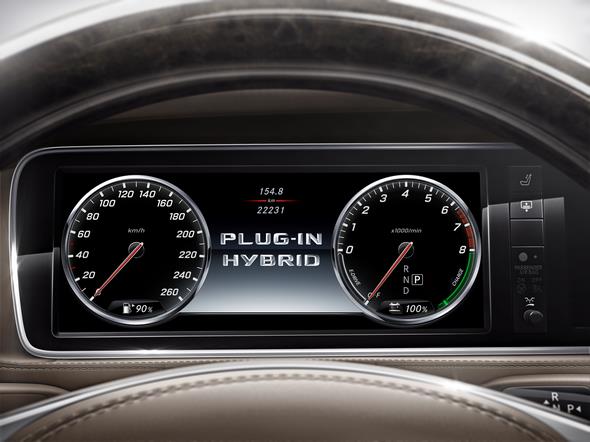
First PLUG-IN HYBRID with a star: S 500 PLUG-IN HYBRID
Efficiency = Performance
The new Mercedes-Benz S 500 PLUG-IN HYBRID blends an ultramodern hybrid drive configuration with the unique innovations and the luxurious equipment and appointments of the S-Class.
The luxury saloon with a long wheelbase impresses with exceptional dynamism and efficiency.
Thanks to standard pre-entry climate control it also offers unique climate comfort. The first certified three-litre luxury saloon in the world is a further milestone on the road to emission-free mobility.
The first S 500 PLUG-IN HYBRID cars go to the customers this month.
“The S 500 PLUG-IN HYBRID is the first luxury saloon with the performance of a V8 and the fuel consumption of a compact model.
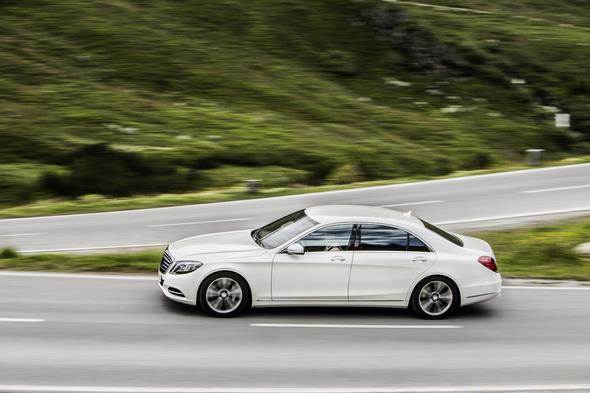
The greatest challenge in this is to translate efficiency into superior performance.
In this respect there is a highly interesting parallel with our successful Formula 1 racing car, which likewise has a turbocharged V6 engine and a high-tech hybrid drive,” says Prof. Dr. Thomas Weber, member of the Daimler Board of Management responsible for Group Research and Mercedes-Benz Cars Development.
“The new S 500 PLUG-IN HYBRID offers our customers the entire range of innovations that make our new S-Class so successful, and thanks to its intelligent operating strategy ensures outstanding driving pleasure and dynamism combined with the highest efficiency.
Moreover, it allows completely emission-free driving for up to 33 km,” adds Ola Källenius, Executive Vice President Sales and Marketing Mercedes-Benz Cars.
The Mercedes-Benz S 500 PLUG-IN HYBRID offers a system output of 325 kW and 650 Nm torque, sprints from 0 to 100 km/h in just 5.2 seconds and can drive up to 33 km purely electrically.
The certified consumption is 2.8 litres/100 km, which corresponds to 65 g CO2/km emissions. Key elements of this impressive output are the V6 biturbo and the intelligent hybrid drive.
Following the S 400 HYBRID and S 300 BlueTEC HYBRID, the S 500 PLUG-IN HYBRID is the third hybrid model in the new S-Class.
Its new high-voltage lithium-ion battery with an energy content of 8.7 kWh can be externally recharged via the charging socket in the right side of the rear bumper.
All three hybrid S-Class models have environmental certificates. These document the models’ environmental performance from development through to recycling, across the entire lifecycle, and the performance is certified to internationally recognised standards by independent experts.
Regarding CO2 emissions the certificate of the S 500 PLUG-IN HYBRID states: “Over the entire lifecycle, comprising manufacture, use over 300,000 kilometres and recycling, clear advantages result compared with the S 500.
External charging with the European electricity mix can cut CO2 emissions by some 43 percent (35 tonnes). Through the use of renewably generated hydroelectricity a 56 percent reduction (46 tonnes) is possible.”
The hybrid transmission is based on the 7G-TRONIC PLUS 7-speed automatic transmission.
The plug-in-hybrid system in the S-Class is based on the Mercedes-Benz parallel hybrid modular system.
The common system-specific feature is the additional clutch integrated between combustion engine and electric motor.
On the one hand, it decouples the combustion engine during purely electric operation; on the other hand, if the combustion engine is employed it affords the possibility to move off drawing on the performance of a wet start-up clutch.
The clutch then substitutes for the torque converter and requires no additional space owing to its complete integration in the torque converter housing.
In order to strengthen the customers’ trust in the new, innovative plug-in drive technology, for the S 500 PLUG-IN HYBRID Mercedes-Benz is for the first time issuing a certificate and thus a promise to perform for the high-voltage battery and plug-in components (e.g. electric motor and power electronics).
This ensures that every technical malfunction within a period of six years after initial delivery or registration, or up to a mileage of 100,000 kilometres, is corrected by Mercedes-Benz.
Haptic accelerator pedal: support for the driver
Climb in, start, drive off and, as well as exemplary efficiency, on request experience via kickdown the special acceleration of the electric motor – this is how easy hybrid driving with the new S 500 PLUG-IN HYBRID is.
For in everyday use it moves just as easily as any other automatic transmission car.
In the background, depending on the chosen operating mode the intelligent operating strategy automatically selects the ideal combination of internal combustion engine and electric motor and in so doing not only adapts its strategy according to the charge status of the battery; it also foresightedly adjusts it according to the traffic or route.
But anyone wanting to can also intervene manually and with the aid of four operating modes and three transmission modes regulate the hybrid interplay themselves.
What is known as the haptic accelerator pedal can signal via a double impulse when drivers should take their foot off the accelerator for sailing and recuperating.
During electric operation it can supply the driver with feedback on the switch-on point of the combustion engine.
The energy flow is shown in all operating states in the instrument cluster and in the central display, if this is selected by the customer.
The technical data at a glance:
| Model | S 500 PLUG-IN HYBRID |
| Internal combustion engine: | |
| Number of cylinders/arrangement | 6/V |
| Mixture formation | High-pressure injection, 2 turbochargers |
| Displacement (cc) | 2996 |
| Rated output (kW/hp at rpm) | 245/333 at 5250-6000 |
| Rated torque (Nm at rpm) | 480 at 1600-4000 |
| Electric motor: | |
| Output (kW) | 85 |
| Torque (Nm) | 340 |
| System output (kW/hp) | 325/442 |
| System torque (Nm)1 | 650 |
| Consumption combined from (l/100 km)2 | 2.8 |
| CO2 emissions combined from (g/km)2 | 65 |
| Efficiency class | A+ |
| Electric range (km) | 33 |
| Charge time 20%-100% (400 V/16 A – 230 V/8 A)3 (h) | 2 – 4.1 |
| Acceleration 0-100 km/h (s) | 5.2 |
| Top speed (km/h)1 | 250 |
| Top speed electric (km/h)1 | 140 |
| Price (euros)4 | 108,944.50 |
Electronically limited, In accordance with NEDC, Charge time at 230 V/8 A e.g. at a commercially available socket.
Through settings on the control element of the charging cable shorter charge times can be realised (standard setting: 8 A), provided that the power supply system is designed for this.
Charge time at 400 V/16 A e.g. at a wallbox. The voltage and current ratings indicated refer to the power supply infrastructure and can be limited by the car.
Sales price in Germany, incl. 19 percent VAT
Extensive standard equipment, extended pre-entry climate control
The standard equipment in the S 500 PLUG-IN HYBRID is extensive and offers a world premiere: the extended pre-entry climate control.
This is target value controlled. meaning that at the start of the journey the S-Class is air conditioned to the preset temperature if the driver has entered the departure time, via Mercedes connect me, for example.
This is possible due to the electrically driven refrigerant compressor and electric heating elements for the heated air.
In addition to this, when preheating it is not just the interior air but also the seats, steering wheel and armrests in the doors and centre console which are heated, and when cooling the seat ventilation is also activated if the respective optional extra is on board.
Also standard in the S 500 PLUG-IN HYBRID, which is only available with a long wheelbase, are for example LED High Performance headlamps and LED tail lights, leather upholstery, COMAND Online, touchpad, THERMOTRONIC automatic climate control plus seat heating also in the rear, Memory package for driver and front passenger, ambient lighting in seven colours and the air suspension AIRMATIC with continuously variable damping system.
The basic safety equipment includes PRE-SAFE®, COLLISION PREVENTION ASSIST PLUS (collision warning including Adaptive Brake Assist), ATTENTION ASSIST, PRE-SAFE® impulse, Crosswind Assist and Traffic Sign Assist (traffic sign recognition incl. wrong-way warning function and display of speed limits in the instrument cluster).
Over and above this a multitude of unique optional extras is available.
The Mercedes-Benz hybrid strategy: emphasis on plug-in drives
Following the S 400 HYBRID and S 300 BlueTEC HYBRID, the S 500 PLUG-IN HYBRID is the third hybrid model in the new S-Class.
The series production launch of this technology began at Mercedes-Benz in 2009. The company is up there among the leaders in the field of purely electric mobility, too.
In the years to come the main emphasis will be on plug-in hybrids.
Hybrid drives, the combination of internal combustion engine and electric drive, help cut overall fuel consumption and boost performance, since the electric drive replaces or supports the combustion engine whenever the engine characteristics are unfavourable — normally in part-load operation when little power is required.
The largest potential for lowering the energy consumption of hybrid drive systems lies in maximising energy recovery during coasting and braking.
Upon depressing the brake pedal the deceleration is initially effected by the electric motor and not by the disc brakes.
The hybrid models of the new S-Class are the first to use a recuperative braking system of the second generation.
It ensures an unnoticeable overlapping of the conventional mechanical brakes and the electric braking performance of the electric motor in generator mode.
Intelligent operating strategy
For efficient operation, foresighted driving, avoiding unnecessary braking and accelerating manoeuvres, has always been the best strategy.

This gains an all new importance in a hybrid model: braking manoeuvres serve not only deceleration, but can also be used to recuperate energy.

And the route has considerable influence on the most efficient charging and discharge of the high-voltage battery.

The intelligent operating strategy supports the driver comprehensively yet unobtrusively to achieve the most efficient driving style.
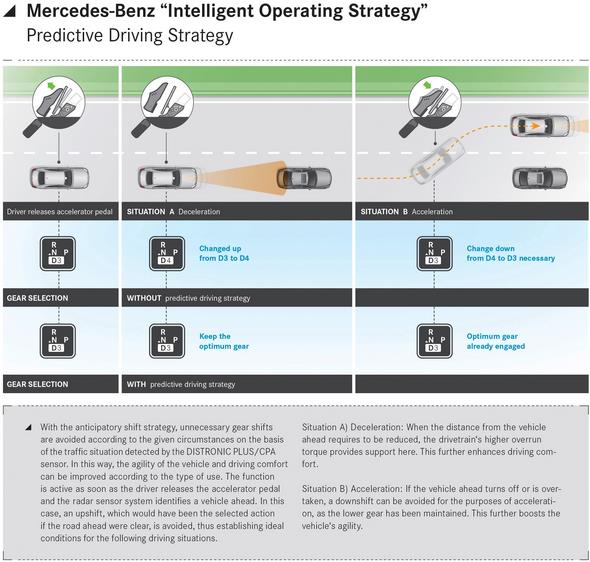
The control strategy, for example, seeks to ensure that the battery, if at all possible, is flat at the end of an uphill stretch so that it can be recharged going downhill.
Another key point is the requirement that urban areas be reached with a fully charged battery, if possible, so that the vehicle can be operated in stop-and-go traffic electrically – frequently and efficiently.
In the S 500 PLUG-IN HYBRID the energy management system basically covers these three areas:
- route-based: automatically or by way of four operating modes
- driver-based: by way of three transmission modes
- traffic-based: with the aid of radar.

Charging: power from a socket
The battery of the S 500 PLUG-IN HYBRID is safely fitted into the rear end of the S-Class to save space.
An intelligent on-board charging system enables the battery to be charged at any conventional household power socket.
The supply of electricity to the car will be made even easier in future through inductive, cableless charging.
The S 500 PLUG-IN HYBRID stores electric energy in a lithium-ion battery on lithium-iron phosphate basis.
The water-cooled energy storage unit has an overall capacity of 8.7 kWh, a total weight of 114 kg and a spatial volume of 96 litres.
To ensure highest levels of crash safety and dynamic handling and also maximum boot space, the housing is made of die-cast aluminium and the high-voltage battery is located in the rear of the vehicle above the rear axle.
The space available there is put to optimal use, and the S 500 PLUG-IN HYBRID thus takes first place among the plug-in hybrids in terms of boot capacity (395 litres) and luggage compartment accessibility.
The high-voltage battery of the S 500 PLUG-IN HYBRID can be charged via external electricity mains using a 3.6 kW on-board charger.
The unit is permanently installed in the vehicle and charges single-phase up to 16 A.
The connection for the charging cable is located under a flap in the rear bumper underneath the tail light on the right-hand side.
An automatic lock ensures that the cable cannot be separated from the vehicle by unauthorised persons.
The new S-Class can be charged in two hours anywhere in the world, e.g. at a wallbox or a charging pole (400 V, 16 A).
Alternatively, charging via house connection is also possible, of course. Depending on the connection a charge time e.g. of two hours and 45 minutes can be attained (with 230 V and 13 A).

Next step: S 500 PLUG-IN HYBRID – unplugged
One of the next steps on the way to the perfect electric vehicle and plug-in hybrid is cableless charging.
Inductive battery charging will make the handling of electric vehicles and plug-in hybrids even more convenient.
Mercedes-Benz will test this “unplugged” technology with the S 500 PLUG-IN HYBRID in order to develop a genuine S-Class solution, in terms of comfort and ease of operation, for the charging of the high-voltage battery.

The history: leadership role in the premium segment
In 1982 Mercedes-Benz presented the first concept vehicle with hybrid drive – a two-cylinder horizontally opposed engine served to charge the battery.
A number of other experimental vehicles followed until in 2009 the world’s first standard-specification hybrid drive with lithium-ion battery debuted at Mercedes-Benz: this S 400 HYBRID was the most fuel-efficient petrol-powered luxury saloon for a long time. And the most successful hybrid in its segment: with around 20,000 buyers.
Based on the 7G-TRONIC PLUS automatic transmission the second-generation hybrid transmission evolved.
It premiered in 2012 in the E 300 BlueTEC HYBRID, the first diesel hybrid in the premium segment worldwide.
By combining the efficiency of a diesel engine with the advantages of the hybrid drive, Mercedes-Benz set another milestone in the development of the automobile and advanced into consumption regions of 4 litres of diesel per 100 km in the luxury saloon segment.
With the C 300 BlueTEC HYBRID Mercedes-Benz has completed its hybrid portfolio below the luxury class.
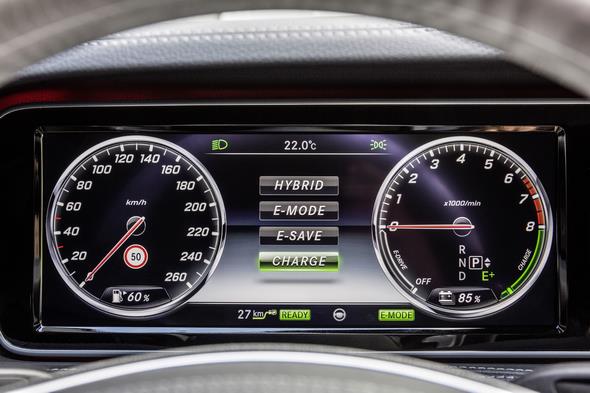
Moreover, in 2014 the B-Class Electric Drive, already on the market in the USA, will also become available in Europe to supplement the hybrid range.
The charge time ranges between 2 hours (400 V/16 A, e.g. at a wallbox) and 4.1 hours
(230 V/8 A, e.g. at a household power outlet).
Through settings on the control element of the charging cable, shorter charge times can be realised even with household power outlets, provided that the power supply system is designed for this.
The voltage and current ratings indicated refer to the power supply infrastructure and can be limited by the car.
All charge times refer to the charging of the battery from 20% to 100%.
Drive system
Efficiency = Performance
The Mercedes-Benz S 500 PLUG-IN HYBRID offers a system output of 325 kW and 650 Nm torque, sprints from 0 to 100 km/h in just 5.2 seconds and can drive up to 33 km purely electrically.
The certified consumption is 2.8 litres/100 km, which corresponds to 65 g CO2/km emissions.
The real-life consumption is also outstanding. Key elements of this impressive output are the V6 biturbo and the intelligent hybrid drive.
“The S 500 PLUG-IN HYBRID is the first luxury saloon with the performance of a V8 and the fuel consumption of a compact model.
The greatest challenge in this is to translate efficiency into superior performance.
In this respect there is a highly interesting parallel with our successful Formula 1 racing car, which likewise has a turbocharged V6 engine and a high-tech hybrid drive,” says Prof. Dr. Thomas Weber, member of the Daimler Board of Management responsible for Group Research and Mercedes-Benz Cars Development.
Hybrid drives, the combination of internal combustion engine and electric drive, help cut overall fuel consumption and boost performance, since the electric drive replaces or supports the combustion engine whenever the engine characteristics are unfavourable – normally in part-load operation when little power is required.
The experience gained with the previous vehicles from Mercedes-Benz has shown that though batteries with a higher energy content permit more frequent electric driving, they provide no added benefit from a consumption viewpoint.
The capacity for braking energy recuperation determines the optimal design of the capacity and energy content of the traction battery.
Recharging by the internal combustion engine cannot compensate for the additional vehicle weight resulting from an oversized battery.
For this reason, in the S 500 PLUG-IN HYBRID Mercedes-Benz combines a high-energy battery with the ability to replenish the energy storage unit via the external electric mains.
The advantages of emission-free electric driving thus are brought ideally into line with the tremendous consumption advantage of the parallel hybrid – and combined with a ride comfort and handling dynamics which meet the highest standards.
And a range that imposes no restrictions whatsoever on the driver.
As with all hybrid vehicles from Mercedes-Benz, the ultraefficient drive system is integrated in the overall vehicle in a way that creates no space restrictions.
Major adjustments to the packaging of the overall vehicle are unnecessary – this is a big advantage for the production of the hybrid vehicles, for example, but it also poses a huge challenge for the development of the electric motor and its integration in the power head of the transmission and for the development of the power electronics and the high-voltage battery.
The hybrid transmission is based on the 7G-TRONIC PLUS 7-speed automatic transmission.
The plug-in hybrid system in the S-Class is based on the Mercedes-Benz parallel hybrid modular system.
The common system-specific feature is the additional clutch integrated between combustion engine and electric motor.
On the one hand, it decouples the combustion engine during purely electric operation; on the other hand, if the combustion engine is employed it affords the possibility to move off drawing on the performance of a wet start-up clutch.
The clutch then substitutes for the torque converter and requires no additional space owing to its complete integration in the torque converter housing.
For the stop phases of the combustion engine the hybrid system has a high-voltage refrigerant compressor, and on the 12 V side an electrically assisted steering, an electric vacuum pump and an electric auxiliary oil pump for the transmission.

Completely integrated: the electric motor
The electric motor of the PLUG-IN HYBRID has been further developed from the previous hybrid vehicles.
The modular design enabled longitudinal scaling from 6 to 9 rotor plate packs. Despite its compact design the electric motor delivers an output of up to 85 kW and torque of up to 340 Nm.
The permanently excited synchronous motor is fully integrated into the hybrid transmission.
Stator and rotor of the internal rotor motor are cooled by transmission oil.
Power electronics and voltage transformer
The high-voltage battery feeds the electric motor through a water-cooled DC/AC converter, the power electronics.
This too is a component from the Mercedes-Benz modular system and was first developed for the technology platform SLS AMG E-CELL, which went into production as the SLS AMG Coupé Electric Drive.
The integration of the power electronics with an electric motor optimised for plug-in operation enables top performance in terms of comfort and output over the entire operating range.
The power electronics operate with a rated voltage of 325 V and supply 350 A maximum current, at the same time determining the position and status of the electric motor by means of a rotor position sensor as well as various component temperatures.
Depending on operating situation, actuation of the electric motor is guided by the rotational speed or the torque, within the permissible limits.
To optimise the effort for wiring, packaging and cooling, the DC/AC converter has been integrated into the engine space.
A separate DC/DC converter at the rear of the vehicle supports the 12 V on-board power supply with an output of up to 3 kW.
With twin turbochargers: the internal combustion engine
For inherent design reasons, electric motors and combustion engines have different torque curves, which can, however, outstandingly complement each other.
An electric motor makes its peak torque available as soon as it starts and can therefore compensate an internal combustion engine’s weak torque in the low rev range.
The electric motor and the V6 biturbo are thus ideal partners in the drive system of the S 500 PLUG-IN HYBRID.
The V6 biturbo with a displacement of three litres comes from the M276 engine family and features the BlueDIRECT injection and combustion system.
Cylinder heads and block are made of aluminium. To reduce friction, the cylinder barrels are coated with the aid of the innovative NANOSLIDE process.
Other engine characteristics include four valves per cylinder, a particularly quiet chain drive system with silent chains and two camshaft adjusters each for the intake and exhaust sides.
The third-generation direct injection system has a fuel pressure of 200 bar and spray-guided multiple injection with piezo injection nozzles.
The on-demand vane-type oil pump cools and lubricates the engine depending on engine load and engine speed.
The volume control distinguishes between a low and a high pressure level and adjusts the volume flow as required.
The weight of the components of the water circuit could be reduced through the systematic use of plastic.
In an extended temperature range the heating supply for the interior is preferentially served.
The desired temperature is thus very quickly reached during the warm-up phase.
An electric heater element ensures rapid warming of the car interior also during electric driving.
The technical data at a glance:
| Model | S 500 PLUG-IN HYBRID |
| Internal combustion engine: | |
| Number of cylinders/arrangement | 6/V |
| Mixture formation | High-pressure injection, 2 turbochargers |
| Displacement (cc) | 2996 |
| Rated output (kW/hp at rpm) | 245/333 at 5250-6000 |
| Rated torque (Nm at rpm) | 480 at 1600-4000 |
| Electric motor: | |
| Output (kW) | 85 |
| Torque (Nm) | 340 |
| System output (kW/hp) | 325/442 |
| System torque (Nm)1 | 650 |
| Consumption combined from (l/100 km)2 | 2.8 |
| CO2 emissions combined from (g/km)2 | 65 |
| Efficiency class | A+ |
| Electric range (km) | 33 |
| Charge time 20%-100% (400 V/16 A – 230 V/8 A)3 (h) | 2 – 4.1 |
| Acceleration 0-100 km/h (s) | 5.2 |
| Top speed (km/h)1 | 250 |
| Top speed electric (km/h)1 | 140 |
| Price (euros)4 | 108,944.50 |
1 Electronically limited, 2 In accordance with NEDC, 3 Charge time at 230 V/8 A, for example at a commercially available socket.
Through settings on the control element of the charging cable shorter charge times can be realised (standard setting: 8 A), provided that the power supply system is designed for this.
Charge time at 400 V/16 A e.g. at a wallbox. The voltage and current ratings indicated refer to the power supply infrastructure and can be limited by the car,
4 Sales price in Germany, incl. 19 percent VAT
Depending on the power requirement and battery charge status, the S 500 PLUG-IN HYBRID drives in purely electric mode.
Moving off from stationary also takes place in electric mode. This “silent start” is part of the exceptional driving experience and perfects the start/stop procedure, e.g. with noiseless starting at traffic lights.
In transmission mode “S” electric driving can be excluded.
If more power is required, the internal combustion engine is started by means of a process developed specifically for hybrid drives with direct-injection petrol engines, and then is quickly and conveniently engaged by actuating the clutch, depending on operating conditions.
The Mercedes-Benz starting procedure combines appropriate actuation of the starter with the ECO start/stop function of direct-injection petrol engines, in which starting is optimised by well-targeted injections and ignitions.
This and the simultaneous actuation of the clutch, with its additional accelerating effect on the starting engine, make an extremely rapid start possible compared with a conventional starting procedure, ensuring a good transition from electric driving.
The internal combustion engine is shut off as often as possible for purely electric driving.
But even so, in combination with the electric motor it delivers a total torque on the level of an eight-cylinder drive when such power is required.
Recuperative braking system: the electric motor as generator
The largest potential for lowering the energy consumption of hybrid drive systems lies in maximising energy recovery during coasting and braking.
Upon depressing the brake pedal the deceleration is initially effected by the electric motor and not by the disc brakes.
The hybrid models of the new S-Class are the first to use a recuperative braking system of the second generation.
It ensures an unnoticeable overlapping of the conventional mechanical brakes and the electric braking performance of the electric motor in generator mode.
The driver’s desired braking power is recorded by a pedal-travel sensor.
The deceleration is dependent on the driving condition and is split into a recuperative brake-force portion and a portion to be supplied by the wheel brakes.
The brake pressure on the rear axle is controlled dependent on the current recuperation potential of the drive system.
In addition, the combustion engine is switched off any time the vehicle is coasting, and its drag torque when rolling is used by the electric motor as recuperation torque.
However, without depressing the brake pedal no additional deceleration torque is provided for charging the battery, and the vehicle can “sail”.
Energy management and operating system
Intelligent operating strategy
Climb in, start, drive off and, as well as exemplary efficiency, on request experience via kickdown the special acceleration of the electric motor – this is how easy hybrid driving with the new S 500 PLUG-IN HYBRID is.
For in everyday use it moves just as easily as any other automatic transmission car.
In the background, the intelligent operating strategy automatically selects the ideal combination of internal combustion engine and electric motor and in so doing not only adapts its strategy according to the charge status of the battery; in transmission mode E+ it also foresightedly adjusts it according to the traffic or route.
But anyone wanting to can also intervene manually and with the aid of four operating modes and three transmission modes regulate the hybrid interplay themselves.
Here, what is known as the haptic accelerator pedal supplies the driver with feedback on the switch-on point of the combustion engine or signals via a double impulse when they should take their foot off the accelerator for sailing and recuperating.
For efficient operation, foresighted driving, avoiding unnecessary braking and accelerating manoeuvres, has always been the best strategy.
This gains an all new importance in a hybrid model: braking manoeuvres serve not only deceleration, but can also be used to recuperate energy.
And the route has considerable influence on the most efficient charging and discharge of the high-voltage battery.
The intelligent operating strategy supports the driver comprehensively yet unobtrusively to achieve the most efficient driving style.
The control strategy, for example, seeks to ensure that the battery, if at all possible, is flat at the end of an uphill stretch so that it can be recharged going downhill.
Another key point is the requirement that urban areas be reached with a fully charged battery, if possible, so that the vehicle can be operated in stop-and-go traffic electrically – frequently and efficiently.
In the S 500 PLUG-IN HYBRID the intelligent operating strategy basically covers these three areas:
- route-based: automatically or by way of four operating modes
- driver-based: by way of three transmission modes
- traffic-based: with the aid of radar.
Four operating modes and three transmission modes
By means of operating mode and transmission mode switches next to the Controller on the centre console it is possible to switch between four operating modes.
A display in the middle of the instrument cluster tells which mode is currently selected. Here an overview of all four operating modes:
- Hybrid: As the name indicates, this standard mode offers hybrid driving, i.e. combines the operation of electric motor and combustion engine. The extent to which the electric motor is used to optimise consumption, or with boost function for especially dynamic acceleration, depends – apart from the customer’s driving style – on the battery charge status and the chosen transmission mode. Three transmission modes are available in this operating mode and can be activated using the transmission mode switch:
- Transmission mode E (Economy) is standard; the electric motor is used for both the benefit of efficiency and for driving pleasure. A power reserve is retained for the electric motor so that maximum additional thrust can be provided.
- In transmission mode E+ (Economy +) the objective is maximum fuel economy; all features of the intelligent operating strategy are active in E+. The greatest possible advantage is taken of the hybrid’s energy efficiency. For example, the vehicle sails as much as possible during coasting, while energy is increasingly recuperated only upon approaching another vehicle travelling ahead. Transmission mode E+ additionally makes use of radar technology – for details see the section below on “traffic-based operating strategy“.
- In transmission mode S (Sport) the sporty features of the drive system dominate. The transmission selects the shift points to benefit agility. This mode does without purely electric driving. The larger amount of electrical energy available because of this is used for the electrically supported boost function.
- E-mode: In this operating mode the S 500 PLUG-IN HYBRID runs purely electrically as much as possible. To ensure that the driver does not inadvertently engage the combustion engine by stepping on the accelerator, the haptic accelerator pedal with pressure point is automatically activated in this mode. The combustion engine engages only when the driver overcomes the pedal’s distinct pressure point.
- E-save: Here the charge status of the battery is preserved as it was when this operating mode was activated. For example, a fully charged battery can be held available if purely electric driving in a big city is on the agenda later. Electric driving in especially favourable situations, for instance after brief stops, is still permitted, but is metered so that the charge status does not fall below the value set by pressing the button.
- Charge: Here the high-voltage battery is charged during vehicle operation with the aid of the internal combustion engine. Electric driving and boost operation are completely dispensed with. Under optimal conditions a run-down high-voltage battery can be fully charged in just about half an hour. As soon as the high-voltage battery is fully charged, the system automatically switches to E-save
Route-based operating strategy
The route-based operating strategy takes the decision for the optimum sequence of operating modes for a route off the driver’s hands.
If the exact destination is known because the relevant data has been entered into the navigation system, charge and discharge of the high-voltage battery are controlled to ensure the optimal use of energy on the overall route, for as much as 1000 kilometres.
One objective is to use the battery’s energy content to drive uphill while recharging the battery through recuperation on the downhill stretch.
The system uses data from the COMAND Online navigation system to calculate the recuperation potential of the road ahead.
For example, the data provides information about the route profile and speed limits ahead in a one-metre grid for up to seven kilometres in advance.
If on the other hand the destination is not known, an assumed route is taken as a basis using likely turn-offs.
In this case the system computes the probability depending on the road category.
If, for example, the hybrid vehicle is travelling on a motorway, the system assumes that it will remain on the motorway for the next seven kilometres.
Traffic-based operating strategy
In transmission mode E+, during electric operation the overrun torque is reduced to a minimum to enable sailing as often and as long as possible.
However, heavy braking after a long sailing phase, or premature sailing resulting in the need to restart the engine, are counterproductive.
Consequently, the system makes use of radar information in bumper-to-bumper traffic in order to get its bearings from the vehicle travelling ahead.
The distance from the vehicle ahead and the speed difference are recognised with the aid of radar sensors.
At exactly the moment when releasing the accelerator pedal would lead to optimally fuel-efficient “docking” onto the vehicle ahead, the driver receives a recommendation, in the form of a noticeable double impulse in the haptic accelerator pedal, to back off the accelerator.
If the driver accepts the recommendation and electric operation is available, the combustion engine is switched off and disconnected from the drive system.
The vehicle then sails. If the vehicle ahead reduces its speed or the gap becomes smaller for some other reason, radar-based overrun torque control sets in.
Increased recuperation by the electric motor correspondingly changes the gap to the vehicle ahead – and recovers energy.
Equipment and appointments
Extended pre-entry climate control
The S 500 PLUG-IN HYBRID blends an ultramodern hybrid drive configuration with the unique innovations and the luxurious equipment and appointments of the S-Class.
The luxury saloon with a long wheelbase not only displays exceptional dynamism and efficiency, it also offers unique climate comfort thanks to comprehensive, standard pre-entry climate control.
The standard equipment in the S 500 PLUG-IN HYBRID offers a world premiere in the extended pre-entry climate control.
Its functions are controlled by target values, meaning that at the start of the journey the S-Class is air conditioned to the preset temperature if the driver has entered the departure time, via Mercedes connect me, for example.
This is possible due to the electrically driven refrigerant compressor and electric heating elements for the heated air.
In addition to this, when preheating it is not just the interior air but also the seats, steering wheel and armrests in the doors and centre console which are heated, and when cooling the seat ventilation is also activated if the respective optional extra is on board.
The standard equipment of the S 500 PLUG-IN HYBRID, which is only available with a long wheelbase, is indeed comprehensive.
Standard features are for example LED High Performance headlamps and LED tail lights, leather upholstery, COMAND Online, touchpad, THERMOTRONIC automatic climate control plus seat heating also in the rear, Memory package for driver and front passenger, ambient lighting in seven colours and the air suspension AIRMATIC with continuously variable damping system.
The basic safety equipment includes PRE-SAFE®, COLLISION PREVENTION ASSIST PLUS (collision warning including Adaptive Brake Assist), ATTENTION ASSIST, PRE‑SAFE® impulse, Crosswind Assist and Traffic Sign Assist (traffic sign recognition incl. wrong-way warning function and display of speed limits in the instrument cluster).
Over and above this a multitude of unique optional extras is available – here is an extract:
- LED Intelligent Light System with variable light distribution for rural roads and motorways, active light function, cornering light function, enhanced fog light function and Adaptive Highbeam Assist Plus
- Head-up Display
- Driving Assistance package Plus including DISTRONIC PLUS with Steering Assist and Stop&Go Pilot, PRE-SAFE® Brake, BAS PLUS with Cross-Traffic Assist, Active Blind Spot Assist, Active Lane Keeping Assist and PRE-SAFE® PLUS, only in conjunction with Parking package including Active Parking Assist
- Night View Assist Plus with early detection of people and large animals in the dark, including spotlight function
- PRE-SAFE® rear package with illuminated seat belt buckle extenders, PRE-SAFE® belt tensioners and beltbags for outer rear seats
- Seat Comfort package for driver and front passenger, comprising: active multicontour seats in the front with dynamic handling function (seat side bolsters are each adjusted via an air chamber) and with ENERGIZING massage function (massage function via 14 air chambers in the seat backrest, massage heating panels in the spinal area), fast-acting seat heating Plus and adjustable lumbar support via three air chambers
- Rear seats electrically adjustable including Memory function comprising: three-seater bench seat with two electrically adjustable outer luxury seats, luxury head restraints with an additional cushion, front passenger seat operable from the rear, two ISOFIX child seat attachment points, two TopTether fastening points, armrest in the rear including double cup holder with wood trim and stowage space
- AIR-BALANCE package including ionisation, improved air filtering and fragrancing
- Warmth Comfort package comprising: heated armrest in the driver’s and front passenger door as well as in the centre console, heated armrest in the rear doors, heated armrest in the centre armrest in the rear in conjunction with electrically adjustable rear seats (optional extra), heated armrest in the business console in conjunction with First-Class rear suite (optional extra), buttons for heating the seats
and armrests in the door control panels in the doors, heated steering wheel - Panoramic sliding sunroof with convenience and automatic rain-sensor closing function, electric sunblind, obstruction sensor plus PRE‑SAFE® closing function
- Burmester® high-end 3D surround sound system with 24 loudspeakers, 24 amplifier channels and a total system output of 1540 watts
- Individual Entertainment System in the rear including two 25.4 cm (10″) displays on the backrest of the driver’s and front passenger seat, DVD player, two radio headphones and COMAND remote control
TV receiver for digital television reception with support from, i.a., multichannel sound, EPG (electronic programme guide) and teletext
High-voltage battery and on-board charger
Power from a socket
The battery of the S 500 PLUG-IN HYBRID is safely fitted into the rear end of the S-Class to save space.
An intelligent on-board charging system enables the battery to be charged at any conventional household power socket.
The supply of electricity to the car will be made even easier in future through inductive, cableless charging.
The S 500 PLUG-IN HYBRID stores electric energy in a lithium-ion battery on lithium-iron phosphate basis.
A modular design with 120 serially connected VDA single cells (22 Ah/cell) supplies rated voltage of 396 V, which can vary between 270 V and 430 V depending on the operating point and consequently is optimally suited for the electric drive.
The water-cooled energy storage unit has an overall capacity of 8.7 kWh, a total weight of 114 kg and a spatial volume of 96 litres.
An energy management system developed by Mercedes-Benz enables the best possible utilisation of the installed capacity, always makes the required output available and simultaneously protects battery life and availability.
To ensure highest levels of crash safety and dynamic handling and also maximum boot space, the housing is made of die-cast aluminium and the high-voltage battery is located in the rear of the vehicle above the rear axle.
The space available there is put to optimal use, and the S 500 PLUG-IN HYBRID thus takes first place among the plug-in hybrids in terms of boot capacity (395 litres) and luggage compartment accessibility.
Owing to the modular design of the battery components, further use of the battery system in other vehicle model series can be easily realised.
Battery charged in around two hours
The high-voltage battery of the S 500 PLUG-IN HYBRID can be charged via external electricity mains using a 3.6 kW on-board charger.
The unit is permanently installed in the vehicle and charges single-phase up to 16 A.
The connection for the charging cable is located under a flap in the rear bumper underneath the tail light on the right-hand side.
An automatic lock ensures that the cable cannot be separated from the vehicle by unauthorised persons.
The new S-Class can be charged in two hours anywhere in the world, e.g. at a wallbox or a charging pole (400 V, 16 A).
Alternatively, charging via house connection is also possible, of course. Depending on the connection a charge time e.g. of two hours and 45 minutes can be attained (with 230 V and 13 A).
The operating data from the charge process and the available output are continuously transmitted to the vehicle’s energy management system, which then controls the charge process.
The on-board charger is located near the battery to ensure the optimal length of connecting cables and cooling water lines.
With its intelligent charge management the new S-Class supports the following functions:
- optimised charging making allowance for customer input, vehicle data and charging infrastructure
- reliable automatic calculation of the purchased energy quantity
- provision and reception of charge-relevant data.
The S 500 PLUG-IN HYBRID is delivered as standard with a four-metre-long spiral charging cable for household power sockets, type E/F (mode 2); on request an eight-metre-long smooth cable is available as an alternative.
Four other, partly spiral charging cables for industrial power sockets, public charging stations and wallboxes are optionally available.
Next step: S 500 PLUG-IN HYBRID – unplugged
One of the next steps on the way to the perfect electric vehicle and plug-in hybrid is cableless charging.
Inductive battery charging makes the handling of electric vehicles and plug-in hybrids even more convenient.
Mercedes-Benz will try out this “unplugged” technology in a test fleet with the S 500 PLUG-IN HYBRID in order to develop a genuine S-Class solution, in terms of comfort and ease of operation, for the charging of the high-voltage battery.
The system is comprised of two components: a secondary coil plus a floor plate with integral primary coil which is placed underneath the car, for example on the garage floor.
The electric energy is transferred without contact, without a charging cable, with an output of 3.6 kW.
The vehicle’s high-voltage battery thus can be charged efficiently, conveniently and safely with an efficiency factor of more than 90 percent.
The charge time ranges between 2 hours (400 V/16 A, e.g. at a wallbox) and 4.1 hours (230 V/8 A, e.g. at a household power outlet).
Through settings on the control element of the charging cable, shorter charge times than 4.1 hours can be realised even with household power outlets, provided that the power supply system is designed for this.
The voltage and current ratings indicated refer to the power supply infrastructure and can be limited by the car.
All charge times refer to the charging of the battery from 20% to 100%.
Country-specific, depending on market conditions
Hybrid strategy
Leadership in the electrification of the premium segment
Following the S 400 HYBRID and S 300 BlueTEC HYBRID the S 500 PLUG‑IN HYBRID is the third hybrid model in the new S-class.
The series production launch of this technology began at Mercedes-Benz in 2009.
In 2014 Mercedes-Benz will sell more hybrid automobiles than all other German manufacturers together.
The company is up there among the leaders in the field of purely electric mobility, too.
In the years to come the main emphasis will be on plug-in hybrids.
In 1982 Mercedes-Benz presented the first concept vehicle with hybrid drive – a two-cylinder horizontally opposed engine served to charge the battery.
A number of other experimental vehicles followed until in 2009 the world’s first standard-specification hybrid drive with lithium-ion battery debuted at Mercedes-Benz: this S 400 HYBRID was the most fuel-efficient petrol-powered luxury saloon for a long time.
And the most successful hybrid in its segment: some 20,000 buyers worldwide opted for the S 400 HYBRID from the previous model series.
In addition to the parallel hybrid transmission of the first generation a power-split hybrid transmission was developed.
The ML 450 HYBRID started out on the American market with this transmission in 2009.
Based on the 7G-TRONIC PLUS automatic transmission the second-generation hybrid transmission evolved.
It premiered in 2012 in the E 300 BlueTEC HYBRID, the first diesel hybrid in the premium segment worldwide.
By combining the efficiency of a diesel engine with the advantages of the hybrid drive, Mercedes-Benz set another milestone in the development of the automobile and advanced into consumption regions of 4 litres of diesel per 100 km in the luxury saloon segment.
Again in 2012, in the E 400 HYBRID, and in 2013 in the new S 400 HYBRID, Mercedes-Benz carried on the tradition of hybrids with six-cylinder direct injection petrol engines, and in 2013 also put the second diesel hybrid, the S 300 BlueTEC HYBRID, on the market.
With the C 300 BlueTEC HYBRID Mercedes-Benz has completed its hybrid portfolio below the luxury class.
In the years to come a number of other plug-in hybrid vehicles will follow.

Pioneer also in the field of purely electric mobility
With the smart fortwo electric drive and the Mercedes-Benz SLS AMG Coupé Electric Drive, Daimler AG is a pioneer in the field of purely electric mobility as well.
Since 2014 the B-Class Electric Drive has also been on the market. Quiet, locally emission-free motoring is ensured by an electric motor generating 130 kW.
Typically for an electric drive system, this develops its maximum torque of more than 340 newton metres from the very first touch of the accelerator.
This is approximately equivalent to the torque from a modern three-litre naturally aspirated petrol engine.
The result is noticeably powerful acceleration from stationary. For the standard sprint from zero to 100 km/h, too, the electrically driven B-Class requires only 7.9 seconds.
Effortlessly superior driveability and exhilarating driving pleasure with a high level of dynamism are thus guaranteed in every situation.
In the interests of optimising the range, the top speed is electronically limited to 160 km/h.
Depending on the driving cycle, the vehicle has a range of around 200 kilometres.
The electric vehicles and hybrids share the electric drive components from the Mercedes-Benz modular system.
Current range of hybrids in the luxury class
With the new S-Class Mercedes-Benz now continues its comprehensive hybrid offensive.
The S 400 HYBRID and S 300 BlueTEC HYBRID are two further hybrids, in addition to the S 500 PLUG-IN HYBRID:
- The S 400 HYBRID burns just 6.3 litres of fuel per 100 kilometres in the NEDC cycle (combined). This represents a reduction by 20 percent over the predecessor. CO2 emissions of 147 grams per kilometre is also a record in this vehicle segment. These exemplary figures go hand in hand with outstanding performance potential: the petrol engine develops 225 kW (306 hp), while the electric motor adds another 20 kW (27 hp). The torque of the combustion engine is 370 Nm plus 250 Nm from the electric motor.
- In the S 300 BlueTEC HYBRID Mercedes-Benz has combined the 2.2‑litre four-cylinder diesel engine developing 150 kW (204 hp) with the powerful hybrid module developing 20 kW (27 hp). The peak torque of 500 Nm produced by the combustion engine is overlaid by the 250 Nm of peak torque produced by the electric motor. The S 300 BlueTEC HYBRID makes do with 4.4 litres per 100 km in the combined cycle (CO2: 115 g/km), and complies with the criteria for energy efficiency class A+. Consequently, Mercedes-Benz has nearly cut fuel consumption in the 150-kW performance class by half over the course of ten years.
All hybrid drive milestones at a glance:
Research vehicles
- 1982: Mercedes-Benz concept employs a two-cylinder horizontally opposed engine
- 1993: Mercedes-Benz “Taxi Hybrid” as first parallel hybrid. A
C-Class combines a 55 kW (75 hp) four-cylinder diesel engine with an electric motor delivering 130 Nm and 20 kW (27 hp) - 2001: smart fortwo cdi. A 20 kW (27 hp) electric motor together with the 30 kW (41 hp) three-cylinder diesel engine forms a truly space-saving unit
- 2002: Mercedes-Benz Unimog “E-Drive”
- 2002: Mercedes-Benz M-Class “HyPer”. ML 270 CDI with a 120 kW (163 hp) common-rail diesel engine and automated manual transmission. It features an electric motor with an output of 45 kW (61 hp) and high torque, installed between the engine and the transmission
- 2003: Mercedes-Benz F 500 Mind. The four-litre V8 diesel power plant delivers 178 kW (242 hp) and 560 Nm. The electric motor adds another 48 kW (65 hp) and 300 Nm. The company showed the same drive system in the Mercedes-Benz Vision Grand Sports Tourer vehicle study
- 2004: Mercedes-Benz Sprinter with plug-in-hybrid drive
- 2005: Mercedes-Benz S-Class “Hybrid”. Eight-cylinder diesel engine developing 191 kW (260 hp) and 560 Nm, plus two electric motors with a total output of 50 kW (68 hp)
- 2005: smart crosstown. Hybrid with three-cylinder petrol engine (45 kW) and electric motor (23 kW)
In the dealerships from March 2014
Four new S-Class models
Stuttgart. Mercedes-Benz is extending the model range of the successfully launched S-Class with the particularly economical S 300 BlueTEC HYBRID, the high-traction S 350 BlueTEC 4MATIC, the luxurious S 600 flagship model and the S 65 AMG, which is the dynamic top performer in the segment.
The new models can be ordered with immediate effect, and will be in dealer showrooms in March 2014.
Just a short time after the model changeover, the new S-Class has already taken the top sales position in its segment worldwide.
Now Mercedes-Benz is extending the range with the particularly economical S 300 BlueTEC HYBRID, the luxurious S 600 flagship model and the high-performance S 65 AMG Saloon.
With combinations of short and long wheelbases, rear-wheel drive and 4MATIC, the S-Class range now therefore boasts 16 versions only months after the market launch.
New optional extras are also available in the form of the head-up display (from €1201.90), heated windscreen (from €499.80) and touchpad (€178.50).
Two new designo interiors in satin beige/titanium grey pearl or satin beige/satin red pearl are optionally available to bring colour into the interior (each costing €3629.50 or €892.50 for AMG models).
COLLISION PREVENTION ASSIST now provides protection against typical rear-end collisions in dangerous traffic situations from 7 km/h (previously: above 30 km/h).
Following the successful launch of the S 400 HYBRID, the second hybrid model in the Mercedes-Benz S-Class is now entering the market: The S 300 BlueTEC HYBRID makes do with 4.4 litres of diesel per 100 km in the combined cycle (CO2: 115 g/km), and complies with the criteria for energy efficiency class A+.
This means that over the course of ten years, Mercedes-Benz has cut fuel consumption in the 150 kW performance class by almost half.
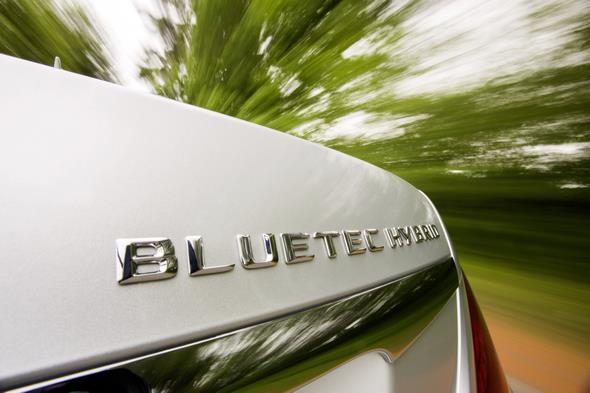
In the S 300 BlueTEC HYBRID, Mercedes-Benz has combined the 2.2-litre four-cylinder diesel engine developing 150 kW (204 hp) with a powerful hybrid module.
Its 20 kW electric motor is positioned between the internal combustion engine and the automatic transmission.
It assists the diesel engine when the car is accelerating (boost effect) and, in alternator mode, is used for the recuperation of braking energy, although driving under electric power alone is also possible.
The S 300 BlueTEC HYBRID is available with either a short or long wheelbase. Prices: €80,920 and €86,453.50 (recommended retail price including 19% VAT for Germany).
One of the world’s most economical V6 diesels is now also available with
all-wheel drive: the S 350 BlueTEC 4MATIC develops an output of 190 kW (258 hp) and 620 Nm of torque from a displacement of 2987 cc.
With a combined fuel consumption of 5.9 litres of diesel per 100 kilometres (both with short and long wheelbase), it achieves the same level as the preceding four-cylinder model S 250 CDI.
The S 350 BlueTEC 4MATIC with the second-generation AdBlue® emission control system costs €84,728 and €90,261.50 respectively.
The S 600 is the new flagship model in the S-Class, available only with a long wheelbase and luxurious appointments.
With an output of 390 kW (530 hp), its V12 biturbo engine develops even more output than its predecessor rated at 380 kW (517 hp).
The displacement of the engine has increased from 5513 to 5980 cc. Maximum torque is 830 Nm from 1900 rpm.
The extensive standard appointments of the S 600 (available from €164,279.50) underline its flagship status.
The LED Intelligent Light System, the MAGIC BODY CONTROL suspension with ROAD SURFACE SCAN and the Driving Assistance package Plus all come as standard, for example.
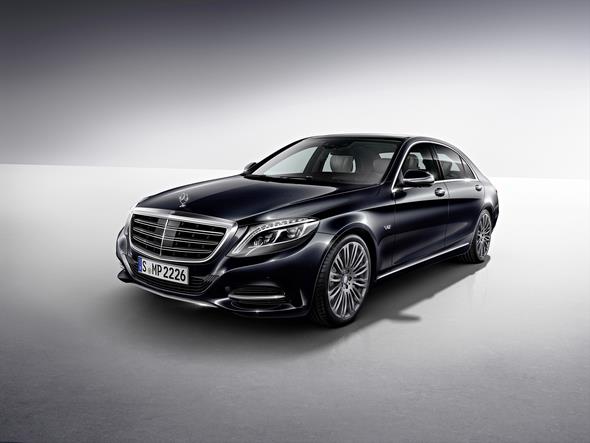
The Mercedes-Benz S 65 AMG is the only high-performance 12-cylinder automobile from a German premium manufacturer – and is a car with a pedigree: the first generation of the S 65 AMG was launched in 2003, while the second generation was produced from 2006 until 2013.
The new Mercedes-Benz S 65 AMG once again sets new standards as the most powerful car in this competitive segment.
Twelve cylinders, biturbocharging, an output of 463 kW (630 hp) and torque of 1000 Nm ensure outstanding performance and effortless dynamism.
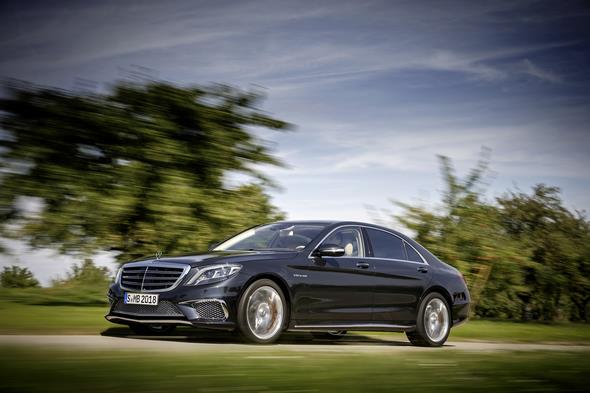
Compared with the previous model, fuel consumption has been reduced by 2.4 litres per 100 kilometres (NEDC combined).
The AMG sports suspension based on MAGIC BODY CONTROL features ROAD SURFACE SCAN as standard.
Like the preceding model, the new S 65 AMG is available only with a long wheelbase; the price for Germany (incl. 19% VAT) is €234,906.
An overview of the new models and prices:
| Model | S 300 BlueTEC HYBRID1 | S 350 BlueTEC 4MATIC1 | S 600 | S 65 AMG |
| Number of cylinders/arrangement | 4 in-line | 6/V | 12/V | 12/V |
| Displacement (cc) | 2143 | 2987 | 5980 | 5980 |
| Rated power (kW/hp at rpm) | 150/204 at 4200 | 190/258 at 3600 | 390/530 at 4900-5300 | 463/630 at 4800-5400 |
| Rated output of electric motor (kW/hp) | 20/27 | – | – | – |
| Rated torque (Nm at rpm) | 500 at 1600-1800 | 620 at 1600-2400 | 830 at 1900-4000 | 1000 at 2300-4300 |
| Rated torque of electric motor (Nm) | 250 | – | – | – |
| Combined fuel consumption from (l/100 km) | 4.4 D | 5.9 D | 11.1 SP | 11.9 SP |
| Combined CO2 emissions from (g/km) | 115 | 156 | 259 | 279 |
| Efficiency class | A+ | A | F | F |
| Acceleration 0-100 km/h (s) | 7.6 | 6.8 | 4.6 | 4.3 |
| Top speed (km/h) | 240 | 250 | 250 | 250 |
| Price (euros)2 | 80,920/ 86,453.50 | 84,728/ 90,261.50 | 164,279.50 | 234,906.00 |
1 Short/long wheelbase, 2 Selling price in Germany, incl. 19% VAT
2009: Concept BlueZERO in three versions: as electric car (E-CELL), as fuel cell-powered vehicle (F-CELL) and with range extender (E-CELL PLUS)
Spyimages and videos for your entertainment
Real facts and the official photos about the W222 will enter here as soon as i hear them.
Bookmark this page and keep watching it..
Official sources says 2013 05 15 will be the day when they lets us see the miracle…

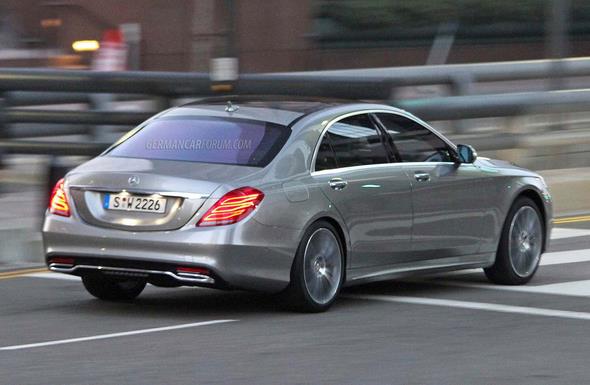
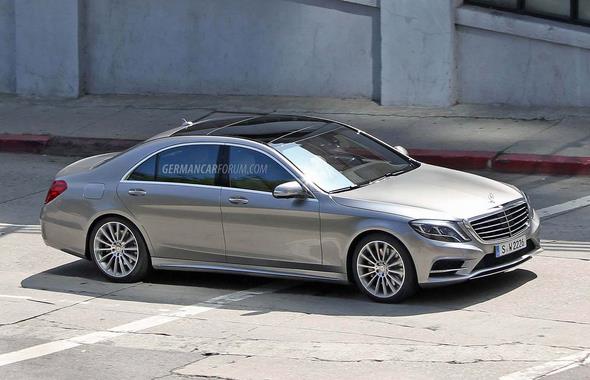

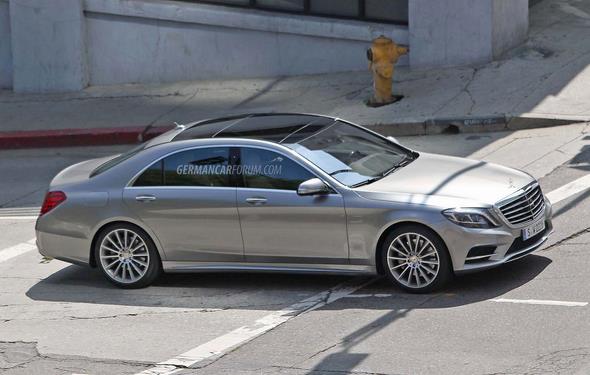
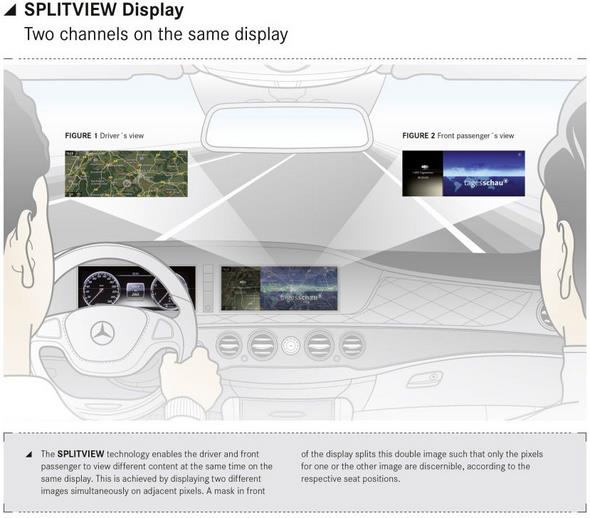
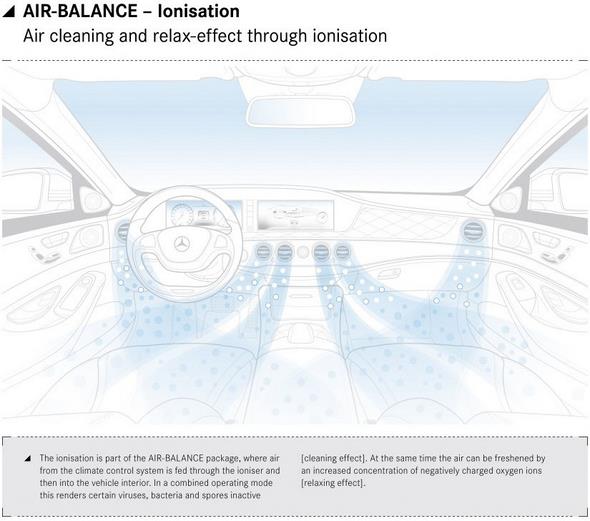

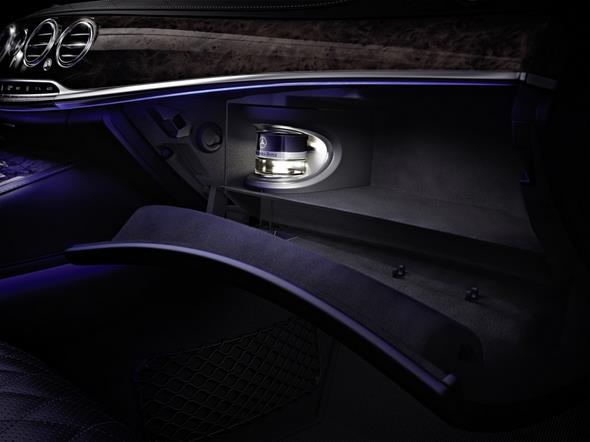



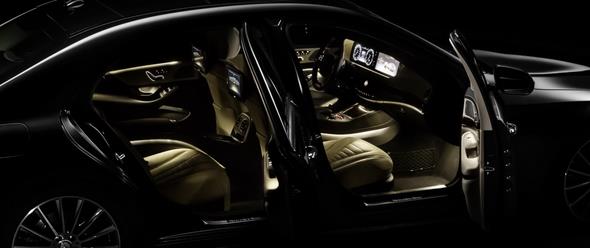
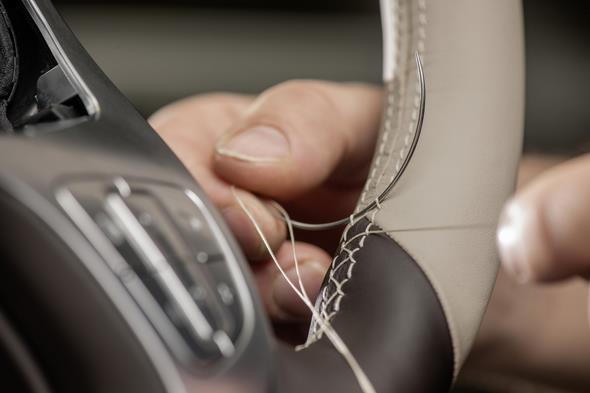

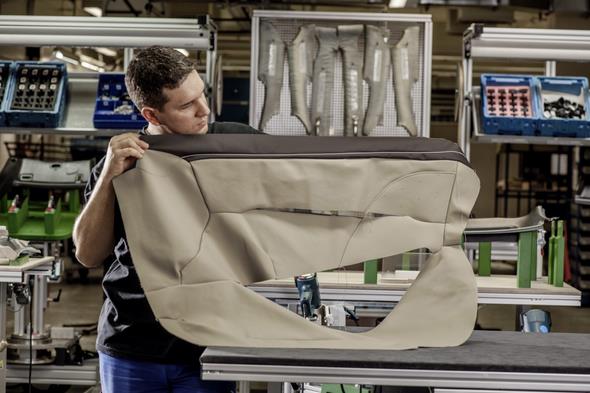


________________ Added 121107 _____________________________________________


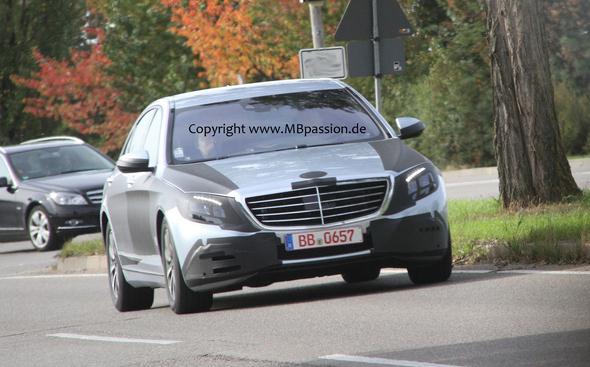





_________________________________________________________________________















![2014-Mercedes-S-CLass-AMG-0004[3]](/wp-content/uploads/2012/10/2014-Mercedes-S-CLass-AMG-000431.jpg)









